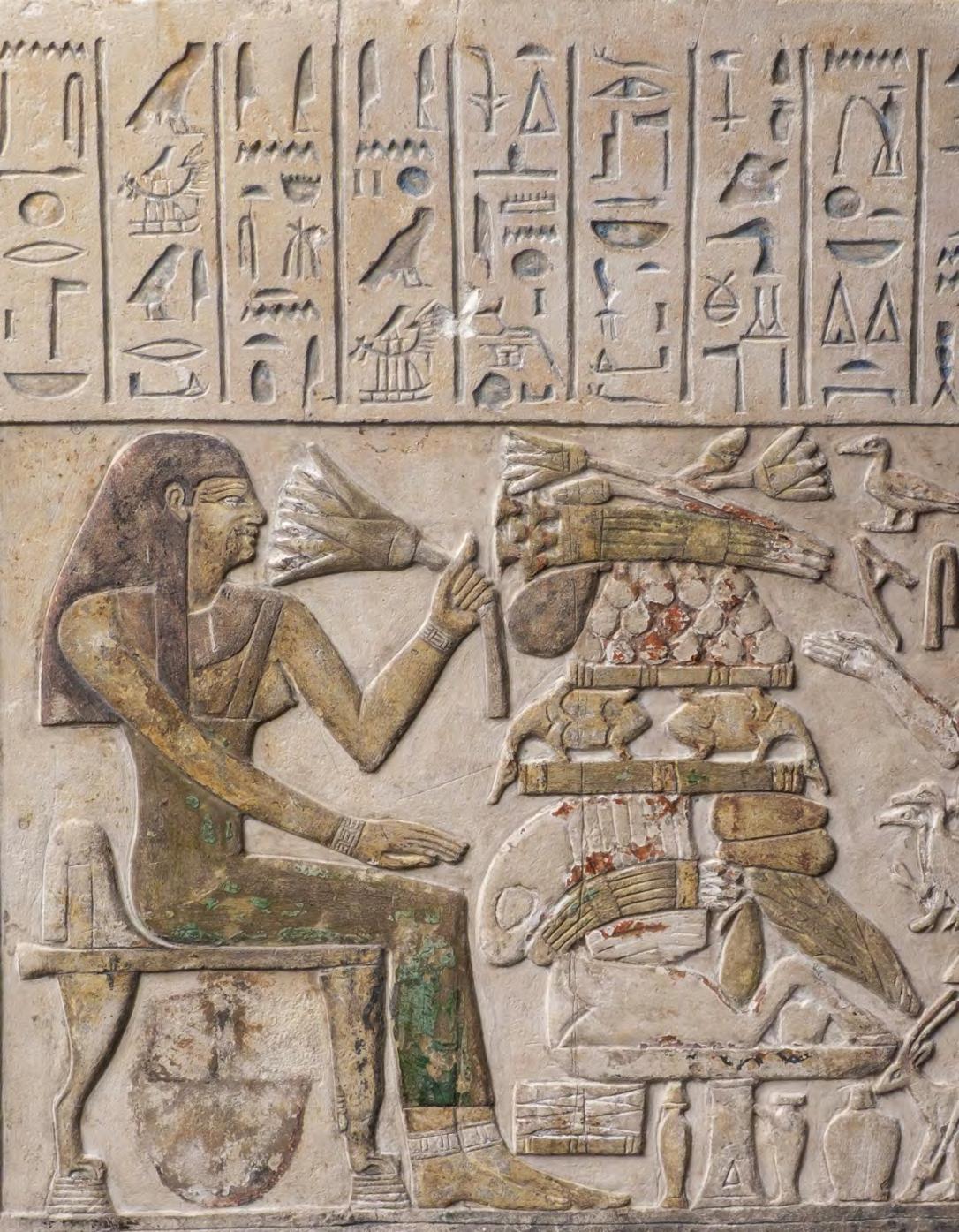Antiques & Historic Textiles
17 JULY 2025


17 JULY 2025


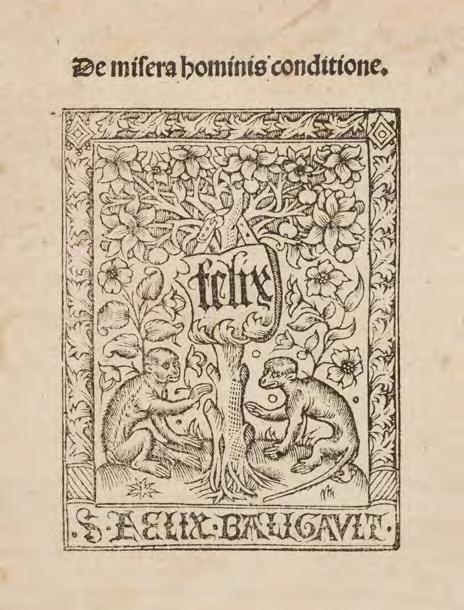
Gaguinus (Robertus). De misera hominis conditione, [Paris]: Félix Baligault, c. 1495, 6 leaves, printer’s woodcut device on title, gothic letter (preface) and batarde letter (text), 40 and 30 lines to the page, a little spotting and soiling, single wormhole running throughout, armorial bookplate of Marcus de Lavis-Trafford, early 20th-century green quarter roan over plain boards, gilt-titled spine, joints rubbed with small loss at head of spine, boards toned, 4to (295 x 135 mm)
Provenance: Marcus de Lavis-Trafford (1880-1960), archaeologist, physician and pioneer of winter sports in the French Alps. Copinger II, 2617; GW 10464; ISTC ig00017800; Pellechet 4967.
Robert Gaguin (1433/34-1501), noted French Renaissance humanist and philosopher, and minister general of the Trinitarian Order. This is the first edition of his poem on the miseries of human life, and the only edition printed in the fifteenth century. His History of France was first published in 1497.
Only one other complete copy has been located, held at the Bibliothèque de Sainte-Geneviève in Paris; and one imperfect copy, held at Biblioteca do Palácio Nacional da Ajuda, Lisbon.
Estimate: £1,500-2,000
For further information and to consign, please contact: Colin Meays | colin@dominicwinter.co.uk
17 July 2025 at 10am
VIEWING Monday & Tuesday 14/15 July 9.30am-5.30pm Sale mornings from 9am (other times by appointment)
AUCTIONEERS
Henry Headows
Light refreshments available on view days with extra lunch options on sale days

Mallard House, Broadway Lane, South Cerney, Cirencester, Gloucestershire, GL7 5UQ
T: +44 (0) 1285 860006
E: info@dominicwinter.co.uk www.dominicwinter.co.uk




Condition reports now including video conferencing can be requested in the following ways: T: +44 (0)1285 860006 | E: info@dominicwinter.co.uk
Via the relevant lot page on our website www.dominicwinter.co.uk
Lots marked with AR next to the lot number may be subject to Droit de Suite. Droit de Suite is payable on the hammer price of any artwork sold in the lifetime of the artist, or within 70 years of the artist's death. The buyer agrees to pay Dominic Winter Auctioneers Ltd. an amount equal to the resale royalty and we will pay such amount to the artist's collecting agent. Resale royalty applies where the Hammer price is 1,000 Euros or more and the amount cannot be more than 12,500 Euros per lot.
The amount is calculated as follows: Royalty For the Portion of the Hammer Price (in Euros)
4.00% up to 50,000
3.00% between 50,000.01 and 200,000
1.00% between 200,000.01 and 350,000
0.50% between 350,000.01 and 500,000
Invoices will, as usual, be issued in Pounds Sterling. For the purposes of calculating the resale royalty the Pounds Sterling/Euro rate of exchange will be the European Central Bank reference rate on the day of the sale.
Please refer to the DACS website www.dacs.org.uk and the Artists’ Collecting Society website www.artistscollectingsociety.org for further details.
For payment arrangements please refer to information for buyers at rear of this catalogue. We would kindly request that commission bids are submitted by 9.30am on the morning of sale.
Customers may submit commission bids or request to bid by telephone in the following ways: T: +44 (0)1285 860006. |. E: info@dominicwinter.co.uk
Via the relevant lot page on our website www.dominicwinter.co.uk
Live online bidding is available on our website www.dominicwinter.co.uk (surcharge of 3% + vat): a live bidding button will appear 30 minutes before the sale commences. Bidding is also available at the-saleroom.com (surcharge of 4.95% + vat) and invaluable.com (surcharge of 3% + vat).

For payment information see our Information for Buyers page at the rear of this catalogue. For details regarding storage, collection, and delivery please see our Information for Buyers page or contact our office for advice. Successful bidders will not incur storage fees while current government restrictions remain in place.
If you intend to export goods you must find out in advance if:
a. there is a prohibition on exporting goods of that character e.g. if the goods contain prohibited materials such as ivory.
b. if they require an Export Licence on the grounds of exceeding a specific age and/or monetary value threshold as set by the Export Licensing Unit. We are happy to offer the submission of necessary applications on behalf of our buyers but we will charge for this service to cover the costs of our time. The typical cost of an application is £50 + VAT, but this price cannot be guaranteed or fixed.
c. CITES permits: These documents may be required to ship some lots (e.g. ivory) out of the UK. Your shipper (DHL Express or other) can advise and apply for these on your behalf. It is the buyer's responsibility to ensure that the shipment is lawfully exported out of the selling location and can be lawfully imported to the country of destination.
All lots are offered subject to the Conditions of Sale and Business printed at the back of this catalogue. For full terms and conditions of sale please see our website or contact the auction office. A buyer’s premium of 22% of the hammer price is payable by the buyers of all lots, except those marked with an asterisk, in which case the buyer’s premium is 26.4%.
Collectables 556-602
Silverware 603-619
Jewellery 620-629



Antiques & Historic Textiles
Meadows BA Hons, MRICS

Cover illustrations: Front cover: lot 534 | Back cover: lot 505
Catalogue Produced by Jamm Design Ltd. - 020 7459 4749 info@jammdesign.co.uk
Photography by Darren Ball - 07593 024858 darrenball1989@gmail.com
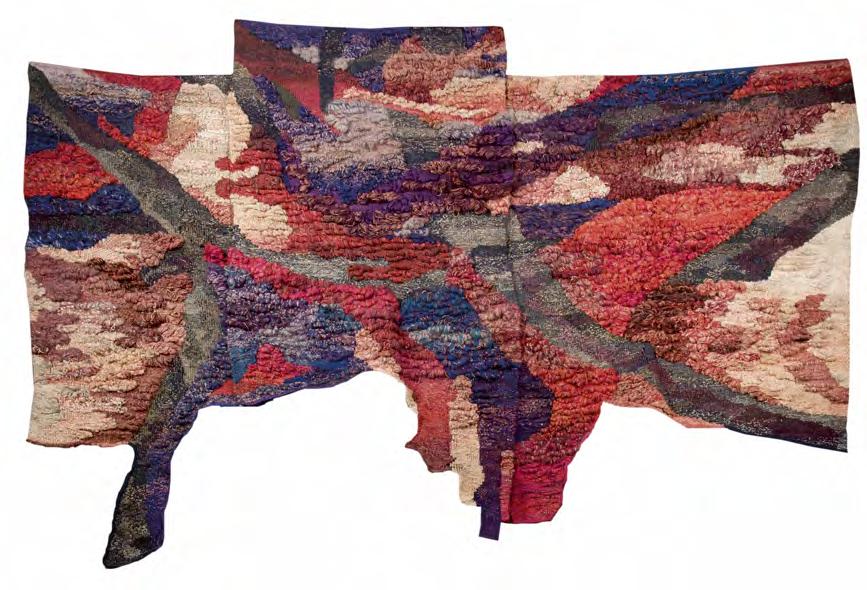
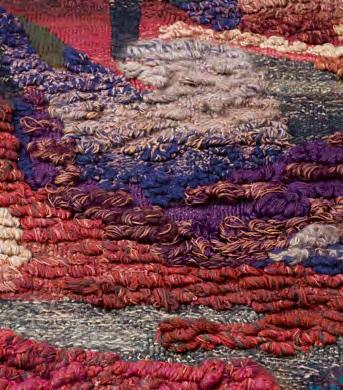
411* Abramson (Elda, born 1944). A large wall hanging, mid 1980s, woven in polychrome wool in three parts, overall size approximately 4 m wide x 1.5 m high (lower hem uneven)
Provenance: Commissioned by the owner.
Painter and textile artist Elda Abramson was born in England and trained in America. She specialises in weaving large textural works, often inspired by the vivid colours of nature, as in the example offered here. The artist has woven tapestries for the Royal Northern College of Music, and for the Duchess of Westminster, and undertaken numerous other public and private commissions. She has exhibited at the Royal Academy and her work is in the Arts Council collection.
(3)
£300 - £500
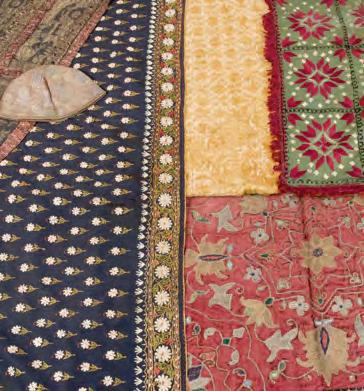
412* Asian. A collection of textiles, 19th-mid 20th century, including: a large yellow cloth and a large yellow runner similar, both hand-worked all over with various patterns and motifs in chain stitch (Aghabani embroidery?); a large linen curtain pieced from a suzani; a small square suzani; an Indian appliquéd and embroidered square velvet panel incorporating metallic threads; a tunic with gold metallic threadwork and tassels; an Indian child’s embroidered tunic and hat; a large piece of dark blue silk (portion of a sari?), hand-embroidered with all-over pattern of flower sprigs, with floral border to one long edge; and a crimson sari, labelled ‘“King’s shawl”, Delhi’, various condition and sizes
The ‘King’s shawl’, and possibly some of the other items in this lot, were purchased by the owner’s grandfather, a Major in the Royal Army Medical Corps, and his wife. The couple married in India in 1915, and the vendor’s father was born there in 1916. They were both interested in textiles, collecting rugs, embroideries, and other such items.
(21)
£300 - £500
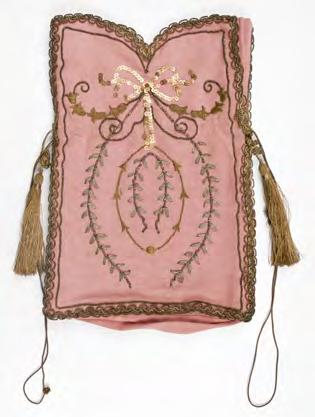
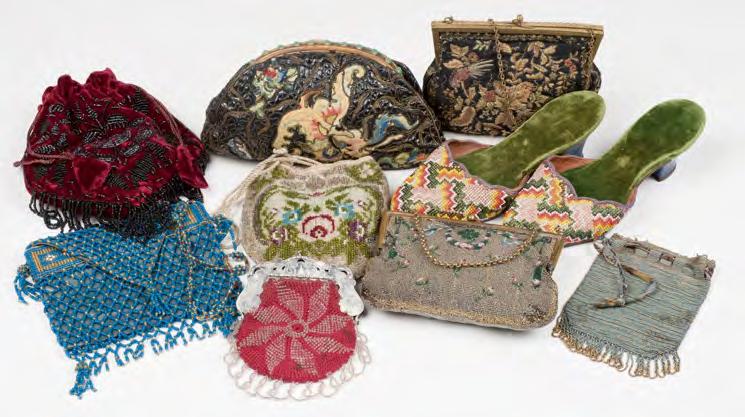
413* Bag. A metalwork Regency reticule, circa 1810, pink moiré grosgrain bag, hand-worked to front in metallised silver and gold threads, beads, and spangles, with foliate swags hanging from a bow, metallised gilt braid to edges, gold twisted cord drawstring and a gold tassel to each side, a few small areas a trifle dustsoiled, lined with cream silk, 26 x 18 cm (10.25 x 7 ins), together with 5 other bags, comprising: 2 black velvet evening clutch bags heavily embroidered with silver metalwork; a green leather clutch with Ottoman-style gold metalwork embroidery; a quilted brown satin bag with faux tortoiseshell mount, lined with peach satin; and a large pale turquoise satin bag, one side appliquéd with flowers and embroidered overall with undulating chain stitch lines in gold metallic thread, the painted wooden handles with découpage flowers, plus 6 pairs of ladies’ leather gloves (and 2 odd gloves) A very attractive Regency reticule in unusually good condition. (14) £200 - £300
414* Bags. A collection of 14 bags & purses, early 20th century, including: a Chinese bag with coloured silk and metallised thread embroidery, the filigree yellow metal mount set with green glass cabochons; another bag embroidered with silk and metallised threads, depicting exotic birds amongst flowers, leaves, and grapes, with yellow metal filigree mount and chain; 9 beaded bags, including a beaded red knitted purse on an engraved Dutch silver mount, hallmarked 1925, and engraved inside with the initials ‘D.N.’, and a bag with the design of a shamrock within a garland; and a chain mail purse of Alpacca silver (with stamp on inside of white metal mount), together with other 19th and early 20th century items: a pair of heeled beaded mules lined with moss green velvet, length 22 cm (8.5 ins), width 8.5 cm (3.25 ins); an Edwardian straw boater, maker’s ink stamp on silk lining rubbed and indistinct; a beaded black net bonnet trimmed with silk bows; a pair of black knitted cuffs embellished with cut steel beads; a pair of yellow metal and blue enamel clasps; a black velvet bow from a dress; 2 hand-painted black silk folding fans; and a muff, unadorned without decorative covering, with 2 manufacturer’s purple ink stamps, one in the shape of a star (faint with no lettering visible), the other circular with the words ‘’Daunen-Patent Muffbeutel’, various condition and sizes (23)
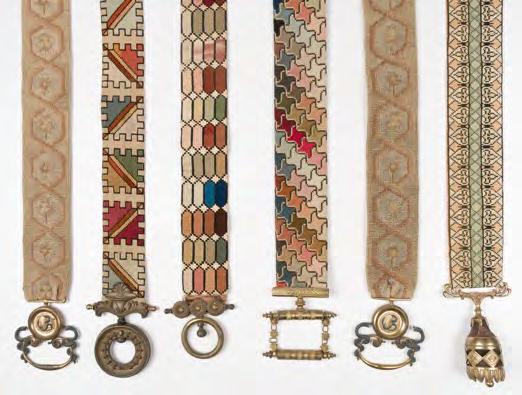
£200 - £400
415* Bell Pulls. Six Victorian needlework bell pulls, each handworked in cross-stitch in coloured wools, 4 in differing geometric designs, 2 in a matching floral design (faded), variously backed with velvet or silk (3 with backings worn, 1 with backing renewed), each with a substantial decorative metal grip in a variety of designs, longest 174 cm (68.5 ins), shortest 142 cm (56 ins) (6)
£150 - £200

416* Chinese. A goldwork rank badge, late Qing Dynasty, handembroidered in gold thread on a black ground, with a pheasant flying above waves towards the sun, amidst clouds and auspicious objects, within a border of bats and other symbols, a few loose threads, 28 x 31.5 cm (11 x 12.5 ins), mounted, framed and glazed (47 x 51.5 cm), together with 3 other framed and glazed Chinese embroideries (4) £200 - £300

417* Chinese. A ladies’ embroidered silk jacket, late Qing Dynasty, royal blue silk jacket edged in black silk (fraying in places) and coloured ribbon trim (7 cm length detached to left sleeve), front and back hand-worked with floral, butterfly, phoenix, and other motifs in polychrome silk threads and gold metallised threads, 5 yellow metal buttons to front opening, corresponding black silk loops broken and frayed, some faint discolouration to front in places, and a few loose embroidery threads to back, length 59 cm (23.25 ins), cuff to cuff 115 cm (45.25 ins), together with:
An embroidered skirt, late Qing Dynasty, apron skirt of orange silk edged with black silk, front and rear panels and pleats handembroidered with floral and other motifs in blue, white, and cream silk thread, and gold metallised threads, trims of woven ribbon, one pleat and wide blue linen waistband with discolouration, lined with pale blue silk (stained, wearing thin in places), length 96 cm (37.75 ins), plus:
A circular silk cloth, late Qing Dynasty, cloth of orange silk with undulating edge, hand-embroidered using silk threads in shades of blue, pink, and cream, with large central roundel depicting a paeony surrounded by bats, flowers, and leaves, flanked by 4 similar large roundels, each depicting a pair of bats surrounded by floral, foliate, and seedhead motifs, woven border, some faint discolouration and marks, backed with later linen, diameter 115 cm (45.25 ins)
Provenance: Believed to have been purchased by the owner’s great uncle when he was stationed in China with the Royal Navy in the early part of the 20th century.
(3)
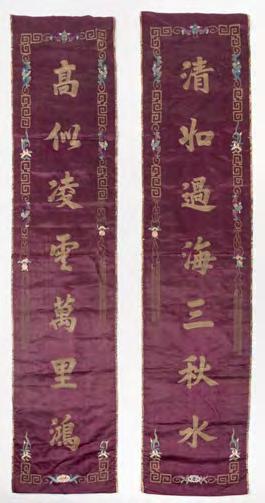
418* Chinese. A pair of embroidered panels, late 19th/early 20th century, hand-worked in couched metallised gold threads with text within a Greek key and tassel border, the border incorporating bats and floral motifs worked in satin stitch in coloured silk threads, on a purple silk ground (a few very small holes, and one 4 cm frayed tear), long sides with edging of diagonal silver metal strips (worn with losses), backed with red cotton, 158 x 36 cm (62 x 14 ins)
Provenance: Private Collection, Derbyshire. (2)
£300 - £500
£150 - £250
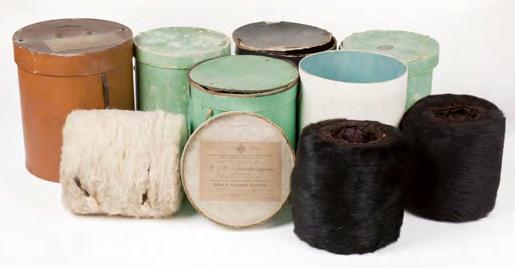
419* Clothing. A boxed fur muff, Russia: St. Petersburg, circa 1900, brown fur muff, lined with brown silk, diameter 16 cm (6 ins), length 18 cm (7 ins), contained in original cylindrical cardboard box, with printed trade label in Russian on front of lid, and pictorial label inside lide showing a shop front and lettered ‘E.M. Grunwaldt.Manufacturer of all fine furs. St. Petersburg 22. Newsky, 22.’, box dusty, with base detached, and lid broken, together with 5 other fur muffs similar, each in original box, one lacking base, plus: 2 black umbrellas, one with London hallmark on gold ferule (‘375’, initials JH within a lozenge, date letter a gothic ‘g’ within an oval), and 3 ladies’ parasols, one engraved ‘Mrs Barrow, Weetwood, Leeds’; a quantity (2 cartons) of ladies’ nightgowns (one with initials ‘EB’ in red cross-stitch) and underwear, mostly late 19th or early 20th century, including knickerbockers, split drawers, camisoles, petticoats, 2 corsets; and a linen smock, various condition and sizes
Provenance: Private Collection, Derbyshire. (quantity)
£100 - £200
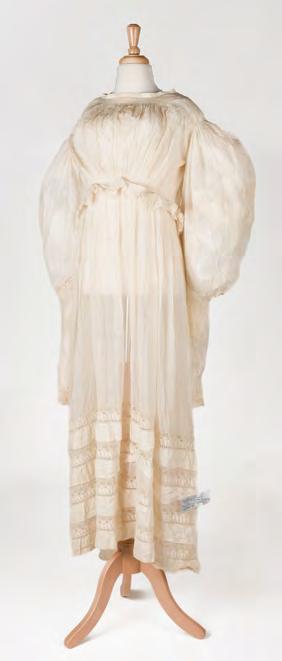
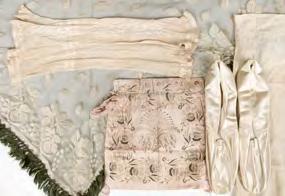
420* Clothing. A collection of clothes belonging to Mary Newhall, circa 1828, comprising: a cream muslin overdress, hand-stitched, with round neck, 4 stitched buttons to yoke, wide demi-gigot sleeves, frilled waist with drawstring, and skirt with 4 bands of broderie anglais to hem, bodice and sleeves with eyelets for narrow green ribbon (remnants extant in places), cuffs trimmed with narrow hand-made lace, toned and some foxing, manuscript label in an early hand pinned to dress ‘great granny’s Mary Newhall’s dress’, bust 73.5 cm (29 ins), waist 56 cm (22 ins), length 145 cm (57 ins); a pair of cream silk wedding shoes by Dupont, Regent Street, each trimmed with a cream silk bow, left shoe with maker’s engraved oval label inside, width 5.5 cm (2.25 ins), length 25 cm (9.75 ins); an inked cream silk reticule, both sides with pattern of stylised vegetal forms in sepia ink, pale pink silk ribbon bows to lower corners and matching drawstring (faded), a couple of small holes to drawstring casing, 21.5 x 21 cm (8.5 x 8.25 ins); a green gauze fichu woven with silver allover leaf pattern and vine leaf border, knotted fringe all round, 127.5 x 55 cm (50.25 x 21.75 ins) excluding fringe; a large fine lawn handkerchief, lettered in contemporary ink in one corner ‘Mary Newhall’, toned, and several scattered small holes; and a pair of knitted cream cotton fingerless elbow-length mittens, length 36 cm (14.25 ins)
Provenance: Mary Newhall, who married in 1828; and thence by family descent. (8) £200 - £400
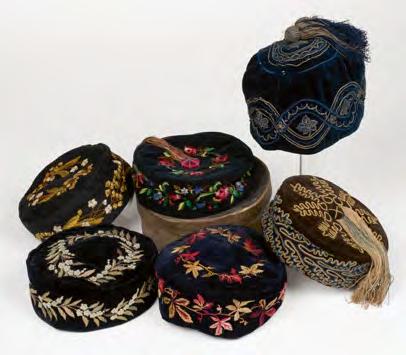
421* Clothing. A collection of six embroidered smoking hats, midlate 19th century, 5 of velvet and one of black wool, 3 with tassel to crown, each hand-embroidered in coloured threads with various floral and other patterns, one incorporating metallised gold thread (some threadwork loose, tassel detached, and small area of soiling), 4 with machine-stitched quilted lining, diameter approximately 18 cm (7 ins), one hat contained in original circular cardboard box (dusty and battered)
Provenance: Private Collection, Derbyshire.
(6)
£100 - £150
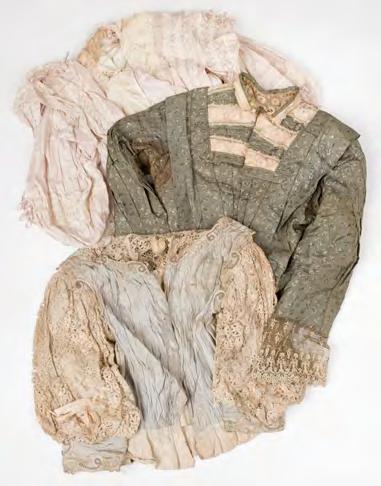
422* Clothing. A collection of Victorian and Edwardian ladies’ clothing, including: 8 bodices, 7 boned, some with maker’s name (‘Mme Bonnefoi [?] Béziers’, Mme Bernardet-[?], Chassignoles’, ‘Mme Raturas, Corréze’); a cream silk satin gown with wide neck, ruching to bodice, and puffed sleeves, probably 1840s; an Edwardian white striped muslin dress, with ribbon latticework to bodice, and ruched ribbon fashioned as bows to lower skirt; a cream velvet blouse with lace insertion at neck, and pale blue cord trim; a white muslin overdress with wide sleeves; several skirts, including a black velvet skirt with long train; and 2 wool cloaks, each with wide gathered hood, various condition and sizes
Provenance: Private Collection, Derbyshire.
(28)
£300 - £400


423* Clothing. A gold moiré silk maternity gown, circa 1820s, hand-stitched dress, with unstructured bodice (front opening without fastenings) with standing collar and leg-of-mutton sleeves, lined with calico, the skirt pleated to rear and with adjustable drawstring waist at front, occasional small marks, bust 86 cm (34 ins), sleeves 70 cm (27.5 ins), length at front 137 cm (54 ins) and at back 144.5 cm (57 ins)
Provenance: Private Collection, Derbyshire. A dress of unusual construction, most likely designed to be worn during pregnancy. Before the mass production of clothing, garments solely for maternity wear were deemed an unnecessary expense. Instead, dresses were altered and adapted during pregnancy, or made to be easily altered afterwards, therefore dresses such as this rarely survive in their original state.
(1) £200 - £300
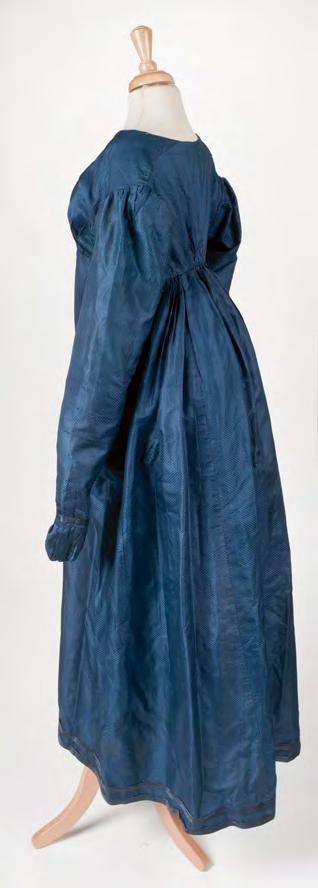
424* Clothing. A muslin dress, 1830s, hand-stitched printed cotton dress, patterned in purple with flowers and berried fronds on a white ground, with v-shaped neck and gathered bodice, metal hooks and eyes/loops to rear opening, leg-of-mutton sleeves with later lace-trimmed white cotton cuff added to existing cuff, latter with 2 tiny mother of pearl buttons (matching one at nape), and close-gathered skirt, bodice and hem lined with linen, lightly toned, and with some scattered small holes, 30 cm horizontal tear near hem repaired with stitching, bust 80 cm (31.5 ins), waist 64 cm (25 ins), sleeves 74 cm (29 ins), length 129 (50.75 ins), together with: 2 other 1830s printed muslin dresses, the first with dainty geometric broken twig design in brown on a cream ground, with wide long sleeves as before, some holes, including 3 x 2 cm hole in waistband, and staining to skirt in places, the second with flower and scroll pattern, with sleeves cut short (and edges left raw); an 1840s cotton gown, with flower and broken twig design, v-shaped bodice with decorative buttoned rosettes (one of the covered buttons worn), narrow sleeves with braid-trimmed tucks, some small holes and tears; and 2 large 1850s day dresses in printed cotton Provenance: Caulfield family, Maidhurst Lodge, Arundel, Sussex (first three items); Private Collection, Derbyshire. (6) £200 - £400
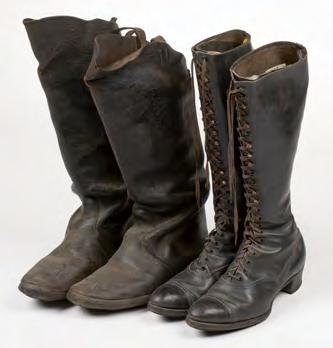
425* Clothing. A pair of coachman’s boots, 18th century, long black leather boots, hobnailed leather soles (with some wear), left boot with short split at top of rear seam, loop of left pull tab on right boot missing, length 30 cm (11.75 ins), width 10 cm (4 ins), height 46 cm (18 ins), together with a pair of long lace-up black leather ladies’ boots with heel, size 6½, length 28 cm (11 ins), width 9 cm (3.5 ins), height 41 cm (16 ins), plus a pair of 19th century clogs and 3 pairs of Victorian or Edwardian children’s shoes contained in a Christy’s & Co. Ltd. hat box (dusty and lid broken)
Provenance: Private Collection, Derbyshire. According to the owner, the ladies’ boots were given to Miss Ethel Mertens on her 12th birthday (she is believed to have been born in 1886 or 1888). Miss Mertens lived in London and her father was a Captain in the Merchant Navy. (6 pairs)
£150 - £200
426* Clothing. A Regency silk pelisse, circa 1800, hand-stitched highwaisted coat of blue figured silk, with round neck, and long sleeves with gathered cuff, matching blue silk ribbon trim down either side of front and to cuffs, some faint marks, occasional very small holes, ivory silk lining (with a number of small holes), bust 76 cm (30 ins), waist 70 cm (27.5 ins), sleeves 63 cm (25 ins), length 133 cm (52 ins)
Provenance: Private Collection, Derbyshire. (1)
£200 - £300
427* Clothing. A two-piece silk gown, circa 1860s, oyster grosgrain silk dress, comprising: a fitted and boned bodice with round neck and wide long sleeves, decorative collar and cuffs adorned with gathered wide grey silk ribbon, concealed metal hooks and stitched/metal loops to front, 5 decorative buttons to front and 2 to each cuff, lined with glazed linen, bust 78 cm (30.5 ins), waist 52 cm (20.5 ins), sleeves 50 cm (19.5 ins), length 41 cm (16 ins); a skirt with train, waist close-gathered at back, pocket in righthand side, lined with linen, waist 58 cm (22.5 ins), length at front 97 cm (38 ins), and at back 121 cm (47.5 ins), with matching bustle overskirt, edged with grey silk ribbon as before and embellished with a bow, lined with linen, length 72 cm (28 ins), occasional minor marks, but generally in good condition, together with 3 other mid-late 19th century two-piece dresses: the first of light pink-beige grosgrain silk (faded in places), with peplum back and steel cut buttons to fitted bodice, and a wide skirt with train and with 2 ruched self fabric vertical stripes to front incorporating pink tassels, maker’s name on waistband ‘Miss S. Riley Dress & Mantle Maker 16, Maiden Lane Stamford’; the second of similar fabric, comprising a heavily boned bodice, elaborately embellished with a helix-patterned braid, with mock tucked cream silk blouse, and lace at cuffs, and a wide skirt with train, inside hem trimmed with lace, plus a matching bonnet trimmed with fabric flowers and bows (slightly worn); the third of brown striped silk, the boned bodice with leg-of-mutton sleeves and encrusted with metallic braid embellished with spangles and beads, plus 2 three-piece dresses: the first of royal blue and turquoise silk and satin, comprising a short-sleeved laced boned bodice (lacking lacing), a long-sleeved boned jacket, with scallop-edged self trim, and a wide bustle skirt; the second an unstructured dress of pink and white striped muslin, comprising a bodice, skirt with train and detached belt, and a frilled overskirt, belt and overskirt embellished with self rosettes, various condition and sizes
Provenance: Private Collection, Derbyshire. (6) £300 - £500
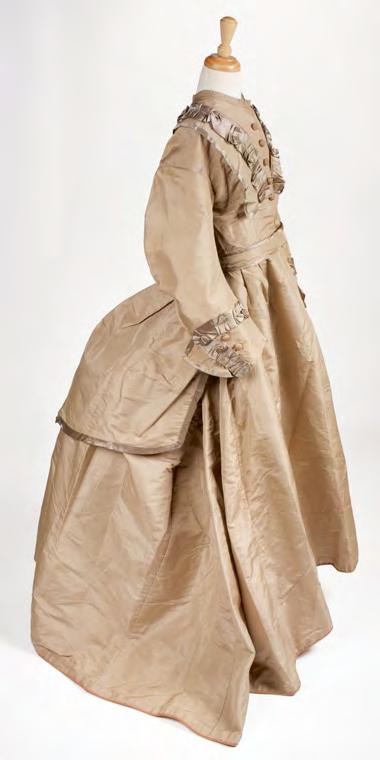

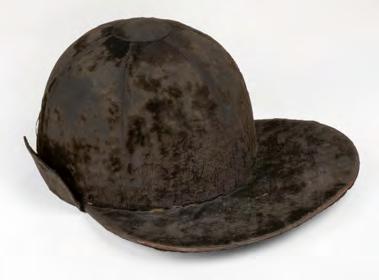
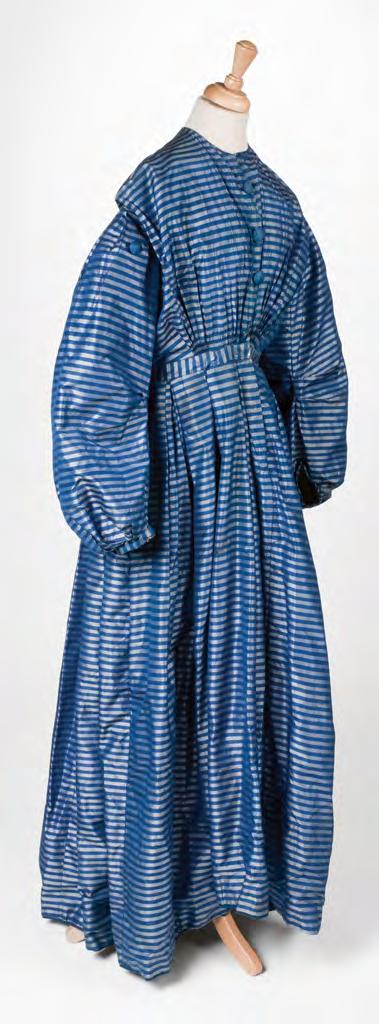
428* Clothing. An early 19th century Thames Waterman’s hat, circa 1810-20, black velvet-covered hat, with wide brim and 3 flaps to rear, largely threadbare, lined with glazed cotton, quilted forehead pad (worn, with stuffing protruding), with contemporary ink inscription beneath ‘H. Downing, Deptford, Kent, 223/4’, and 2 further ink inscriptions opposite, one crossed through with ink, length 30.5 (12 ins), width 25.5 cm (10 ins), height 15 cm (6 ins)
Provenance: Private Collection, Derbyshire.
An extremely rare hat worn by a Thames Waterman; we have been unable to trace another sold at auction, or any institutional examples.
Thames Watermen belong to the ancient guild, established in 1514, called The Worshipful Company of Watermen and Lightermen of the City of London. In the 19th century their employers were numerous, including the Navy and the Royal Household, as well as city livery companies and members of the aristocracy, and the Watermen had their own distinct livery or costume accordingly. Watermen took part in annual boat races on the Thames; winning such a race had the advantage of raised prestige and therefore increased earning potential. The Company still trains Watermen, who earn their living on the Thames, compete in water sports and raise money for charity. Royal Watermen are chosen from amongst their ranks, the duties of which were once to transport the Sovereign between the Royal Palaces, but who now pilot the Royal Nore motor launch for official royal engagements as well as take part in ceremonial duties both on and offshore.
(1)
429* Clothing. An early Victorian wedding dress worn by Elizabeth Anne Dacombe née Jeggo, 1862, hand-made gown of blue and silver striped silk, mostly handstitched, the round-necked fitted bodice close-gathered at waist creating pleats to front, front opening with metal hooks and stitched loops (some lacking or replaced), 3 (of 5?) decorative covered buttons, wide long sleeves terminating in a narrow cuff, matching decorative button to shoulders, underarms stained and beginning to perish slightly, pleated skirt with slight train, small self buttons to either side of waist, pocket in right-hand side, bodice loosely lined with cream fine cotton (front opening with metal hooks and eyes), and skirt lined with cream muslin, latter with small brass rings and blue silk ribbon drawstrings to pull skirt up, occasional small marks and tiny holes, hem a little frayed to extreme edge in places, bust 91.5 cm (36 ins), waist 68.5 cm (27 ins), sleeves 58.5 cm (23 ins), length at front 139.5 cm (55 ins), and at back 149.5 cm (59 ins), together with 3 other items: a tucked handmade blouse (with hand and machine stitching) and 2 tablecloths
Provenance: Believed to be the wedding dress of the owner’s paternal great great grandmother, Elizabeth Ann Dacombe née Jeggo (born 1827), who married on 24th July 1862. Her only child, John Morley Jeggo Dacombe, was born in Bournemouth in 1867. (4)
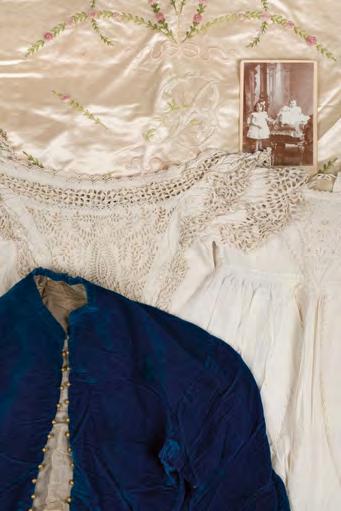
£150 - £250
430* Clothing. A collection of children’s clothes and accessories, most belonging to the Byrne family, 19th & early 20th century, including an embroidered satin and lace pram cover with initial ‘B’, several dolls’ clothes, a number of juvenile needlework specimens, a fur muff, dresses and blouses (some with whitework, smocking, etc.), baby shirts, nightgowns and woollen vests, 2 handworked broderie anglais bodices, collars, christening gowns (including one of fine Ayreshirework), boys breeches, jackets (including a sailor jacket, and a lace-trimmed blue velvet jacket), capes, and a large quantity of whitework bonnets, various condition and sizes, together with a Victorian album containing photographs of the Byrne family and 8 loose photographs (one framed), some photographs apparently showing the clothes being worn, and a manuscript note with details of Major Hugh Frederick Byrne’s military career (active service 1875-1908), together with a box of miscellaneous items from the Evans family of Darley Abbey, Derby, including sewing accoutrements, lace, belts, ribbons, embroidered items, etc.
Provenance: Private Collection, Derbyshire.
(4 cartons)
£200 - £300
431* Clothing. Footman’s court dress suit worn by George Birry to wait on King Edward VII & Queen Alexandra at Lockinge House, Wantage, comprising: a navy blue wool frock coat trimmed in red, with metallised gold braid edging, and crested brass buttons to both sides of front, pockets, cuffs, and foot of tails, some historic moth damage, chest 82 cm (32.25 ins), sleeves 60 cm (23.5 ins), length 87 cm (34.25 ins); a red wool waistcoat, with crested buttons as before, some surface rubbing, edge of underarms slightly discoloured, twill lining toned and stained, chest 90 cm (35.5 ins), length 60 cm (23.5 ins); and a pair of red velvet knee breeches, waist with Wilkinson & Son buttons, braid, buckles, and crested buttons at knees, a few small holes and repairs to front of left leg, waist 80 cm (31.5 ins), length 76 cm (30 ins), together with a manuscript note contained in waistcoat pocket: ‘June 22nd 1898. 1950. This Court Dress Suit was worn when George my Husband had to wait on King Edward VII, when on a visit with Queen Alexandra to the Late Lord & Lady Wantage at Lockynge[sic] House Wantage Berkshire Signed Alice C. Birry’, plus: 6 other gentlemen’s garments similar, including a frock coat with buttons depicting an eagle and lettered ‘Lycee Imperial de Clermont’, a frock coat with crested buttons relating to the Caulfield family, and another similar with crested buttons depicting a boar pierced by an arrow; 5 gentlemen’s waistcoats, one Georgian, and one with hand-embroidered floral decoration; 3 further frock coats (theatrical), one with accompanying waistcoat and breeches (the 3 items labelled ‘Keith Baxter, Dorante, The Inconstant Couple’); and a theatrical wig labelled inside ‘Clarkson, Maker, 45, Wellington Street, Strand’, various sizes and condition
Provenance: Private Collection, Derbyshire.
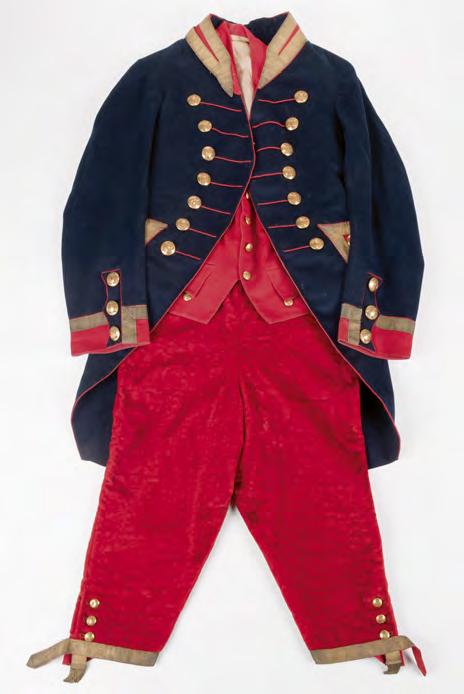
King Edward VII was a great friend of Brigadier General Robert James LoydLindsay, 1st Baron Wantage, and his wife Harriet. (20)
£200 - £400
432* Curtains. A pair of large embroidered curtains, probably Middle Eastern, early-mid 19th century, a pair of thick and heavy curtains, elaborately embroidered overall with silver and gold metallised threads, using mainly chain stitch, on a gold velvet ground (threadbare), with dragons, deer, and floral and foliate motifs, border of further symbols and Arabic-style text, some green staining and loose or lost stitching, sides and lower edges with substantial velvet and twisted cord tasselled border (unravellling in places), later cream cotton lining (some staining and small holes), rufflette tape machine-stitched to top edge, and gold gimp braid hand-stitched 42 cm down from top edge, each drop 254 (100 ins), width 134.5 cm (53 ins)
Provenance: Private Collection, Derbyshire. Possibly originally made for use in a mosque. (2)
£200 - £300

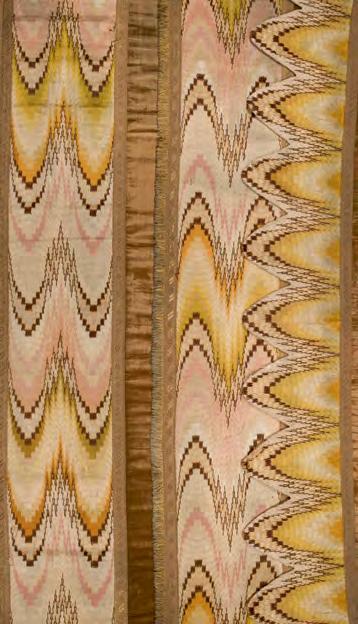
433* Curtains. A pair of needlework door curtains and matching pelmet, 19th century, each curtain with a vertical hand-stitched woolwork tapestry panel, worked in flame stitch, in hues of predominantly orange, pink, brown, green, and cream, some small losses of threadwork in places, bordered with metallised gold trim and joined to a vertical panel of gold velvet (with some short splits and minor historic moth holes), gold and olive green fringe to leading and lower edges, backed with hessian, and lined with brown cotton twill (soiled and with some holes), top edges sometime turned over and with wooden curtain rings (most missing) attached to metal hooks (some broken), dimensions including fringe 254 x 58.5 cm (100 x 23 ins), the matching pelmet worked in flame stitch, with metallised gold trim to top edge and lined as before, 32 x 200.5 cm (12.5 x 79 ins)
Provenance: Private Collection, Derbyshire. (3)
£100 - £200
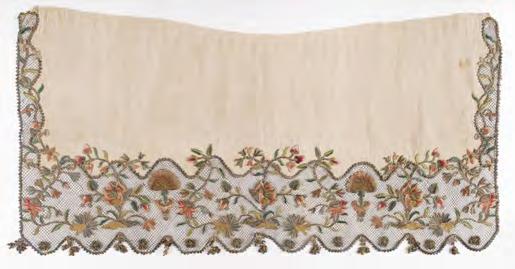
434* Embroidered Apron. An English embroidered silk apron panel, early-mid 18th century, ivory silk, with narrow side and deep lower borders of silk-backed embroidery appliqués on a metallic gold net lace ground, the floral and foliate appliqués worked in polychrome silk threads and gold and silver metallised threads, using long and short stitch, basketweave, bullion stitch, couching, satin stitch, stem stitch, and french knots, comprising a fanshaped tree in an urn alternating between sinuous floral stems and fronds emanating from a rocky mound, the border with scalloped edge oversewn with picots in silver metallised thread, lower edge with four-petalled flower in each scallop composed of blue and metallic thread with spangle to centre, and with suspended tassels composed of gold and silver metallic strips and thread (pair of tassels in centre with part of one missing), without drawstring (some associated stitching remaining), silk toned and with small stains, but recently expertly conserved (Conservation Report of 2019 by the Textile Conservation Studio of the People’s History Museum included), 51 x 99 cm (20 x 39 ins)
The delicate and beautiful appliquéd metallic lace is an unusual feature on a lady’s apron of this period; we have not seen another such. There are a number of 18th century embroidered aprons in the V&A, but none similar to this example.
(1)
£400 - £600

435* Embroidered Apron. An English embroidered silk apron panel, early-mid 18th century, finely hand-stitched in polychrome silk threads and metallised gold and silver threads on a cream silk taffeta ground, using satin stitch, chain stitch, couching, stem stitch, and long and short stitch, with floral basket in centre and at each lower corner (including carnations and tulips), 2 large oval garlands of flowers terminating in a large carnation suspended from top edge, and repeated flower motif and stylised palm tree on mound, sinuous floral border to sides and lower edge, and wavy line outer border, some small faint stains, top edge (with no drawstring and sometime re-hemmed by hand) beginning to perish in a few places, but needlework almost entirely intact, colours vibrant, and silk ground generally robust, later narrow gold braid edging, tabs to top corners, and tassels to lower corners, 47 x 112 cm (17.5 x 44 ins)
(1)
£300 - £500

436* Embroidered Bowcase. A needlework bowcase, probably Persian or Indian, 18th century, shaped gusseted leather case, of characteristic form, open at top and bottom, covered in blue velvet on the front and crimson velvet on the back (latter with some black marks), the front and gusset embroidered in metallised silver threads with flower motif surrounded by silver spangles forming a lattice design, silver tarnished and rubbed in places revealing thread beneath, some loss of spangles, stitched border in yellow, green, and pink threads, suspension loop and strap of blue velvetcovered leather similarly embroidered in silver threads (strap worn at ends), 38 x 24 cm (15 x 9.5 ins)
Provenance: Private Collection, Derbyshire.
A rare early bowcase.
(1)
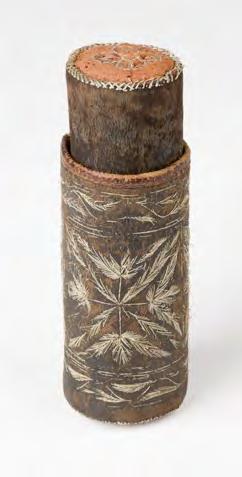
437* Embroidered Case. An embroidered cylindrical case, possibly for letters, probably Native American, early 19th century, comprising an inner and outer cylinder of hand-stitched leather, the outer case embroidered with foliate motifs (using animal hair?), slightly rubbed, and some loss of threadwork, diameter of inner tube 4 cm (1.5 ins) and of outer tube 4.5 cm (1.75 ins), length of inner tube 8.5 cm (3.25 ins) and of outer tube 10 cm (4 ins)
A most unusual object, possibly intended to carry letters and messages; we have not been able to trace another similar.
(1)
£300 - £500
£100 - £150
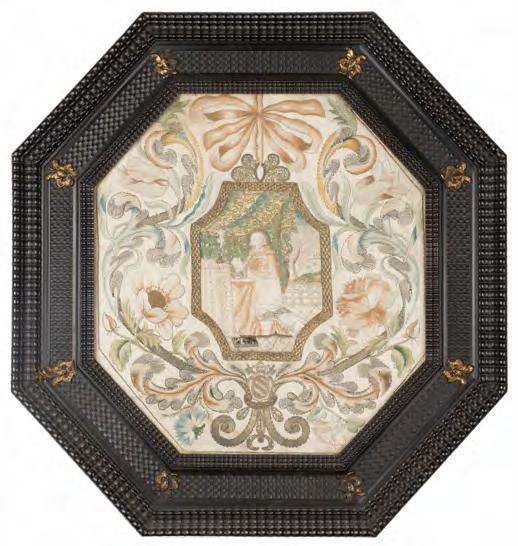
438* Embroidered Picture. A 17th century octagonal trompe-l’œil needlework, worked in silk threads in shades of orange, yellow, blue, green, and cream, incorporating metallised gold threads, on a ground of cream silk, using long and short stitch, basketweave, bullion stitch, couching, stem stitch, and french knots, the central panel simulating a portrait miniature, depicting Pope Pius V in long robes with a halo around his head, kneeling in prayer at an altar, against a fringed curtain, a balustrade and vista to his right, within a goldwork basketweave border forming a raised frame suspended by an embroidered ribbon bow, wide border of scrolling voluted stems of tulips, love-in-a-mist, columbines, anemones, and roses, the stems emanating from Pope Pius V’s papal coat of arms below portrait, featuring an oval shield with three bendlets, a triregnum (papal tiara), crossed keys, and ears of wheat, slightly faded, very occasional loss of threads, 31.5 x 29 cm (12.5 x 11.5 ins), octagonal ebonised ripple moulded frame with yellow metal ornamentation, glazed (45.5 x 43 cm), backboard with remains of an old framer’s label relaid (Andrea Bracchi, Firenze?)
An attractively-framed and well-preserved 17th century embroidery with unusual trompe-l’œil design.
Pope Pius V (1504-1572), born Antonio Ghislieri (and from 1518 called Michele Ghislieri), was head of the Catholic Church and ruler of the Papal States from 1566 until his death in 1572. (1)
£300 - £500
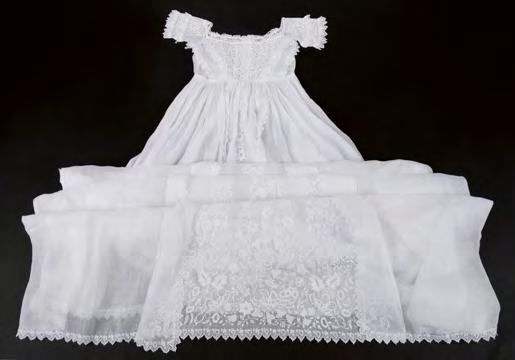
439* Embroidery. A fine Ayrshire work christening gown, circa 1850s, white muslin with long skirt close-gathered at waist, the bodice finely worked with a basket, whelks, seaweed, flowers, and foliate fronds, the short sleeves similarly worked and with a double frill, original tiny button closures on rear of bodice, centre panel of front of skirt also lavishly stitched in Ayrshire work, and edged either side to match cuff frills and hem, a number of holes (some repaired) in the back of the skirt (largest 3.5 x 1 cm, remainder much smaller), chest 48 cm (19 ins), waist 44 cm (17.25 ins), length 120 cm (47.25 ins), accompanied by a lace-trimmed tucked long petticoat, together with other whitework items: a short white lawn baby gown of Ayrshire work; a bodice and a bonnet similar; 3 long christening gowns; 2 bonnets; and a long-sleeved blouse, plus 8 other infant garments (a bonnet[?] of machine net with early [16th century?] embroidered border and points for attaching to clothing, a petticoat trimmed with Irish crochet, a vest, 2 lace-trimmed shirts, and 3 pairs of bloomers), mostly in good condition, various sizes
440* Embroidery. A framed piece of fine whitework, Victorian, handworked in white cotton on fine white lawn, using satin, seed, buttonhole, and stem stitch, and incorporating eyelets and cutwork with needlelace fillings, with a large oval filled with flowers to each corner, each connected by further elaborate floral motifs and leaf stems, ground with some tiny holes and faint marks (mainly to edges), 44 x 43.5 cm (17.25 x 17 ins), verre eglomise frame (58 x 57.5 cm)
Provenance: Mrs Holland née Everard.
An extremely intricate and expertly-stitched piece of whitework embroidery, the needlelace insertions particularly finely worked. (1)
£100 - £200

441* Embroidery. A goldwork and beetle-wing panel, India, 19th century, hand-worked with couched metallised gold threads incorporating elytra, on a terracotta silk ground backed with red muslin, with a mirror image scallop-edged pelmet pattern composed of scrollwork and fleurons, terminating at one end with wavy foliate lines, some elytra broken or lost, but overall in good condition, 216 x 45 cm (85 x 17.5 ins)
Provenance: Private Collection, Derbyshire. (1)
£150 - £200
The sea shells and seaweed on this finely worked Ayrshire christening gown are an unusual feature. (19)
£200 - £400

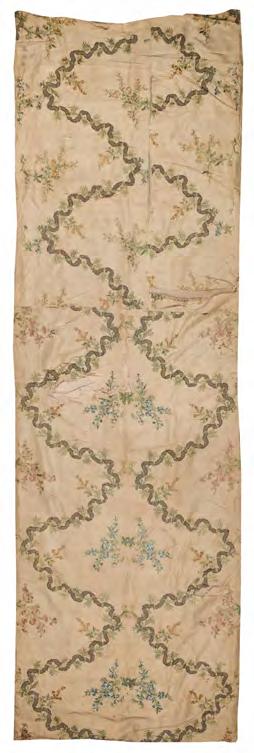
442* Embroidery. A large panel, possibly part of a Robe à la Française, British, circa 1730-50, embroidered in metallised silver threads with a sinuous ribbon design forming a lattice, the ribbons edged with tiny silver spangles, entwined with flowers and leaves, and enclosing large floral posies, all worked in coloured silks in shades of pink, blue, yellow, and green, on a cream silk ground, the panel composed of 4 pieces hand-stitched together (embroidery not continuous), toned and worn, with ground perishing and seams splitting (threadwork mostly extant), sometime backed with linen (machine-stitched), 260 x 81 cm (102.5 x 32 ins)
Provenance: Private Collection, Derbyshire.
Most likely a rare survival from one of the wide-skirted gowns of the second quarter of the 18th century which were worn with a pannier support beneath. The voluminosity of the gown would accentuate the small waist of the wearer, whilst the large expanse of costly material would indicate the wealth and status of the lady (as the 18th century wore on skirts expanded in width so that by the middle of the century some ladies wore panniers seven feet wide). This fabric would undoubtedly have been worn by someone of considerable social standing, its silver threadwork and spangles designed to shimmer by candlelight and impress.
(1)
£200 - £300
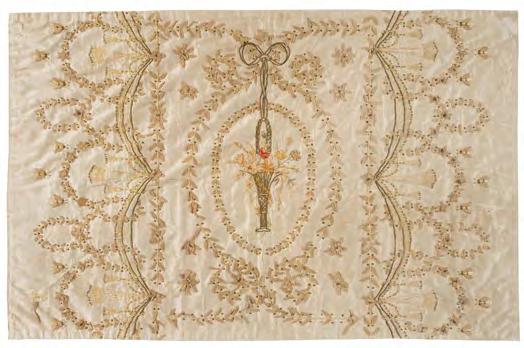
443* Embroidery. A large piece of Regency embroidery, finely worked in ribbon and silk thread embroidery and picot-edged ribbon appliqué, incorporating metallised threads, spangles, and beads, on a cream silk ground, depicting a basket of flowers suspended from a ribbon bow in the centre, within an oval foliate wreath and further double frame of foliate swags and volutes, flanked by a pelmet on either side entwined with tassels and foliate swags, incorporating bees, several appliqués loose (revealing design outline), silk ground just beginning to perish in places (mostly to edges), but generally in good condition, sometime stitchmounted on linen, 48.5 x 75.5 cm (19 x 29.75 ins), mounted, framed and glazed (69.5 x 95 cm)
A beautiful piece of Regency embroidery. Perhaps executed by a professional embroiderer, it was probably originally part of a lady’s dress or train, and likely intended for wear at court or for some other important occasion.
(1)

444* Embroidery. A needlework fragment, possibly 16th century, hand-worked in tent stitch in coloured silk threads, in shades of green, blue, brown, yellow, and cream, and metallised silver threads, with a flowering and fruiting foliate design, 10.5 x 26 cm (4.25 x 10.25 ins), textured thick gilt mount with engraved oval plaque ‘This needlework was done by Mary Queen of Scots’, framed and glazed (23.5 x 38.5 cm)
(1)
£200 - £400
£200 - £300

445* Fabric. Pieces from a deconstructed gown of Spitalfields silk brocade, circa 1730-1750, cream figured silk with woven pattern of repeated large rose stems (14 x 11.5 cm), sweetpea stems, and other flowers, comprising: 5 panels, all but one pieced, some faint marks and light toning, largest 122 x 98.5 cm (48 x x 38.75 ins), smallest 107 x 46 cm (42 x 18 ins); an 1840s bodice of the same fabric (and other fabric similar), edged with fly fringe (some detached); and several small matching fragments of the same, together with a portion of cream silk lining backed with glazed cotton and with a pocket attached, 99 x 48 cm (39 x 19 ins) (8)
£200 - £400
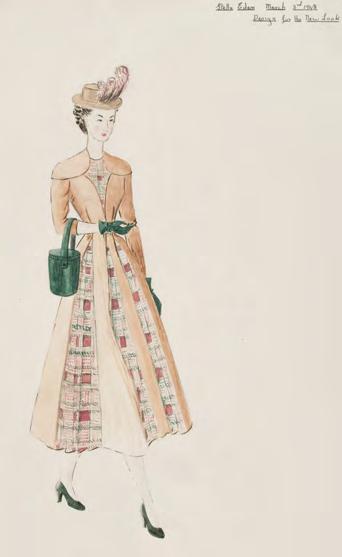
446* Fashion Designs. A collection of designs for the New Look by Stella Eden, March 1947-October 1948, 38 leaves of drawings and sketches, pen & ink or pencil, some with watercolour, mostly to rectos only, but several leaves with additional drawings on versos, some drawings mounted on the leaves, some leaves with several sketches, various designs, including evening and day dresses, blouses, skating costumes, ladies’ suits, nightwear and lingerie, hats and bags, shoes, etc., one with pinned small fabric swatch, some with notations, most titled and with the artist’s name and date, occasional light foxing, 1 leaf torn with loss, another with a large piece excised, sheet size 55.5 x 38 cm (22 x 15 ins)
Executed by a fashion student, these showcase the femininity and opulence of the new glamorous silhouette as defined by Christian Dior; only a month before the first of these were drawn, on February 12th 1947, Dior launched the ‘New Look’ in his debut collection. (a folder) £100 - £150

Lot 447
447* Household Linen. A hand-worked filet lace and cutwork bedcover, French, circa 1900, white linen, central lobed panel of filet lace depicting a pair of birds flanked by a cherub on either side, below another similar panel depicting a shield with initial ‘C’ flanked by cherubs, both panels surrounded by a pattern of volutes in embroidery and cutwork, and bordered by leaf-patterned insertions of filet lace terminating in a square at each lower corner, the squares enclosing 4 cutwork fleur-de-lys emanating from a quatrefoil, filet lace scalloped edging to sides and lower edge, occasional small breaks in the lace, 188 x 131 cm (74 x 51.5 ins), together with:
A large hand-worked embroidered bedcover, circa 1920, fine white linen, fold-over top end stitched in whitework embroidery and drawn threadwork, depicting three cherubs, one with a book and one with a lyre, within a frame of volutes, and flower and leaf sprays, button-hole stitched scalloped edges top and bottom, 246 x 233.5 cm (97 x 92 ins), and two matching pillowcases, plus other items of household linen, including sheet shams, a broderie anglais handkerchief case, pillowcases, initialled nightdress case, etc., generally in good condition, various sizes
(16)
£100 - £150
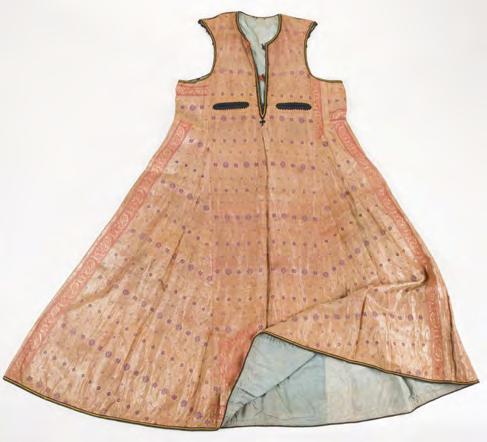
448* Indian. A 19th century sleeveless robe, long flared tunic of silk woven with small purple flowers, large orange botehs, and gold boteh borders, on an orange-striped gold ground, with round neck with slit (fastened with knotted toggles), two slit pockets to front of bodice and two corresponding slit pockets to back, and black and yellow edging braid, some staining (especially to back) and loose threads, bottom of neck slit becoming unstitched, lined with pale blue fine linen, chest 110 cm (43 ins), length 130 cm (51 ins)
Provenance: Private Collection, Derbyshire.
We have been unable to discover the purpose of the pockets in the back of the garment.
(1)
£100 - £200
449* Japanese. A kimono pattern book, circa 1890, woodblock printed on double leaves folded in the Japanese style, some pages printed in colour, including 6 pages of kimonos, and 4 pages of fabric designs, remainder with various patterns, illustrative motifs, images of tools, etc., original leaf pattern stitched wrappers, covers lightly soiled and printed label on front cover rubbed, oblong 8vo (11.3 x 16.2 cm/4.5 x 6.25 ins), loosely contained in a contemporary stiffened red cloth cover (dusty) with typed label to spine ‘Japanese Design.’ (1)
£200 - £300
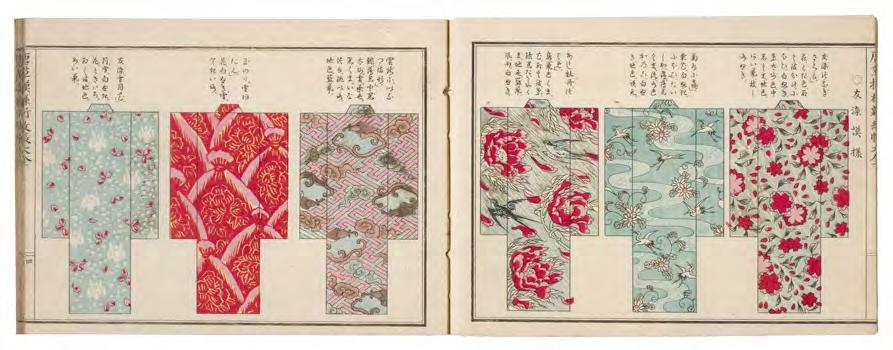
450* Kilim. A pair of large curtains, 19th century, with overall woven pattern of various geometric motifs in black, white, pale blue, and mustard, on a terracotta ground, some wear, scattered holes, and old repairs, thick knotted tassel border along leading edges (some losses), one with curtain rings sewn to top edge, the other with curtains rings sewn 47 cm down from top edge on verso, approximately 269 x 132 cm (106 x 52 ins) and 279.5 x 132 cm (110 x 52 ins)
Provenance: Private Collection, Derbyshire. (2)
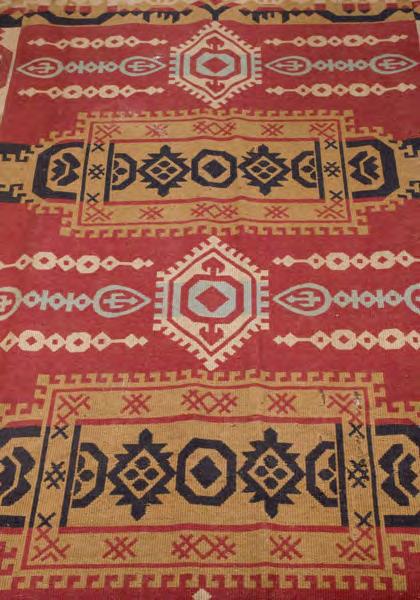
£150 - £250
451* Kilim. A woven wool kilim, probably Persian, late 19th century/early 20th century, geometric all-over pattern in shades of orange, green, and pale yellow, enclosed by a multi-banded border, fringed to short ends (that to upper edge trimmed, some losses to lower end), old curtain rings for hanging to verso at top (1 lacking), 184 x 132 cm (72.5 x 52 ins) (1)
£300 - £500
452* Kilim. A woven wool runner, probably Turkish, late 19th/early 20th century, with 2 alternating vertical bands of geometric motifs, in polychrome threads on an orange ground, a little dusty, a few small holes, interlined and backed with machine-stitched red fabric forming a 21 cm border to one short edge, backing fabric marked and worn, with losses, 316 x 89 cm (124.5 x 35 ins) (1)
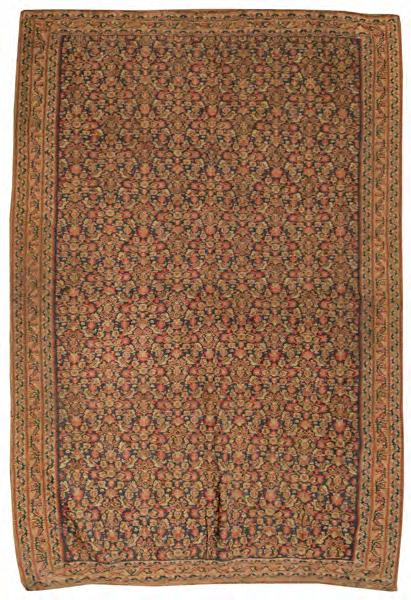
£200 - £300

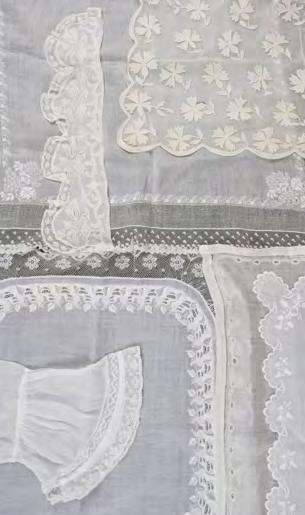
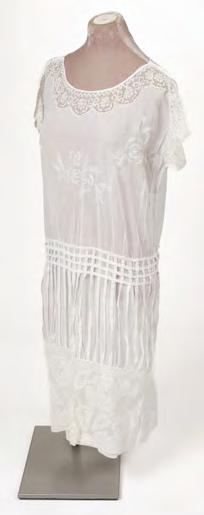

453* Lace & Embroidery. A collection of garments, handkerchiefs, and edgings, circa 1800-1920s, including: 7 handkerchiefs, e.g. a large Regency example with fine whitework and Mechlin(?) lace edging; a large needlepoint net flounce, 45 x 300 cm (17.75 x 118 ins); a cream needlepoint net lace overdress, full-length, circa 1910-20, probably never used (with printed paper remains to neck); a 1920s long lace edging for a bridal train, 52 x 263 cm (20.5 x 103.5 ins); a Chikan skirt length; an early 19th century muslin modesty panel; a Regency scallop-edged stole of fine cream muslin appliquéd with cornflowers attached with tambour work, some holes and repaired tears, 68 x 227 cm (26.75 x 89 ins); several collars, cuffs, and trims; and a quantity of black lace items (camisole, bonnet veil, flounces, etc.), together with a white cotton tucked crinoline underskirt, circa 1860s, inside of waistband with name in contemporary ink ‘M. Hartles’, waist 68 cm (26.5 ins), length 94 cm (37 ins), various condition and sizes (approximately 35)
£300 - £400
454* Lace. A collection of lace and embroidered items, 19th-early 20th century, including: a 1920s unstructured overdress of fine white cotton, hand-embroidered in white to front of bodice with Mackintoshesque roses, shallow round neck and short sleeves with scalloped filet lace insertions, front of skirt with overlay of vertical strips woven into a dropped waistband at the top (with rear ties), and terminating in a wide filet lace border at hem, a few minor marks to back of skirt, bust 116 cm (45.5 ins), waist 112 cm (44 ins), length 104 cm (41 ins); a quantity of lace, mostly hand-made, all white and cream (except for a black lace blouse), including shawls (one labelled ‘Granny Bowles Limerick lace shawl’), a birch bark box embroidered with moose hair, containing lengths and other oddments labelled ‘Granny Bowles’ box lace from Canada given me when she died (not the lace inside that was mothers & mine)’, stoles, neck ruffles, cuffs, a nightdress holder, rosettes, collars, handkerchiefs, etc.; several camisole blouses; an Edwardian cream grosgrain child’s cape; 10 christening gowns and baby dresses; a lace-edged embroidered crimson satin crib cover; and several baby bonnets and bibs, various condition and sizes
Granny Bowles, the owner of the Limerick lace shawl and birch bark box, was the vendor’s great great great grandmother, Mary, who was born in Quebec, Canada, in 1829. She married Irishman Joseph Bowles (born 1814) in 1846. (2 cartons)
£200 - £400
455* Lace. A collection of lace, 19th-early 20th century, mostly white and cream hand-made lace, but including some black lace and some machine-made lace, some labelled, including Carrickmacross, Italian, Irish crochet, tatting, Limerick lace, Maltese, Brussels, Point de Gaze, etc., e.g. edgings and large flounces, collars, bodice fronts, an infant’s dress, 2 doll’s dresses and a doll’s cape, cuffs, shawls, a parasol cover, berthas, stoles, etc., together with 2 patterns printed for The Englishwoman’s Domestic Magazine, various other lace template patterns, one backed with glazed blue linen and with printed title ‘Treadwin, Exeter, No.11’, and a piece of tape lace being worked on a green morocco backing, plus a wax flower and faux pearl wedding circlet, various condition and sizes (2 cartons)
£400 - £600

456* Lace. A group of Honiton lace, 19th century, comprising: a large collar, finely-worked with tulips, thistles, butterflies, birds, foliate fronds, and other motifs, 12 cm vertical tear in centre of top edge with some loss (altered to fit to a garment?), 79 x 77 cm (31 x 30.25 ins); 3 fall caps; a small bertha; 2 matching lengths, width 9.5 cm (3.75 ins), length 103 and 121 cm (40.5 and 47.5 ins); 4 matching lengths, 3 stitch-mounted on blue tissue paper, width 7.5 cm (3 ins), length 33, 34, 42, and 150 cm (13, 13.25, 16.5, 59 ins); and 12 small lengths and fragments, mostly in good condition (23)
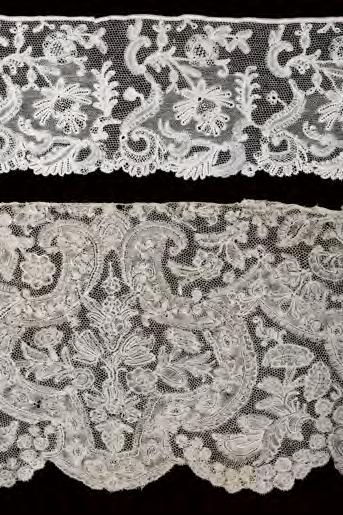
£150 - £200
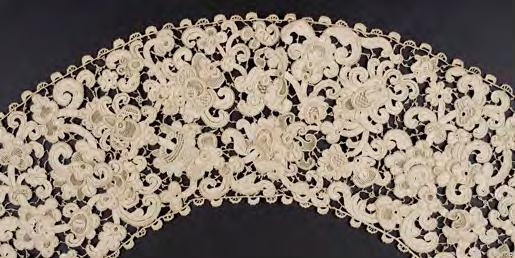
457* Lace. A large flounce of Flemish or Milanese lace, 18th century, cream lace flounce, hand-worked with scrolling flower and leaf stems, and drawer handles, a few minor fox spots, but overall in very good condition, 16.5 x 344 cm (6.5 x 135.5 ins), together with:
A large flounce of lace, possibly Flemish, 18th century, cream lace flounce, hand-worked with large scallops enclosing flower and leaf sprays, some breaks and holes (largest 7 x 2 cm), 30 x 416 cm (11.75 x 163.75 ins), plus a lace bertha (3)
£200 - £300
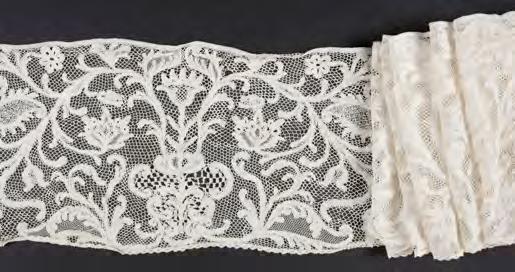
458* Lace. A large flounce of Milanese lace, late 18th/early 19th century, linen bobbin lace, with a scrollwork pattern incorporating floral and foliate motifs, very occasional small breaks or holes, 23 x 295 cm (9 x 116 ins) (1)
£200 - £300
459* Lace. Four large pieces of Venetian Gros Point, probably 17th century, 3 pieces of ecru linen needlelace, comprising: a long length, worked with large-scale flower heads with raised cordonnets spiked with picots, diapered fillings, and picot brides, sometime neatly gathered in two places to form a valance (with corresponding bone stiffening on reverse), 19.5 x 279 cm (7.75 x 110 ins); a matching long length sometime stitched in the middle to form a v-shape (incorporating a backing of black fabric at that point), 20.5 x 140 cm (8 x 55 ins); and 2 collars similar, 48 x 64 cm (19 x 25.25 ins) and 52 x 104 cm (20.5 x 41 ins), brides broken in places, but generally in good condition, except largest collar worn with losses (4)
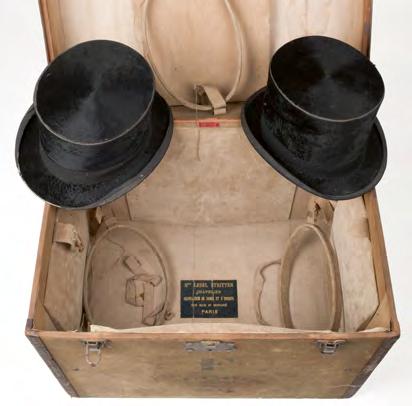
£200 - £400
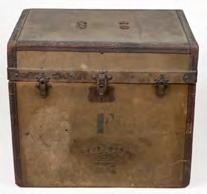
460* Luggage. A hat trunk, Paris: Lebel Stritter, early 20th century, canvas covered trunk with leather edges, rivets, and metal catches, lacking carrying handle, front side stencilled in black with a large letter ‘F’ above an earl’s coronet, old adhesive tickets to one side, soiled, and leather cracked to one corner of hinged lid, interior with cream velvet padded sides, and fixtures to sides and lid for securing hats, including cream velvet-covered oval frames and fabric straps with metal buckles (one strap detached), base of inside with gilt lettered maker’s label ‘Mon Lebel Stritter Chapelier, Chapellerie de Dames et d’Enfants, 259 Rue St Honoré Paris’ (lightly rubbed), base slightly dusty, and some water-staining to inside lid, height 48 cm (19 ins), width 56 cm (22 ins), depth 41 cm (16 ins), containing 2 top hats, one with stamp inside of ‘W.V. Brown late Sanders & Brown, Eton’, bearing ink name H.D. Thornton, and the other with stamp ‘Newman House, 90-92 Oxford Street, W.’, both worn, together with a quantity of gentleman’s clothes from the same period, comprising 4 tailcoats, a waistcoat, and 7 white shirts Provenance: Private Collection, Derbyshire. (2)
£100 - £200
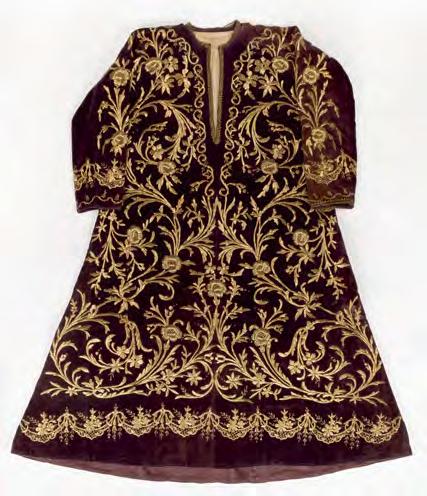
461* Ottoman Embroidery. A fine metalwork embroidered kaftan, Turkey, 19th century, lavishly embroidered overall with raised gilt metallised threadwork, using padded satin stitch and bullion stitch, and incorporating spangles, with an all-over design of floral scrollwork and a lattice pelmet border with flowers to sleeves and hem, on a purple velvet ground, long sleeves and neckline trimmed with gold metallised braid, occasional loose or lost threadwork, velvet faded in places, and some soiling (mainly to hem), lined with linen, chest 116 cm (45.5 ins), sleeves 54 cm (21.25 ins), length at front 134.5 cm (53 ins) and at back 139.5 cm (55 ins)
Provenance: Given by Eric Clapton to his hairdresser, who gave it to the collector John Hilton of London, from whom it was purchased by the current owner.
(1)
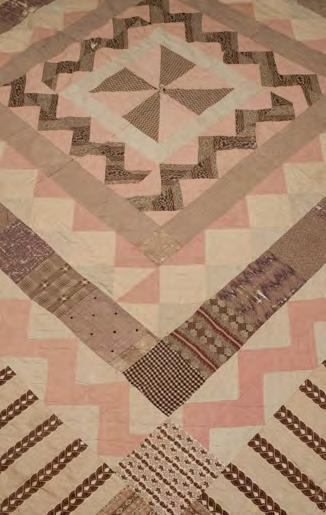
462* Quilt. A Victorian patchwork coverlet, mid 19th century, hand-stitched bedcover, with geometric pattern composed of square and triangular patches, in a variety of printed cotton fabrics in beige, brown, and pink, slightly toned, a dozen or so patches perishing, backed with cream cotton, hem turned over to front to form a border (hole in one edge), quilted overall in pale thread, 249 x 256.5 cm (98 x 101 ins)
Provenance: Private Collection, Derbyshire. (1)

£100 - £200
£400 - £600
463* Sampler. An 18th century needlework by Deborah Sparke, 1745, worked in cross-stitch and Algerian eye stitch, in polychrome silk threads (some faded), on a light beige linen ground, with alphabets in upper and lower case, interspersed with crowns and hearts, above the Lord’s Prayer between borders, with 3 flower urns to lower margin flanked by crowns, and with lettering below ‘1745 Deborah Sparke wrought this Sampler in the 12th year of her age’, 38.5 x 21 cm (15 x 8.25 ins), framed and glazed (47 x 29 cm) (1)
£150 - £200
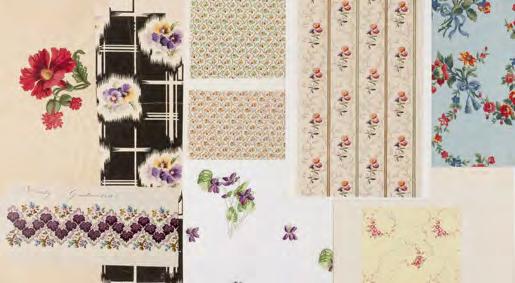
464* Samples. A collection of fabric and wallpaper samples and designs, late 19th-20th century, comprising: 25 fabric samples, 1 labelled ‘Liberty’, 2 with printed label ‘Société des Nouveautés Textiles’, several labelled or stamped ‘Design Laboratory, Fashion Institute of Technology, New York’; 5 colour-blocked wallpaper or fabric designs, one annotated in manuscript ‘Wesserling Garniture’, another with pencilled marginalia pertaining to colours; and 8 original watercolour or gouache designs, all depicting different flowers, including poppies, auriculas, and violets, various condition, sheet size largest 42 x 29 cm (16.5 x 11.5 ins), smallest 6.5 x 7 cm (2.5 x 2.75 ins), a number mounted on paper or card (38)
£200 - £300

465* Sewing. A mid 18th century layette pinwork pincushion, ivory glazed cotton pincushion of curved rectangular form, hand-quilted to one side and set with handmade pins forming initials and dates: ICP 1756; CP 1757; EP.TP [175]9; DP [17]61; SBP 1762, dust-soiled, one silk corner tassel only remaining, 14.5 x 11 cm (5.75 x 4.25 ins), together with another pinwork pincushion of curved rectangular form similar, hand-quilted cream silk satin, with a date in pins to each side: 1726, 1728, 1730, 1733, backing of cream damask, piping to edges (corners and piping slightly frayed in places), 16 x 10 cm (6 x 4 ins)
An early pincushion commemorating the births of several children, with apparently two born in one year; so-called ‘Irish’ or ‘Catholic’ twins, referring to the fact that both Irish people and those who were practising Catholics were perceived as giving birth frequently and having large families.
(2)
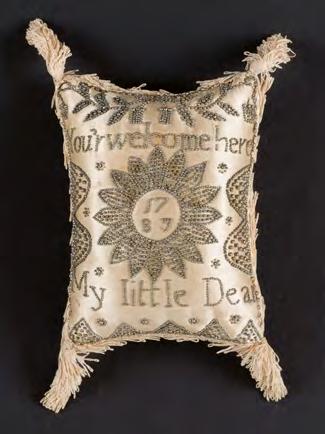
£200 - £300

467* Sewing. An 18th century pinwork pincushion, rectangular cream silk satin, with the words ‘Source of many /A tender fear/Little Stranger/Wellcome here’, on a ground of scattered pins, wavy line border, and stylised flower stem at each corner, backed with a portion of cream silk satin hand-embroidered in bright silks with floral stems (probably Chinese), pale pink fringed edging, 17 x 10 cm (6.5 x 4 ins), together with 3 other pinwork pincushions: ‘Welcome Sweet Babe’ on red and gold brocade; ‘Welcome Sweet Babe’ on cream damask edged with hand-made lace; and a late 19th century sailor’s sweetheart pincushion, with a heart in the centre, ‘Forget Me Not’ and ‘God Save the Queen’, and anchors, plus a finely knitted cream pincushion, the pattern forming the words ‘From A Friend Liverpool 1844’
(5)
466* Sewing. A pinwork pincushion, 1787, rectangular cream silk satin, the date within a sunflower head on a ground of scattered small flowers, with the words ‘You’r welcome here’ above and ‘My little Dear’ below, leaf garland tied with a tasselled bow to top edge, and patterned borders to lower edge and sides, a few fox spots, later cream fringing to edges, 15 x 10 cm (5.5 x 4 ins)
£200 - £300
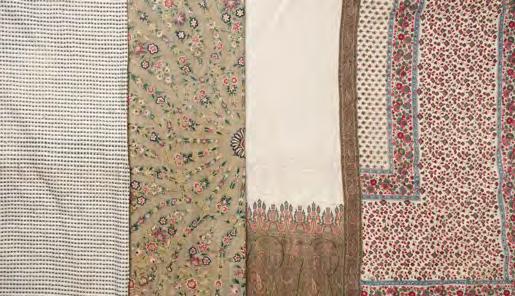
468* Shawl. A Dehliwork shawl, circa 1850s, hand-embroidered overall with polychrome flower and foliate motifs, forming fleurons and botehs radiating from a central large flower, and forming a wide border with boteh cornerpieces, soiled and with scattered small holes, sometime backed with grosgrain beige cloth to form a slightly larger panel or bedcover, 150 x 155 cm (59 x 61 ins), together with 3 other shawls, 2 woven (one a cream stole with botehs), and the other printed
Provenance: Private Collection, Derbyshire.
(4)
£100 - £150
Provenance: Purchased by the owner at auction in 2014 when it was sold by the descendants of Cornelius Cayley (1762-1836) and his wife Sarah (1763-1846); the cushion was made in celebration of the birth of their daughter Anne Elizabeth (1788-1871). (1)
£200 - £400
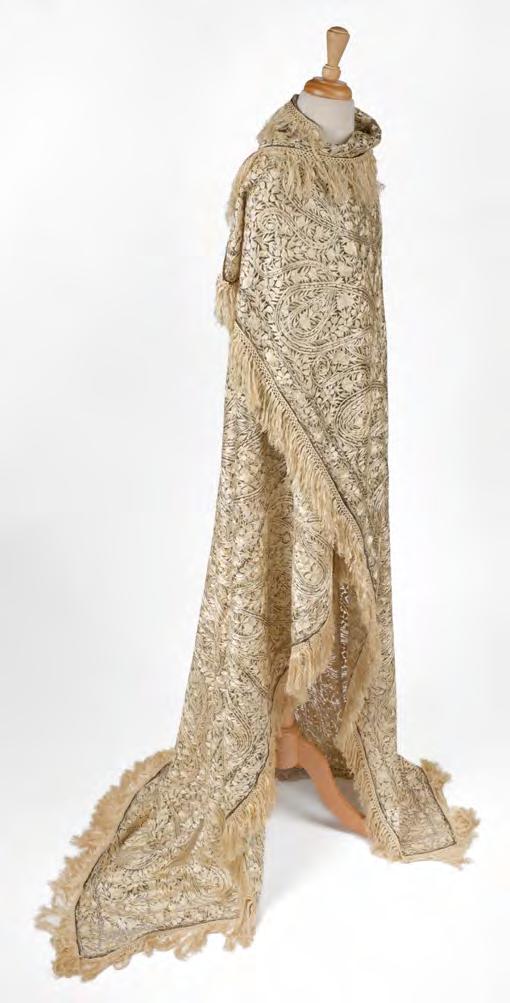
469* Shawl. A fine Indian Delhi shawl, mid 19th century, ornately hand-embroidered in cream silk floss to a black net base, with central sunburst and floral roundel, surrounded by an inner and outer border of botehs on a floral ground, knotted fringe edging, a few tiny faint brown marks and 1 or 2 short loose threads, but overall in very good condition, size excluding fringe 178.5 x 159 cm (70.25 x 62.5 ins)
Provenance: Property of a military gentleman who joined the 2nd Bengal European Cavalry in 1839 (he served in the Punjab Campaign in 1848 and 1849, and at the Siege of Delhi in 1857, and saw action at Hindon and BasilKa-Serai); thence by family descent.
(1)

470* Shawl. A Regency shawl embroidered with the Prince of Wales’s feathers, early 19th century, fine yellow silk, one corner hand-worked in coloured silks, with touches of chenille, in shades of white, pink, green, and yellow, depicting floral sprays (including heart’s ease) emanating from three white ostrich feathers, above a floral and foliate garland, shortest sides fringed, becoming threadbare and frayed in a few areas, some small light marks, embroidery size 32.5 x 38 cm (12.5 x 14.75 ins), shawl size 154 x 159 cm (60.5 x 62.5 ins)
During the Regency period, the Prince of Wales’s feathers were a prominent motif, appearing on various objects, such as furniture and soft furnishings, as well as in fashion, as a nod to the then Prince of Wales, George Augustus Frederick, later Prince Regent (1811-1820) and subsequently King George IV (1820-1830).
(1)
£200 - £300
£150 - £250

471* Shawl. A Spitalfields changeable silk shawl, circa 1820-30, damask silk, woven with a large pattern of meandering flowers and leaves in purple and red, with striped border incorporating yellow, green, and pale pink, some minor mottling to centre, and a few very small marks and holes, short fringe all round, 138.5 x 138.5 cm (54.5 x 54.5 ins), together with another Spitalfields changeable damask silk shawl very similar, woven with squares of alternating floral motifs in raspberry and olive green, and striped border incorporating yellow and pale pink, 2.5 x 1.5 cm frayed section 15 cm from one edge, short fringe all round (2 opposing edges beginning to recede slightly with some associated fraying), 143.5 x 143.5 cm (56.5 x 56.5 ins), plus 2 other Spitalfields changeable damask silk shawls, one with meandering lily pattern in peach and orange, some small darns, 132 x 130 cm (52 x 51 ins), and the other with large flower sprigs in pale blue and gold, with yellow border, some edge-holes and occasional marks, 132 x 143 cm (52 x 56 ins) (4) £200 - £400
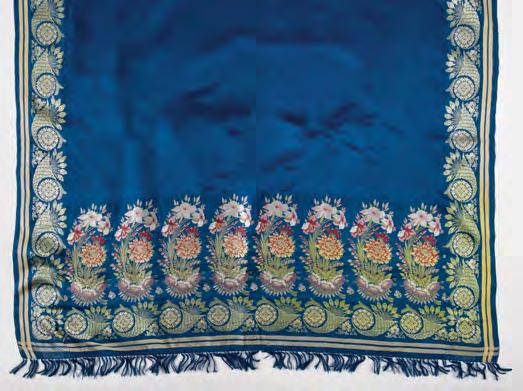
472* Shawl. A Spitalfields silk stole, circa 1810-20, large royal blue silk stole, the deep end borders woven in shades of green, pink, red, lilac, white, and yellow, with flower sprays, border all round of cornucopia containing poppy seedheads woven in predominantly green and yellow, double yellow line outer border, fringed to short ends, a few small faint marks, but overall in very good condition, 74 x 266 cm (29 x 104.5 ins) (1) £300 - £400
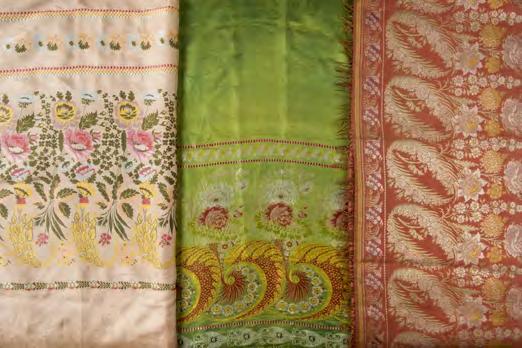
473* Shawl. A Spitalfields silk stole, circa 1810-20, deep cream silk, the wide end borders woven in shades of pink, blue, lilac, green, and yellow, with flower and leaf sprays, with a narrow foliate border above, and a floral border between chequerboard borders below, a few small marks, 63 x 259 cm (25 x 102 ins), together with:
A Spitalfields silk stole, circa 1810-20, lime green silk, the deep end borders woven in shades of terracotta, yellow, and white, with repeated flower sprays above repeated large shell design composed of flowers and leaves, narrow borders top and bottom, one long edge turned over and hemmed by hand (concealing striped border), 13 cm section of other long edge frayed, with some consolidating stitches, 38 x 267 cm (15 x 105 ins), plus:
A Spitalfields large silk stole, circa 1810-20, terracotta silk, the deep end borders woven in shades of pale pink, green, white, and yellow, with large rose sprays, between narrow floral borders above and below, yellow line border all round, fringed to short ends, one small closed tear (1 x 1 cm) and some scattered tiny holes (one with a pulled thread), some mottled fading and marks, 83 x 263 cm (32.5 x 103.5 ins) (3)
£200 - £400
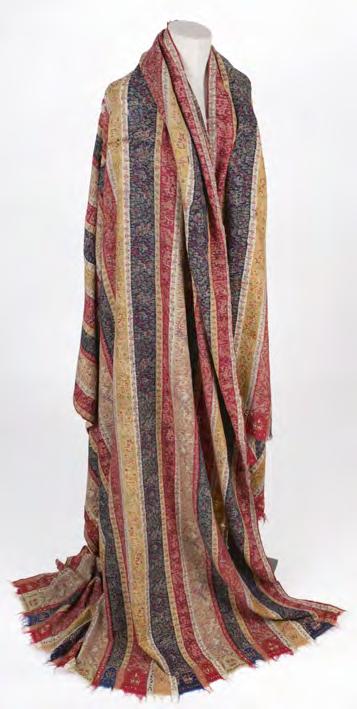
474* Shawl. A striped long shawl (Khatraaz Dochella), probably North India, early-mid 19th century, woven wool shawl, with alternating wide and narrow patterned stripes in dark blue, red, yellow, and pale green, hand-embroidered harlequin gates to short ends (with remains of short fringe), worn, with scattered holes and darns, including a long crudely-stitched repair horizontally across centre, long sides sometime edged on verso with hand-stitched fabric tape, 305 x 134.5 cm (120 x 53 ins) (1)
£300 - £500
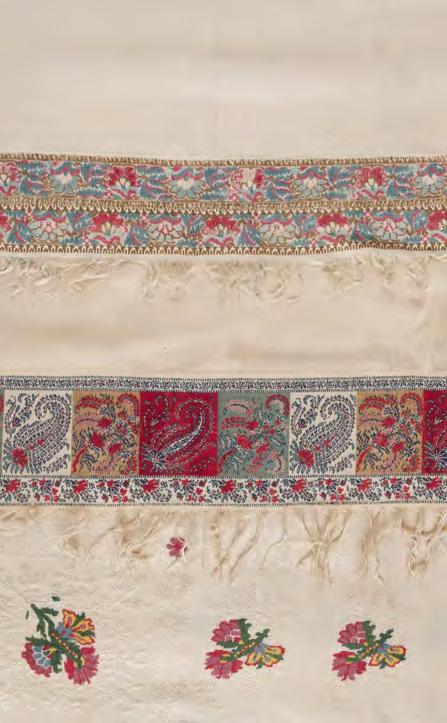

475* Shawl. A woven square shawl, possibly Norwich, circa 1830, figured cream silk shawl, with wide double border of floral repeats woven in pink, blue, green, and yellow, fringed to opposing edges, dimensions excluding fringe 134.5 x 134.5 cm (53 x 53 ins), together with 2 turnover shawls with cream silk ground, the first with inner and outer border of botehs and palmettes respectively, woven in pink, blue, and brown wool, a few tiny holes and marks to ground, border becoming threadbare in places and with some small holes, 2 adjacent edges fringed, 137 x 141 cm (54 x 55.5 ins), and the other with a border of alternating boteh and floral squares, ground with some light stains and small marks, all edges fringed, 115.5 x 114.5 cm (45.5 x 45 ins)
(3)
£200 - £300
476* Shawl. An embroidered Kashmir shawl, early-mid 19th century, soft cream shawl, in a herringbone weave, finely handworked in cream thread with a wide scrolling floral and foliate border, the motifs repeated in a lozenge shape at each corner, short fringe all round, several scattered small holes and marks (largest hole 1 x 3 cm), 172.5 x 160 cm (68 x 63 ins) excluding fringe, together with 2 other shawls: a woven shawl with pattern of small botehs, 90 x 94 cm (35.5 x 37 ins), and an embroidered cream silk shawl, with scattered small holes, 98 x 92.5 cm (38.5 x 36.6 ins)
(3)
£200 - £300

477* Shawl. Two large pashmina panels, Kashmir, circa 1815-20, very finely woven pashmina wool, in shades of predominantly red, blue, and green, the main ground filled with rows of small botehs between pairs of floral sprigs, with a border to 3 sides of large botehs on a ground of floral stems, some minor wear (mostly to trimmed edges), sometime hand-stitched to a slightly larger backing of stiffened blue fabric, folded over to front on one edge forming a 5.5 cm border, together with a matching panel similar, with some later machine-stitching, worn in part (particularly to one end), each approximately 161 x 163 cm (63 x 64 ins)
Provenance: Private Collection, Derbyshire.
For similar see V&A accession number IS.96-1948: ‘This shawl was made at a time when Kashmir shawls were becoming very popular in Europe, but before western taste had completely taken over the designs. The busy rows of butis (floral motifs) over the entire field suggest that it was probably made for the western market. Indian paintings of the time show shawls with butis only in the end border. They were worn by both men and women.’ (2)
£500 - £800
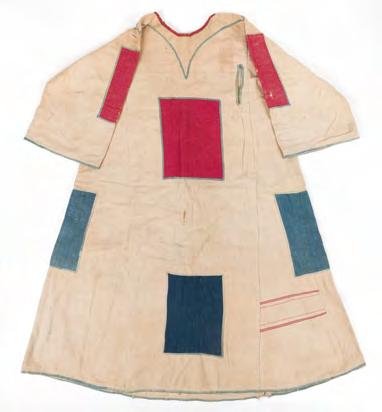
478* Sudan. Two Sudanese jibbas from the Madhist State era, circa 1880s-1890s, 2 A-line tunics, of cream linen (one coarse), with round neck and straight sleeves, each applied with blue and red rectangular panels of cloth with decorative lines of stitching and pale blue edging, round necks with ‘v’ design in blue and red, sleeve edges, hem, and breast pocket to one tunic bound in blue, lined with linen, generally toned and marked, worn in places (including some historic insect damage to one), similar sizes: approximately chest 53 cm (20.75 ins), sleeves 45 cm (17.75 ins), length 110 cm (43 ins)
Provenance: Penfold family, Durrington Rectory, Sussex (used for dressing up circa 1900); Private Collection, Derbyshire.
See V&A (accession number CIRC.563-1967) and British Museum (e.g. museum number Af1909,0315.4) for similar.
A pair of rare tunics known as jibbas, from the period of the Mahdist State in Sudan. In 1881 Sufi leader Muhammad Ahmad bin Abdullah (later Muhammad al-Mahdi) led a movement of rebels against the OttomanEgyptian ruling class of Sudan, gaining control of Khartoum in 1885. He died shortly afterwards, but the Mahdist state survived until 1898, when it was terminated by Anglo-Egyptian forces. Jibbas developed from a form of dress, known as muraqqa’a, worn by the Mahdi’s early followers. These were ragged patched garments worn by dervishes (literally ‘poor men’) who were followers of Sufi religious orders, and their garb symbolised their rejection of worldly goods. However, as the Mahdi state became more established it was decreed that the dervishes should be re-named ansar (‘helpers’) and the muraqqa’a became the more formal jibba, with decorative rather than functional patches, reflecting the changing ideology of the Madhist State from predominantly religious zeal to military and political expediency. The slightly differing styles of the jibba is believed to reflect the regional affiliation of the wearer.
(2)
£300 - £500
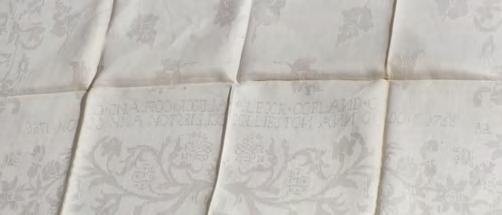

479* Table Linen. A large damask tablecloth woven for Margaret Copland Blair, 1797, white damask linen cloth, woven with patterns of vines and bow-tied bunches of barley and wheat, incorporating name and date at short ends ‘Margt Cod Blair 1797’, a little faint discolouration in one or two places, but overall in very good condition, 214 x 395 cm (84.25 x 155.5 ins), together with 16 other items of table linen, various condition, some browned, and/or with holes and period darns, comprising: 6 other large 18th century damask linen tablecloths, 2 of the same pattern incorporating names and date ‘Alexr Copland of Collieston Ann Gordon 1766’; a set of 9 large 18th century napkins, matching the latter 2 cloths, lettered ‘Alexr Copland ... 1766’ as before, 2 with initials stitched to one corner, approximately 98 x 86 cm (38.5 x 34 ins); and one other 18th century napkin slightly smaller, woven with armorial crest in centre, depicting a knight in armour holding a crown in his left hand and a sabre-like sword in his right, with lettering ‘Vici’
Alexander Copland of Colliston (1701-1774) married Ann Gordon (1707-1783), the only daughter of Sir Thomas Gordon of Earlston, in 1735. Margaret Copland (1739-1824) was the only child of Alexander and Ann; she married Alexander Blair of Dunrod who died in 1771 aged just 27.
The quality and quantity of table linen held by a household in the 18th century said a great deal about the wealth and status of a family. Household inventories of the time often listed more napkins and tablecloths than sheets and pillowcases, and such items, accumulated by families and carefully preserved and repaired over many years, were passed down the generations. Even so, it is unusual for so many early items from one family to come onto the market.
(17)
£200 - £300
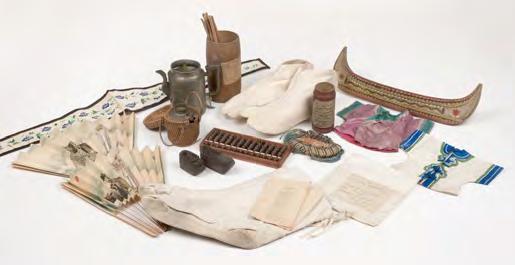
480* Taiwan. A collection of items relating to the English Presbyterian Missionary Society, late 19th/early 20th century, including: 2 hand-painted folding paper fans mounted on bamboo sticks, each depicting 2 figures, accompanied by a manuscript note: ‘My father acquired these fans when he was in Formosa in 1907. I believe they are symbolic representations of Rev. W. Maxwell at work in Formosa. I thought they might be of interest. M.A.U. Macalister’, pivots broken; a printed booklet titled in manuscript on front wrapper ‘Exhortation agst footbinding’; several miniature Oriental garments; a fortune-teller’s cylinder (with manuscript note on side); a child’s rice bowl; several wall hanging scrolls; a wooden abacus; a hand-stitched cotton pillowcase with manuscript note attached ‘12 A pillow-case with tapes Name Binapani Debi Age 11 years Address Boalia Mission Girls’ School Rajshahi’; neck pillows; a cylinder containing sticks labelled ‘Bamboo Vase & divining sticks’, etc., various condition (somewhat dusty) and sizes, contained in a vellumcovered trunk, lined with blue silk, with metal handles and clasp, height 27 cm (10.5 ins), width 63 cm (25 ins), depth 39 cm (15 ins) Provenance: Private Collection, Derbyshire (purchased by the owner in an antique shop in Portsmouth 65 years ago).
This collection of items was part of a travelling exhibition, which was taken on tour in a covered waggon to parts of Britain in order to raise money for the English Presbyterian Missionary Society. For related items see lot 311 sold in these rooms: Antiques & Historic Textiles Sale, 17th October 2024. (1) £150 - £200

481* Tapestry. A 19th century tapestry curtain with hunting scene, woven in greens and browns with a verdant landscape, depicting hounds baying at a large stag in the foreground, flanked by poppies and tulips, another dog crossing a steam, and a mounted huntsman galloping behind, a turreted edifice visible between trees, faded, threadbare in places, 2.5 x 2.5 cm hole near centre, interlined, and backed with olive green cotton (faded, and edge-worn, with loss to left-hand side), curtain rings sewn to top edge (several missing), drop 214 cm (84 ins), width 120 cm (47.25 ins), together with a later tapestry panel, woven in browns and greens with foliate stems and branches, wide border to top and sides of roses, tulips, cherries, and acanthus leaves, with large drawer handle quatrefoil cornerpieces, lower edge with scallop shell border (trimmed and hemmed by hand), left-hand edge and upper edge also hemmed by hand (former with selvedge forming turn-in, latter ditto but with hem turn-in irregular, i.e. wider at one end than the other), several small holes towards top, 280 x 123.5 cm (110 x 48.5 ins)
Provenance: Private Collection, Derbyshire. (2) £200 - £300 Lot
482* Textile Samples. A large album of various 16th-19th century samples, approximately 30 album leaves of hand-made paper, interleaved with tissue (one missing), the rectos with carefully mounted textile samples forming a decorative collage, with identifying manuscript labels, including lace, embroidered muslin, brocades, damasks, trims, buttons, silks, printed cottons and woven tartans, etc., e.g. a fragment of 16th or 17th century Italian metalwork embroidery on Chinese silk, examples of 16th-18th century English and Continental lace (Mechlin, Alençon, Carrickmacross, Gros Point de Venise, Bucks, Genoese, Binche, Argentan, Brussels, etc.), 18th century silk damasks (possibly Spitalfields), a fragment of 18th century silk and metallic embroidered fabric, possibly Italian or French, and a Georgian whitework cuff, facing versos mostly with related mounted printed illustrations showing details of textiles and aspects of costume, occasionally with accompanying textile samples, sheet size 40 x 32 cm (15.75 x 12.5 ins), together with a reticella lace chalice veil loosely inserted, circa 1600, with centre linen square embroidered in gold silk threads with a leaf and volute quatrefoil, modern handmade paper-covered album, with appliquéd floral decoration to upper cover, and wooden toggle closures, folio, contained in a linen bag
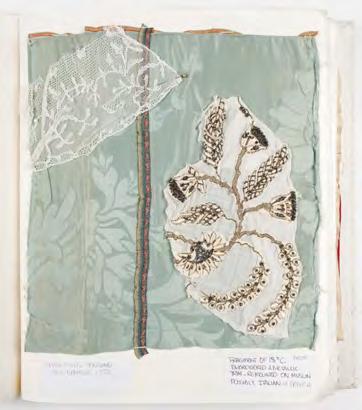
An instructive and beautifully put together album of a wide range of lace and other historic textiles samples. (1)
£400 - £600
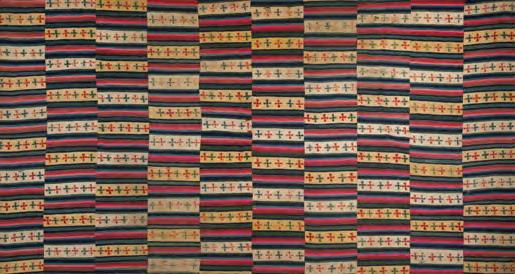
483* Tibet. A Tibetan yak wool shawl or hanging, early-mid 19th century, woven yak wool dyed in hues of red, blue, green, cream, pink, purple, and gold, comprising 10 horizontal panels handstitched together, each with multicoloured vertical stripes alternating between strips of 5 vertical crosses stamp-dyed in red and blue, some fading and small holes, later cotton border machine-stitched to verso of long edges and corners (edge of shawl turned over underneath), border worn away in places, with some consequent edge-fraying to shawl, 231 x 127 cm (91 x 50 ins)
Provenance: Private Collection, Derbyshire.
Rare survival of a hand-woven and stamp-dyed Himalayan textile. (1)
£200 - £300
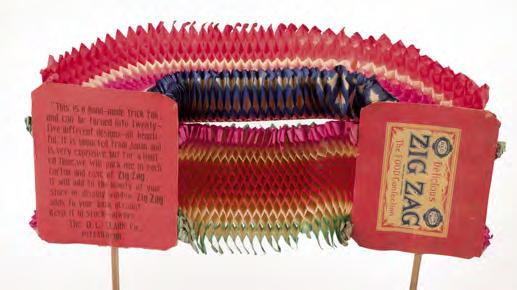
484* Advertising Fan. Zig Zag trick fan for D.L. Clark Co., Pittsburgh, Japan: circa 1910, printed red card covers each on a bamboo stick (one with lower 6.5 cm missing) with coloured honeycombe tissue paper between (slightly creased in places), one cover printed ‘Delicious Zig Zag The Food Confection’, the other with information about the fan, 44 cm (17.5 ins), together with: Twenty-five advertising fans, French, early 20th century, 25 paper fans, comprising 21 colour-printed folding fans (some fontange), and 4 fixed fans (one monochrome), some signed by the artist (e.g. Jean Gabriel Domergue, A. Willette, E. Borne, Marcel Jacques Hemjic, G.K. Benda, Jack Roberts), one advertising the Taverne Pousset depicting frolicking juvenile pierrots, all mounted on wooden sticks, various condition and sizes
A rare survival, made in Japan for the D.L. Clark Co. in the US. Founded in 1886, the company manufactured various candy including the popcorn, nut, and molasses confection named ‘Zig Zag’. These fans were designed to improve shop displays, and therefore sales, of the confectionery: ‘“This is a hand-made trick fan, and can be turned into twenty-five different designs—all beautiful. It is imported from Japan and is very expensive, but for a limited time, we will pack one in each carton and case of Zig Zag. It will add to the beauty of your store or display window. Zig Zag adds to your bank account. Keep it in stock—always. The D.L. Clark Co., Pittsburgh.”’ (26) £150 - £200
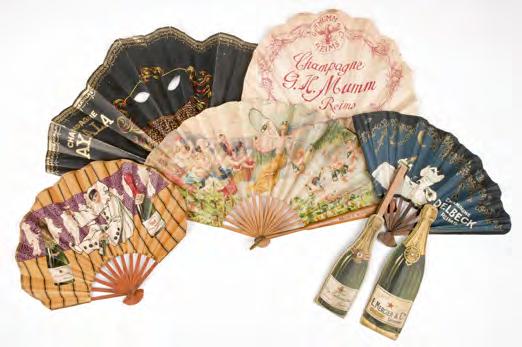
485* Advertising Fans. A collection of fans promoting champagne, French, early 20th century, mostly folding, including palmette and fontange fans, most colour-printed, but also including several hand-painted fans made in and imported from Japan, advertising various champagne brands, including Moet & Chandon, Heidsieck & Co., Krug & Co., Binet Fils & Co., Perrier-Jouët, Montebello, Delbeck, Henry Goulet, etc., some signed by the artist (e.g. Paul Colin, Edouard Halouze, A. Lopez, Maurice Leloir, L.P. Régent), including a fan in the shape of a champagne bottle which opens out to reveal a circle of honeycomb crêpe paper, and a blank menu card of like form (with folding card in centre), all mounted on wooden sticks (except latter), various condition and sizes (41) £200 - £300
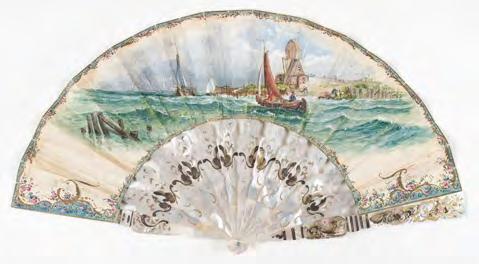
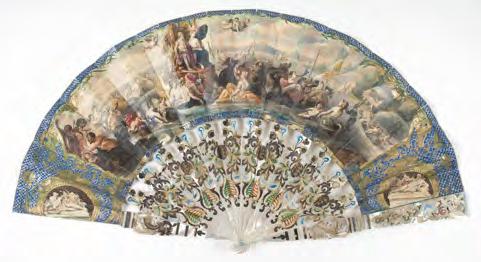
486* Allegorical Fan. Neptune and Amphitrite enthroned in their sea kingdom, Dutch, circa 1840, double-sided fan, the obverse with a hand-coloured lithograph of Neptune and Amphitrite seated on a throne flanked by flying putti and looking down on a host of cavorting nereids, tritons, and other creatures, on a blue ground, painted with latticework in silver, engraved roundels of sculptures to left and right within a gilt frame, some neat paper repairs and retouching to upper portion of folds, the verso painted with a watercolour and gouache seascape of sailing boats (2 flying the Dutch flag) and an elevated wooden look-out, and a scrollwork and floral border, mounted on gilded and painted filigree mother of pearl sticks depicting shells, fish, and a scorpion, gilding intermittently tarnished, 29 cm (11.5 ins), contained in an ivory silkcovered cardboard fan box (soiled and a little worn), with Duvelleroy’s label inside lid, together with 3 other 19th century folding fans mounted on filigree mother of pearl sticks, one with a leaf of chicken-skin painted in watercolour with a romantic historical scene of ladies and a gentleman in a garden, one of the ladies holding a fan, and the other two each with a hand-coloured lithograph depicting a bucolic scene of young ladies and gentlemen, one with a watercolour riverscape on the verso (one stick broken), and the other painted in silver to verso with fern fronds and a border (guard sticks repaired), each in a fan box (that to final fan missing lid) (4)
£200 - £300
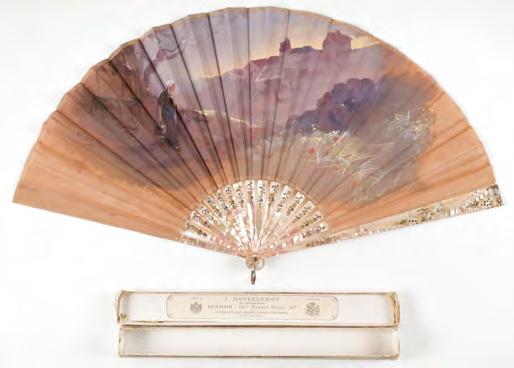
487* Billotey. Painted folding fan, J. Duvelleroy, circa 1890, the fabric leaf painted in gouache, with a rustic maiden wearing a white bonnet and carrying a water pail, standing in a landscape with wild flowers and trees, and dwellings on the hills beyond, signed ‘Billotey’ to left-hand side, mounted on mother of pearl sticks, with pierced floral decoration in silver and gold, the ribs of bone, 35 cm (13.75 ins), housed in the original cream silk-covered fan box (silk fraying), with printed label inside lid of J. Duvelleroy, London, together with another folding fan with a hand-painted fabric leaf, depicting a young lady standing on a cliffside overlooking the sea, waving a handkerchief, some folds starting to split, mounted on mother of pearl sticks, 34.5 cm (13.5 ins), contained in a Noble Jones fan box
See The Fan Museum for a similar painted fan signed ‘Billotey’: object number LDFAN1989.20.
At least three generations of the Billotey family were artists, and more than one of them appears to have painted fans. Valérie-Aline Colombo-Billotey (1860-1935) is thought to have been the most prolific fan painter in the family. Known simply as ‘Mme Billotey’, she typically painted fans in dreamy pastel colours with flowers, birds, and butterflies, and worked mainly for leading fan maker Duvelleroy.
(2)
£200 - £300
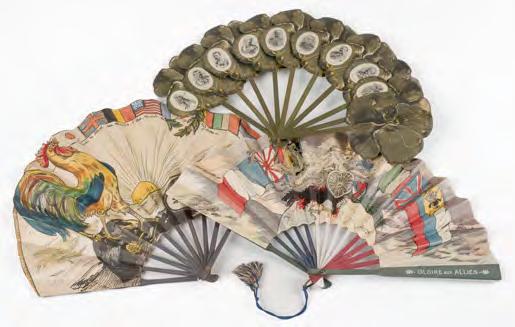
488* Boer War. A commemorative palmette or Jenny Lind fan, circa 1900, the leaf composed of ten green embossed paper pansies backed with cloth, final pansy forming guard, each of remainder with an oval photographic portrait of a Boer War commander, except the first and penultimate (‘A Gentleman in Khaki’ and ‘The Handy Man’), a few light creases, mounted on green-painted wooden sticks, tassels to loop, 24 cm, (9.5 ins), together with: WWI. Après le Déluge des Atrocités, l’Arc-en-ciel de la Gloire, Paris, Paris: Faucon, circa 1918, folding paper fontange fan, the leaf with hand-coloured illustration signed Cam’ Boulanger, of a large crowing cockerel (France) standing on a helmet, shield, and sword (Germany), the rising sun in the distance bearing the dates 1914-1918, top margin with a laurel leaf and rainbow of flags, cockerel’s comb a little creased, mounted on blue-painted wooden sticks, 28 cm (11 ins), plus another the same (slightly rubbed and stained), and: Gloire aux Alliés, Paris: Faucon, [1915], folding paper fan, with chromolithographed illustration signed B. Bataille, of Victory and a cannon in the centre, with flags of the allies on either side, ‘Souvenir Hotel Mirabeau’ ink stamp on verso, mounted on tricolour wooden sticks, tassels to loop, 21 cm (8.25 ins), plus 2 other WWI fans, one depicting flags of the Allies and advertising Henri D’Orleans champagne on verso, mounted on purple-painted wooden sticks, 19 cm (7.5 ins), and the other with the linen leaf hand-painted with a red, white, and blue rosette, and the date 1918 in red, mounted on pierced wooden sticks, with faux tortoiseshell guard sticks, 19 cm (7.5 ins)
The portraits are as follows: MacDonald; French; White; Roberts; Buller; Kitchener; Baden-Powell. Possibly produced to raise money for the war effort.
(6)
£200 - £300

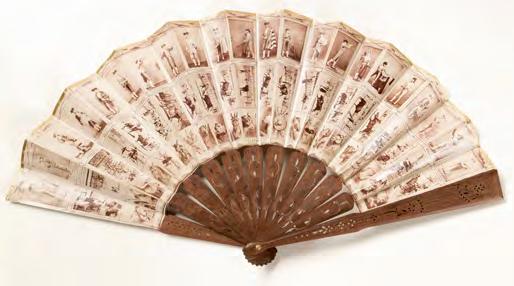
489* Bullfighting Fan. A double-sided lithographed fan with scenes of bullfighting, Spain, circa 1850s, hand-coloured lithographed folding paper fan, the obverse with 3 oval scenes of bullfighting, within a gilt-painted pen & ink frame of beribboned flower garlands with various trophies at intervals, on a pale blue ground, some minor splitting at folds (one fold to left-hand side a little chipped), the verso with a pastoral scene of peasants carousing, within a gilt-painted strapwork and volute frame, mounted on pierced mother of pearl sticks inlaid with steel dots, guard sticks a little chipped, 27 cm ( 10.75 ins), housed in an embossed cardboard fan box (broken with losses), together with: A Los Toros, de Los Toros, Madrid & Paris: J. Laurent Y Cia, circa 1880s, double-sided folding paper fan, the obverse with sepia lithograph depicting horse-drawn vehicles and crowds thronging outside the Plaza de Toros, some show-through from ribs, the verso with photographs of bullfighters (named below) and images of their conquests, mounted on pierced dark wood sticks, 25 cm (10 ins), housed in a contemporary paper-covered fan box
491* Decorative Fan. A hand-painted fan depicting children and birds, circa 1870, gouache on gold silk, depicting 3 small children and 2 brightly coloured birds amongst leafy fronds, folds lightly rubbed (and a few beginning to fray in places), mounted on lavishly gilt decorated wooden sticks, 33.5 cm (13.25 ins)
A striking and unusual fan, somewhat in the style of Eleanor Vere Boyle. (1) £150 - £200
Second item: Schreiber Collection 298 and 299, p.114 (unmounted, handcoloured, and with no mention of bullfighters on verso). (2)
£200 - £300


490* Decorative Fan. A hand-painted and pierced lace paper fan, circa 1800, folding paper leaf of pierced lace paper alternating with stripes of watercolour flowers in pale and dark blue, and gilt flowers (browned from acid burn), within a blue and gold painted floral border, some light discolouration and foxing, 1 or 2 small holes, small paper repair on verso (approximately 1 x 1.5 cm), mounted on pairs of alternating blue floral painted or filigree bone sticks (one of the latter with 2 splits strengthened on verso), guardsticks carved with a figure, pair of birds, and an urn, and highlighted in blue paint, small area of surface loss to upper guard, 26.5 cm (10.5 ins), housed in the original Dutch floral papercovered cardboard fan box with pull-off lid (1)
£300 - £400

492* Decorative Fan. A spangled painted fan, Paris: Benjamin Lachelin, circa 1900, fontange folding fan, the fabric leaf handpainted with a pair of hummingbirds amongst flowers and leaves, lavishly decorated with gold circular and star-shaped spangles, joined with lines of chain stitch in gold metallised thread, mounted on gilt-ribbed mother of pearl sticks, 35 cm (13.75 ins), housed in original morocco-grain paper-covered cardboard box, with maker’s name lettered in gilt inside lid, box a little worn in places, together with 4 other hand-painted folding fabric fans, 2 mounted on bone sticks (one depicting a song bird and flowers, several folds splitting; the other depicting swallows and butterflies, on pierced and engraved sticks, one fold splitting, boxed), the third mounted on mother of pearl sticks, depicting a dragonfly and a butterfly in a sunset landscape with flowers, trees, a rustic fence, and a building in the distance, upper guard stick with pierced and engraved decoration, one stick broken and detached (with consequent repair to fan), loop with large cream silk and gold metallised thread tassel, housed in original Alexandre (Paris) box, and the fourth painted with dog roses and butterflies on a peach silk leaf, mounted on wooden sticks shaped and painted to resemble branches, upper guard stick with break (and consequently near-detached from leaf), each approximately 35 cm (13.75 ins) (5)
£150 - £250
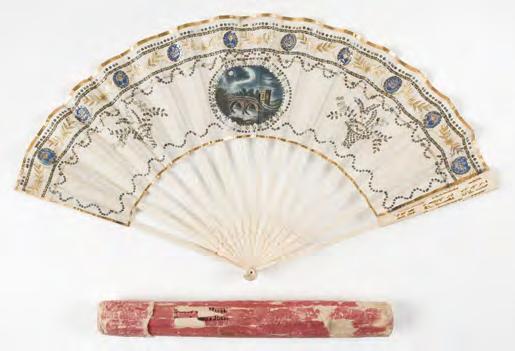
493* Decorative Fan. Hand-painted fan with spangles, [Mrs Catherine] Clarke, Fan Maker, circa 1780, folding paper leaf, with hand-painted oval in centre depicting a church tower beside a stone bridge at night, enclosed in a border of tiny silver spangles, some in the shape of flowers, and flanked by flower baskets composed of spangles as before, the whole within a wavy line border of the same, upper edge with border of hand-painted ovals depicting flower urns and floral motifs on a blue ground, between gold painted pen & ink flower and leaf swags, spangle borders to ovals and top edge, gilt-edged to top, left and right-hand edges each with 2 folds expertly strengthened on verso with archival tissue, occasional loss of spangles (mainly to top edge), mounted on filigree bone sticks, 27 cm (10.5 ins), housed in original pastepaper-covered cardboard case with pull-off lid, inkstamped ‘Clarke Fan Maker. No 45 Ludgate Hill’, rubbed, with some surface losses
Mrs Catherine Clark of Ludgate Hill was a prominent 18th century fan maker, operating out of Ludgate Hill at least as early as 1776 (the British Museum has a bill from her thus dated in its collection - registration number Heal, 60.2). She was admitted to the Worshipful Company of Fan Makers in 1769, and is immortalised as a short stout lady in an etching by John Nixon titled ‘Mrs Clark, Fan Maker, Ludgate Hill’. Fans by her are rare, particularly so in the original case.
(1)
£300 - £500
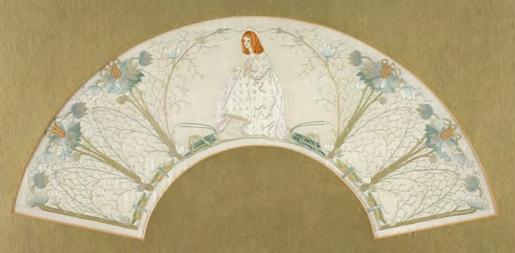
494* Glasgow School. An unused embroidered fan leaf, circa 1910, professionally hand-stitched on cream silk, using long and short, stem, satin, and chain stitches, and french knots, depicting a maiden with red hair wearing a flower-sprigged gown standing in a garden, flanked by tall stylized stems of love-in-a-mist, and at her feet by a cricket and 2 moths on either side, 11 x 41.5 cm (4.25 x 16.25 ins), period gold mount and glazed frame (33.5 x 56 cm)
Clearly the work of a professional needlewoman, this expertly-executed piece is akin both in subject and form to other embroideries produced by women working at the Glasgow School of Art in the early twentieth century. Helen Adelaide Lamb, Ann Macbeth, and Elsie Fraser were three of the women working in this manner at the end of the 19th century and the beginning of the 20th century. In 1885 Francis H. Newbery became director of the Glasgow School of Art. He was closely connected to the Arts and Crafts Movement, and was particularly influenced by the work of Charles Rennie Mackintosh. Under his leadership a new style was developed at the School, in which students were encouraged to branch out from traditional design mores, and develop their own individual styles, embroidery being one of the subjects taught. Jessie Newbery was appointed head of the Department of Embroidery in 1894, and her influence was also pivotal. In 1910, the British art journal, The Studio, summed up the embroidery style of the Glasgow School of Art as follows: ‘It is not founded on tradition and has no resemblance to any style that preceded it. The new embroidery is common in this respect to the oldest arts, it takes the everyday things of life, and by a simple individualistic process seeks to make them beautiful as well as useful.’ (Volume 50, 1910)
(1)
£200 - £300
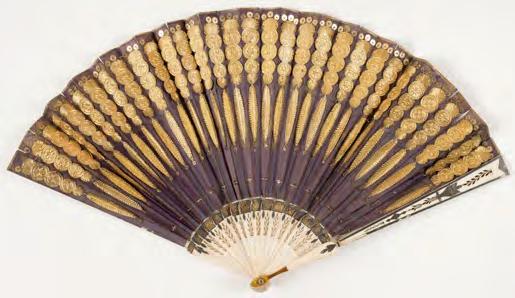
495* Greek Revival Fan. A decorative fan, circa 1790-1810, folding leaf of indigo silk, with onlaid and stitched embossed gold motifs and spangles, some splitting to folds, mounted on bone sticks (slightly bowed), with pierced leaf spray and gilt pineapple skin pattern, 24 cm (9.5 ins)
An unusual Regency fan echoing the vogue for classicism in the late 18th and early 19th century. (1)
£200 - £300
496* Historical Fan. The Eruption of Vesuvius at Night, 15th June 1794, Naples, Italy, circa 1794, folding leaf of chicken-skin, handpainted in watercolour and gouache, depicting Vesuvius erupting, with sailing ships and figures illuminated by the furnace, indistinct caption (with small holes) in sepia ink to lower edge ‘Terribile Eruzione et avuto la Sera de 15 Giugno 1794’, lightly rubbed in places, right-hand edge with several closed tears repaired on verso, mounted on filigree bone sticks, the guardsticks carved with figures (upper guard slightly bowed inwards), 28 cm (11 ins), contained in original Dutch pastepaper-covered cardboard fan case with pull-off lid (lightly rubbed)
Depicting the devastating eruption of Mount Vesuvius which occurred between June 15th and July 5th 1794. The lava flowed through the town of Torre del Greco, almost destroying it completely, before continuing out into the Gulf of Napoli forming a new headland. The towns of San Giuseppe, Ottaviano and Somma were completely obliterated, and about 400 people were killed in all.
(1)
£500 - £800
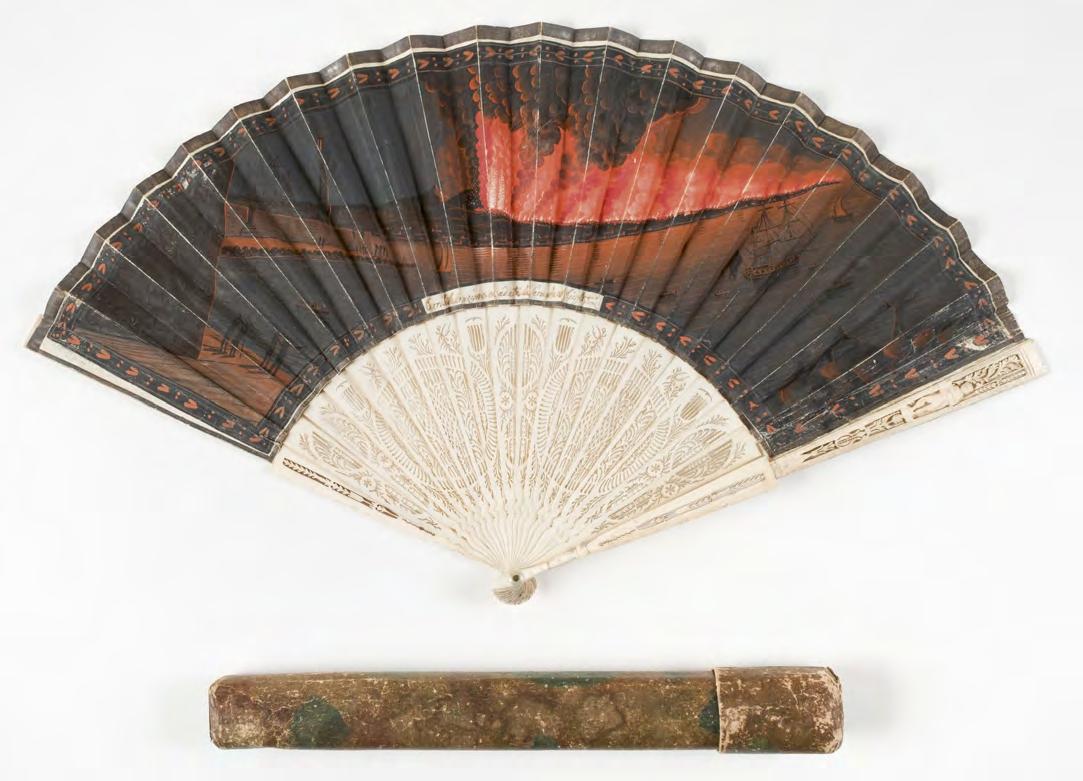

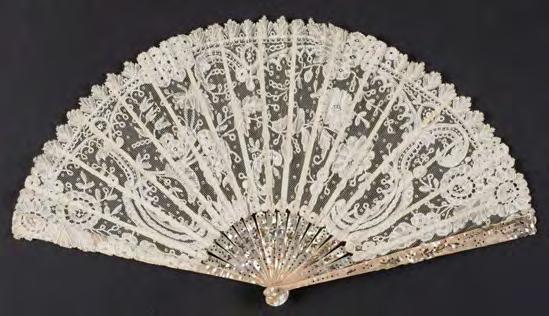
497* Lace Fan. A Victorian Brussels lace fan, the leaf of handmade cream Brussels Point de Gaze lace, depicting a profusion of roses (some with double petal overlay), volutes, and other flowers, mounted on wavy engraved filigree mother of pearl sticks (6 ribs with extreme tip chipped off), upper guard stick inlaid with steel dots, 32.5 cm (12.75 ins), together with:
A Victorian Brussels lace fan, the leaf of handmade Brussels appliqué lace, depicting floral motifs and volutes, mounted on gilt-painted engraved mother of pearl sticks, inlaid with steel dots, one rib replaced, and another with splint to horizontal break, 24.5 cm (9.75 ins), plus 10 other cream lace fans (and one black), including 5 mounted on mother of pearl sticks (one with engraved filigree sticks and contained in a fan box), 3 on decorated bone sticks, and one on faux tortoiseshell sticks (housed in a cream silk Duvelleroy fan box), various condition (some with wear and/or repairs) and sizes, and 11 unmounted lace fan leaves, 9 handmade, all white or cream, except one black (24) £300 - £500
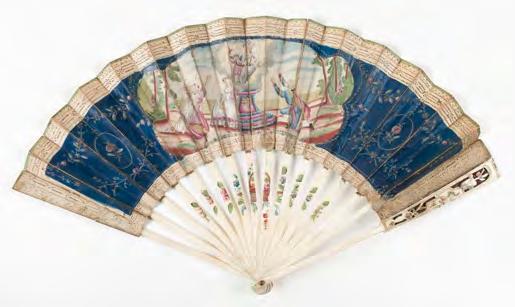
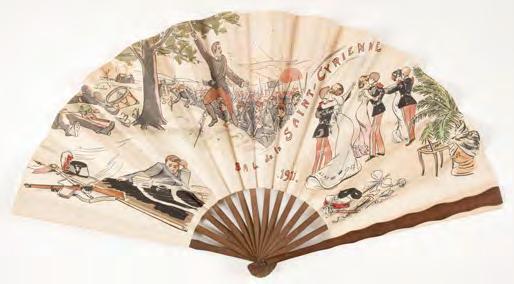
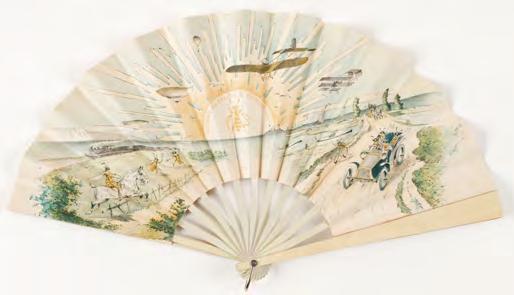

498* Love Token Fan. Alziane, Ou Le Pouvoir de l’Amour, French, circa 1760-1780, folding paper fan, the leaf with large hand-coloured engraving depicting a couple kneeling in supplication at the altar of Love on which Venus and Cupid appear, on a blue ground handpainted with leafy rose garlands, within a painted dot and dash border, verso with 10 stanza poem in French, titled ‘Alziane, Ou Le Pouvoir de l’Amour, Romance par Mr. Déduit. Air de la romance de Daphné.’, rubbed, some splitting and tears, with old repairs in places, verso toned, mounted on bone sticks painted with a flower basket, the guard sticks carved and also painted, 28 cm (11 ins)
A rare fan. We have traced only two similar: one which sold at Christie’s in 1994, and that held in the collections of The Carnavalet Museum, Paris (Inventory Number EV57). (1)
£200 - £300
499* Military School fans. Five fans printed for the Special Military School of Saint-Cyr, France: 1911-1921, 5 folding paper fans, 4 with a hand-coloured lithograph to obverse, 3 advertising a ball, for the years 1911, 1912, 1914 (printed signatures A. Hugues, M. Herreman, M. Ritter respectively), depicting various scenes of soldiers, ladies, and dancing, each with purple ink stamp on verso ‘Bail, Cotillon, Paris’, the other depicting various military accoutrements such as spurs, helmet, boots, water bottle, sword, etc., the letters ‘E S M’ to upper edge and and the school motto ‘Ils s’Instruisent pour Vaincre’ to lower edge, printed signature indistinct, slightly rubbed and 1 or 2 short repaired tears to lower edge, the fifth depicting 8 historical figures from 1686 to 1899, showing the progression from Maison Royale to École Spéciale Militaire, a little rubbed and creased, ‘Maison Bail Cotillon’ label to verso, together with 2 others possibly also related to Saint-Cyr, each commemorating a ball, one designed by Adolphe Thomasse and dated 9 Février 1901 (‘Duvelleroy’ written in red ink on verso), and the other (with images of anthropomorphic wasps driving cars and playing tennis etc.) lettered ‘Souvenir du Bal du 5 Février 1910, each mounted on wooden sticks, each approximately 24 cm (9.5 ins)
The Special Military School of Saint-Cyr (ESM Saint-Cyr), founded in 1802 by Napoleon Bonaparte, is one of the nine major French military schools. (7)
£150 - £200
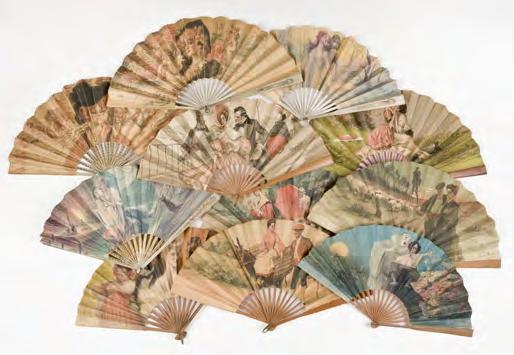
500* Redon (Georges, 1869-1943). A group of advertising fans, ten colour lithographed folding paper fans, each with an illustration by Redon, variously depicting ladies and gentlemen courting, pierrots, fashionable ladies, peasants, etc., all with artist’s printed signature, and name of a cafe or hotel, each mounted on wooden sticks, some gilt decorated, together with another fan similar, unsigned but probably also by Redon, depicting a small naked boy relieving himself into a hat on the ground next to the oblivious female owner, various condition, each approximately 24 cm (9.5 ins) (11)
£150 - £200

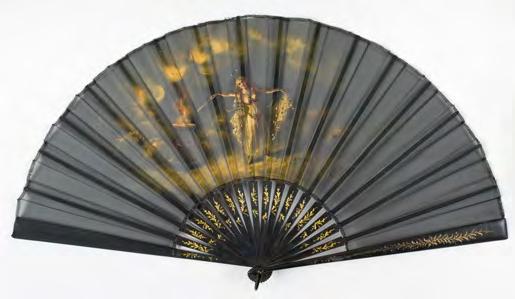
503* Verdevoye (Eugène, 1856-1926). A painted folding fan, the leaf of black gauze, painted in gouache and incorporating tiny spangles (circular, stars, and pointed ovals), depicting an ethereal fairy figure dressed in a bejewelled gown with diaphanous train, wearing a necklace, bracelets, and earrings, pointing a wand at a fire on a plinth, surrounded by bursts of light, signed to right-hand side, 1 or 2 small faint marks, picot border to upper edge beginning to come away in places (and with some re-sewing just visible), mounted on ebonised wood sticks embellished with gold flower and berry sprays, upper guard stick with some inconspicuous (fabric?) residue, 35 cm (12.75 ins)
Rare: we have been unable to trace another painted fan by this apparently little-known but evidently highly skilled French artist.
(1)
£150 - £200
501* Royalty Fan. A fan commemorating Queen Victoria’s Golden Jubilee, 1887, folding paper fan, the leaf hand-painted with 2 crossed Union Jacks, and lettered in ink at the intersections of the flap sticks ‘V R I’ and ‘June 21.1887’, verso sprinkled, mounted on bamboo sticks, ebonised wood guard sticks carved with figures, 28.5 cm (11.25 ins), together with 4 other fans related, comprising: another hand-painted fan, with Union Jack and crown, folds rubbed and with some tiny splits; and 3 Fan Museum souvenir fans (the first depicting Queen Elizabeth II, Prince Philip, and their children; the second commemorating the Queen Mother’s 90th birthday, 1990, upper guard stick slightly bowed, boxed; and the third commemorating Queen Elizabeth II’s Diamond Jubilee, 2012, inlaid with Swarovski crystals, limited edition, 18/60, boxed), plus another limited edition Fan Museum folding paper fan, commemorating the 100th Ladies’ Championships at Wimbledon, 1993, 154/500, boxed, generally in good condition, various sizes (6)
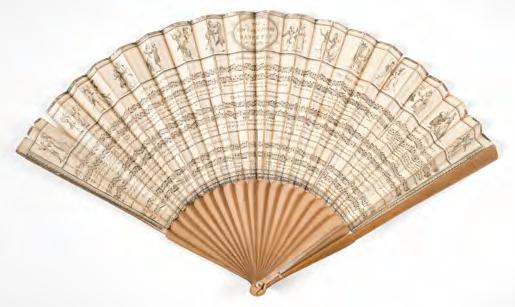
£200 - £300
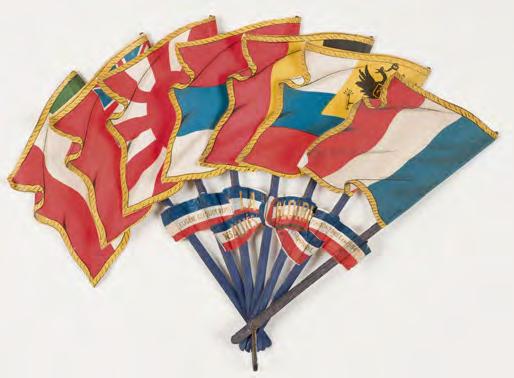
504* WWI Fan. Flags of the Allies, circa 1916, paper fan, the leaf composed of 7 individual colour-printed flags, representing the seven WWI Allies before the USA joined in 1917: Italy, Great Britain, Japan, Serbia, Belgium, Russia, France, a trifle dusty and creased, each mounted separately on the blue-painted wooden sticks, gorge joined by paper resembling a tied ribbon bow, in red, white, and blue, printed in gold with advertising for the champagne producer Eugéne Cliquot, Reims, and the words ‘La Gloire des Alliés’, verso of bow printed in blue with a pair of champagne glasses, and the words ‘Héroïqués Alliés Demandez Partout: une Coupe de “Gloire”’, 22 cm (8.75 ins)
Rare First World War fan, of unusual shape and construction. See Fans: War and Peace exhibition catalogue, Fan Museum, Greenwich, which shows a similar, but later, fan from 1918 which includes the US flag, and not that of Russia (p.227).
(1)
£200 - £300
502* The New Caricature Dance Fan for 1794, Publish’d as the Act directs Novr. 10th. 1793, by Stokes, Scott & Croskey, No 18 Friday Street, folding paper fan, etched with a frieze of 14 caricatures of couples dancing along the top, and musical notation and lyrics for fourteen dances including The Musicians Flight to America, Little Farthing Rushlight, Prince Apolphus Fancy, The Primrose Girl, toned and dusty, folds rubbed and splitting, mounted on wooden sticks, upper guard stick and adjacent stick broken away from pivot (with associated slight loss to tip of sticks), 25 cm (9.75 ins), together with a hand-painted double-sided Japanese fan, depicting birds amongst blossom, 2 folds splitting at head, mounted on bamboo sticks, with painted and pierced bone sticks (rubbed), 33 cm (13 ins) Schreiber Collection 51, p.11. (2)
£200 - £300

505* Egyptian Limestone Funerary Stela. An Egyptian Limestone Funerary Stela, Middle Kingdom, 12th Dynasty, circa 1900 BC, carved in low relief with the figure of the deceased seated on a stool with hooved animal legs, holding a large lotus flower, which she is smelling in her upraised left hand, her right hand just above her knee, wearing a long tripartite wig, a table heaped with offerings before her, vessels below, her son, the lector priest Amenemhat making offerings to his mother, standing in front of the table facing the deceased, carrying a fowl in his left hand, his right hand raised, a small gazelle by his side,.a hieroglyphic inscription above, the text asks for offerings on behalf of the deceased, a woman called Hemet born to the woman Ita, the whole with traces of polychrome-painted decoration, 25.7 cm square Provenance: Sotheby's, London, Middle Eastern, Egyptian, Ancient Jewellery, Greek, Etruscan and Roman Antiquities, 11 July 1988, lot 50; Estate of Martin R. Davies, Bristol. A file of correspondence relating to this work including letters from the British Museum, and Detlev Franke, purchase invoice, Hanna Conservation report, cleaning by Charles Ede, etc. is available from the auction office. (1)
Each lot is subject to a Buyer’s Premium of 22% (Lots marked * 26.4% inclusive of VAT @ 20%)
178
£20,000 - £30,000

506* Egyptian Limestone Talatat Relief. An Egyptian Limestone Talatat Relief, Amarna Period, 18th Dynasty, circa 1350 BC, relief of Sun disc and four columns of hieroglyphic text ‘The great living Aton, Lord of Festival, Lord of evry circuit of the Aton, Lord of Heaven, Lord of Earth in the House of the King’s daughter Meritaton in the House of the Aton in Akhetaton’, 24.5 x 53.5 cm
Provenance: Faustus Fine Art, London, 90 Jermyn Street, London, by April 1988; Estate of Martin R. Davies, Bristol. A file of correspondence and photocopy documentation relating to this work including a letter from Diana Craig Patch of the Metropolitan Museum of Art, New York, and W. Raymond Johnson, purchase invoice, etc. is available from the auction office. (1)
£7,000 - £10,000
507* Egyptian Limestone Talatat Relief. An Egyptian Limestone Talatat Relief, Amarna Period, 18th Dynasty, circa 1350 BC, fragment with two registers and divine offerings, the top register with a man setting up an offering stand next to a group of three single-pedastal repository tables laden with bread and shanks of meat, further along, an amphora and basin set on individual stands appear next to a bound and slaughtered ox, at the extreme right is the left jamb of a broken-lintel doorway festooned with plant buds and blossoms; more offerings of bread and meat are shown on rectangular tables in the register below, the whole painted in modern pink paint, 17.5 x 34.5 cm,
Provenance: Faustus Fine Art, London, 90 Jermyn Street, London, by April 1988; Estate of Martin R. Davies, Bristol. A file of correspondence and photocopy documentation relating to this work, including emails from W. Raymond Johnson, purchase invoice, translation of the hieroglyphs, etc. is available from the auction office. (1) £5,000 - £8,000

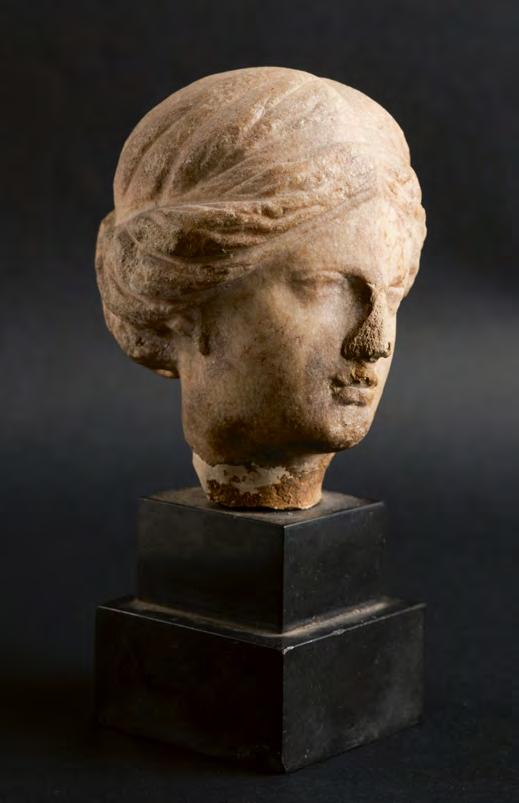
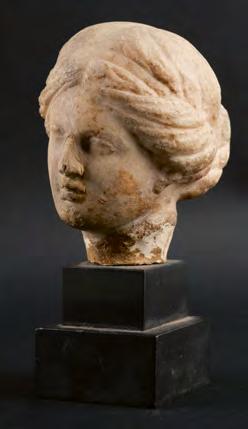
508* Marble Head of a Young Woman, possibly a goddess, Hellenistic or early Roman, circa 2nd century B.C., turned slightly to her left, with parted full lips, a long straight nose, her finely carved wavely hair parted in the middle and twisted up at the sides, tied in a chignon, and with headband, height 9 cm, mounted on a modern black basalt base (overall height 13.5 cm)
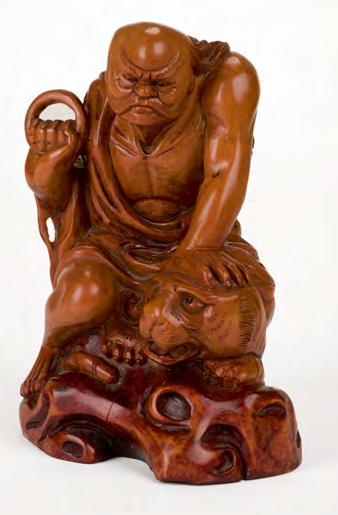
509* Carving. A Japanese root wood carving, 20th century, carved as a buddha holding a ring astride a tiger on an integral natural base, 21 cm high (1)

£80 - £120
Provenance: Private Collection, Berkshire, UK. Possibly by the Pergamene School, or a Roman copy. The pose of the head recalls the bust of Juno Cesi, a larger-than-life-size statue known in Rome since the first half of the 16th century, and likely to have been discovered there. (1)
£2,000 - £3,000
510* Chargers. A pair of Japanese blue and white porcelain chargers, Meiji period (1868-1912), decorated with roses, insects and birds on a white ground, within a repeating geometric border, the underside rim similarly decorated and with stilt marks, 40.5 cm diameter, one with an old chip the underside rim (2)
£150 - £200
511* Chinese dish. A Chinese blue and white porcelain dish, 19th century, of rectangular form decorated with horses in a landscape, 24.5 cm long, together with a Chinese cloisonné set comprising a knife with 15 cm steel blade stamped, wood and bone grip, overall length 24 cm, with bone chopsticks, contained in a cloisonné holder, some loss (2)
£100 - £150
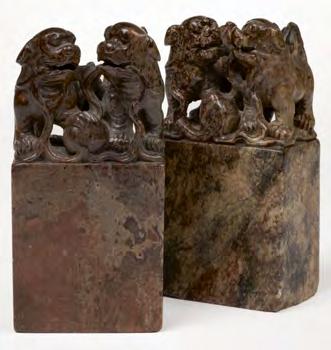
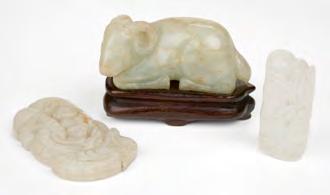
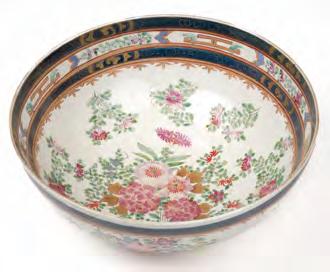
512* Chinese soapstone seals. A pair of carved Chinese soapstone block seals, circa 1900, each with a rectangular base, lightly engraved with floral panels and surmounted by a pair of dogs of Fo, minor damage, 17.5 cm high (2)
£100 - £150
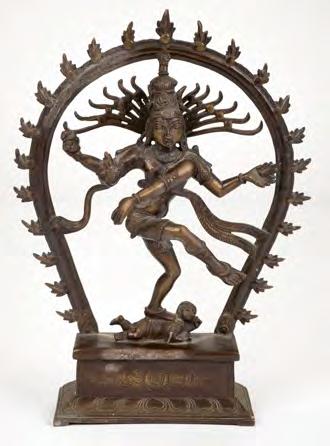
513* Indian bronze. An Indian brass sculpture of Shiva Nataraja, modelled in the traditional style, surrounded by a flaming arch, on an engraved base, 34 cm high x 23.5 cm wide, collection numbers painted on the reverse (1)
£150 - £200
514* Jade. Chinese jade carvings, comprising a recumbent ram, its legs tucked neatly underneath, head turned slightly with pronounced horn, a good natural colour with veins, 8 cm long, presented on a hardwood stand, together with a white jade bamboo carving, 5 cm long, plus a pebble carved as a boy on a dragon, 7.5 cm long (3)
£200 - £300
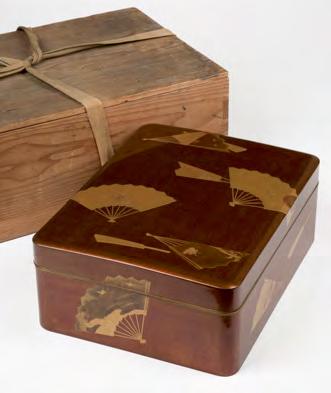
515* Japanese box. A Japanese lacquer documents box, Meiji period (1868-1912), the rectangular box with raised fan decoration on gold and bronze sprinkled ground, the cover enclosing a lift-out tray, 16 cm high x 41 cm wide x 32 cm deep, contained in original pine box (1)
£400 - £600
516* Large Chinese Famille Rose Bowl. A 19th century Chinese export famille rose bowl, hand-painted in polychrome enamels with floral arrangement to the centre, surrounded by foliate sprays and an intricate border to the interior rim, the exterior similarly decorated with floral arrangements and scattered sprigs, palette includes pinks, greens, oranges, and gilt highlights, with cobalt blue and red border bands, 30.7cm diameter (1)
£150 - £200
517* Rice Bowls. A group of 5 Japanese urushi lacquer rice bowls, mid 20th century, each decorated with a gold painted carp on a red ground, the cover and bowl each with gold lacquer interior, 12 cm diameter, with a smaller matching dish (6)
£100 - £150
518* Wu Zhu Coin. Large bronze Wu Zhu Coin replica, 19th century, seal script (zhuanshu) on the obverse reading 'wuzhu', with 'wu' to the right and 'zhu' to the left, unidentified script to verso, raised rim on both sides of inner square and outer rim, 15 cm diameter (1)
£100 - £150
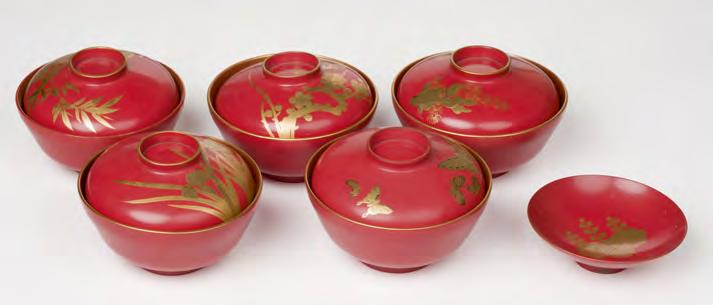
519* Meat serving plate. A Victorian ironstone meat serving plate, decorated in the imari palette in blue, red and gold, the centre with a vase of flowers amongst willows and other floral decoration, impressed number ‘5’ mark to the base, 41 cm long (1) £60 - £80
520* Champagne ice bucket. A Regency cut glass champagne ice bucket, heavy cut glass with everted rim and body raised on a facet cut knop and plain circular foot with star cut decoration, 27 cm high (1) £70 - £100
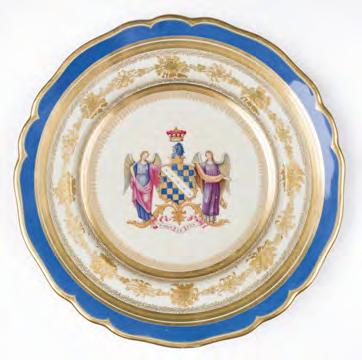
521* Chamberlain Worcester. A Chamberlain Worcester armorial porcelain shaped plate, early 19th century, the centre painted with an armorial flanked by angles with the motto beneath 'Comme Je Fus' (As I Was), within a gilt border with a royal blue rim edge, the base painted in purple 'Chamberlain & Co, 155 New Bond Street', 23 cm diameter, together with a Flight Barr & Barr period porcelain shaped plate, circa 1815, the centre painted with an exotic bird within a landscape on a white ground and beautifully overpainted with gold branches, purple printed mark to base, 22 cm diameter, plus five Davenport porcelain cabinet plates, each painted with a topigraphical landscape and a pierced rim, comprising, a cream and white pair 23 cm, one smaller from the same set, 18 cm and a pair with green and gilt rim, 22 cm diameter
The armorial is for the 10th Earl of Dudley, believed to be John William Ward (1781-1833).
(7)
£100 - £150
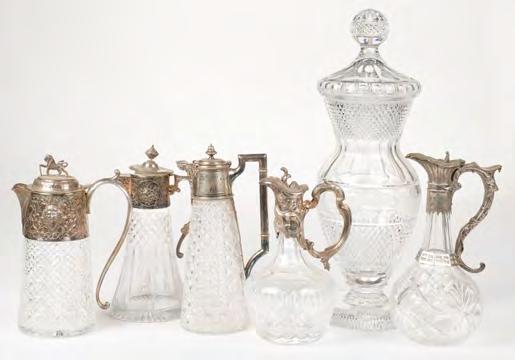
522* Decanters. A collection of cut glass decanters and claret jugs, including, a silver topped cut glass claret jug by James Deakin & Sons [?], top decorated with relief head surrounded by foliate to each side, hinged lid with lion and shield finial, scroll handle, body of cut tapering form, 28cm high, a large cut glass sweetmeats jar and cover, 48cm high, and other cut glass decanters and claret jug's some with silver plated tops, various sizes (20)
£100 - £150
523* Decorative ceramics. A pair of late Victorian Sevres style pink ground two handle porcelain vases, each decorated with vases of flowers and swags, overpainted in gold, handles with mask heads, raised on a pedestal with square base, blue interlaced Sevres mark to the underside of base, 41 cm high, both restored, together with a Victorian majolica cheese dish and cover, decorated in the Aesthetic style with birds and fans, indistinct impressed mark to base with registration mark, hairline cracks, 26 cm high, Aldermaston pottery jug by Laurence McGowan, decorated with birds, blue mongrams to base, 23 cm high, porcelain clock in the rococo style with figures and cherub, damaged, 35 cm long and other items (7)
£100 - £200
524* Decorative ceramics. A pair of Meissen porcelain sweetmeat dishes, early 20th century, modelled as figures seated on twin baskets and scroll bases, blue crossed sword mark to base, 13 cm high, together with a pair of Rosenthal porcelain doves designed by Fritz Heidenreich, green stamp to base, approximately 17 cm long, pair of Royal Worcester salts, white glaze modelled as cherub mermaids holding a scallop shell, green stamp to base, 11 cm long and other items (a box)
£100 - £150

525* Glassware. A collection of mid 20th century 'Safari' table glass engraved by Roland Ward, comprising of a large bowl and 6 wine glasses, each piece decorated with African animals ina landscape, including rhinoceros, lions, giraffes, elephants, gazelles, glasses with engraved bowl on faceted stem and conical foot, 13.7cm high (7)
£100 - £150
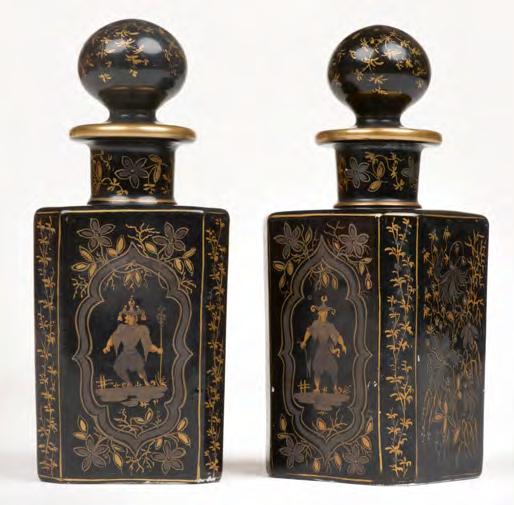
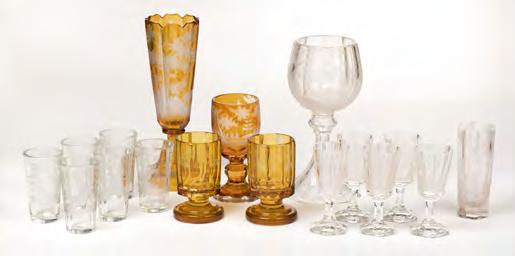
528* Bohemian glass. A collection of Bohemian glassware including, a set of five late 19th century drinking glasses, each etched with hunting scene and cut glass stem, 14.5 cm high, a large Bohemian Biedermeier style facet cut etched glass goblet decorated with deers in woodland setting, 28.5 cm high, a set of six 20th century glass beakers, of plain form engraved with deer and woodland, 12 cm high, an amber Bohemian footed glass vase 19th century, of tapering fluted form, etched with scene of deer in woodland, 31 cm high, an amber goblet etched with scene of deer in woodland 18.5 cm high, plus other items of glassware (17)
£150 - £200
526* Scent Bottles. A pair of Paris porcelain scent bottles with stoppers, mid-19th century, gilt and platinum Chinoiserie scenes on a black ground, in imitation of lacquer, each 16 cm high (2)
£100 - £150
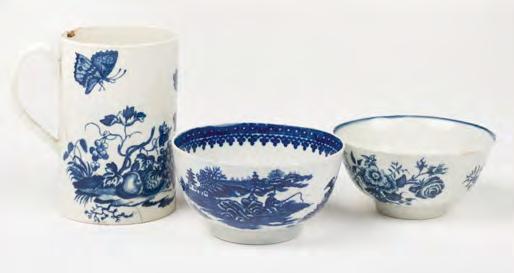
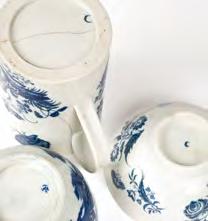
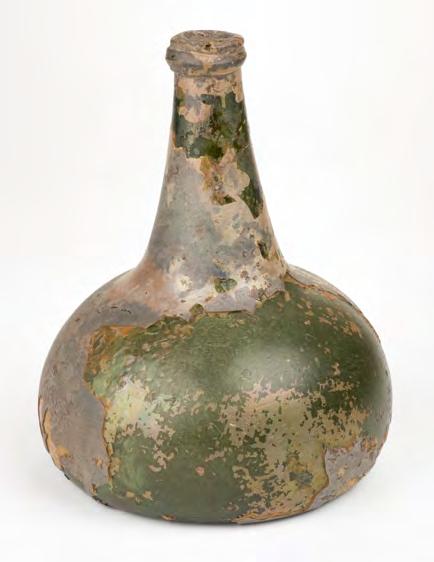
529* Onion bottle. A 17th century Dutch onion wine or port bottle, circa 1650-1700, green glass with iridescent colour which is flaking, 18.5 cm high
£100 - £150
527* Worcester Porcelain. A blue and white Worcester porcelain mug, circa 1770, in underglaze blue with Parrot Pecking Fruit pattern, strap handle, crescent mark to base, hairline crack, chip to rim, 11.5 cm high, together with a blue and white Worcester porcelain teabowl, circa 1780, Three Flowers pattern, crescent mark to base, 5 cm high, 11 cm diameter, plus a blue and white Worcester porcelain teabowl (or sugar bowl), circa 1775, Fisherman and Cormorant pattern, scalloped border to the interior and further image to the well, numeral mark to base, 5.5 cm high, 10.5 cm diameter (3)
Purchased from Woburn Abbey Antiques Centre, believed to be from a Dutch shipwreck (note included). (1)
£200 - £300

530* Royal Worcester. A pair of Royal Worcester porcelain plaques, 20th century, one painted by Arthur Badham, showing a song thrush perched on a branch, signed lower left, black printed mark to verso and numbered ‘RH/TL’, 16.5 x 11.5 cm, the other painted by Bryan Cox, showing a kingfisher, signed lower left, black printed mark to verso numbered ‘RH/SO’, 16.5 x 11.5 cm, each with gilt moulded frame, frame size 25 x 20 cm (2)
£200 - £300
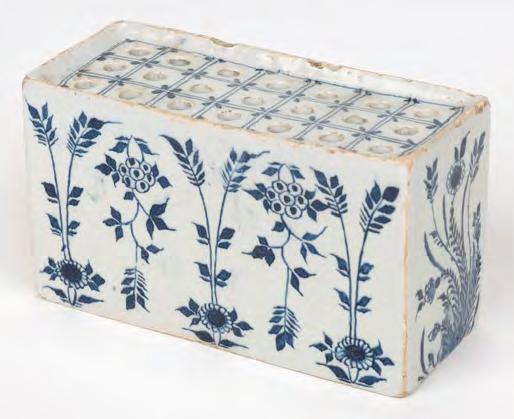
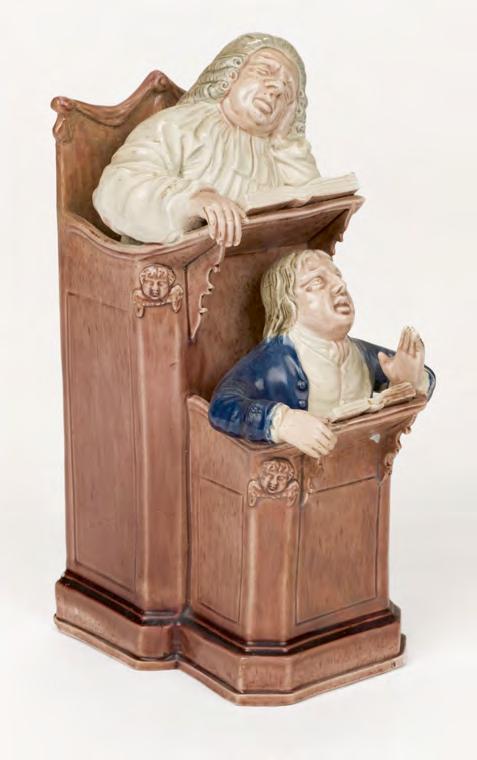
532* Ralph Wood, Burslem. A pottery model of the Vicar and Moses, circa 1790, modelled with the sleeping cleric and his industrious clerk in a pulpit, each with an open book before them, small chip to the rear corner, 24 cm high (1)
£300 - £500
531* Delft. An English delft blue and white flower brick, circa 1750, of rectangular form, decorated with flowers, several small chips, 9 cm high x 15.5 cm wide x 7 cm deep (1)
£300 - £500
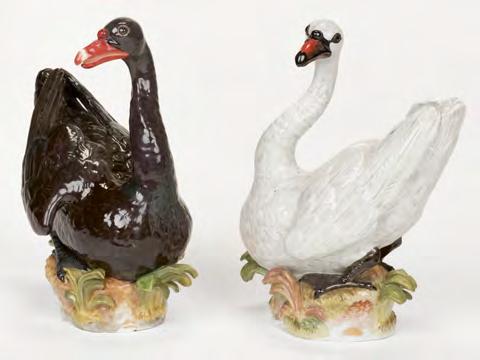
533* Meissen. A pair of Meissen porcelain swans, after J.J. Kandler, late 19th century, one black, the other white, each resting on a naturalistic base, both incised '1069' and with blue crossed swords mark, 22 cm high (1)
£400 - £600
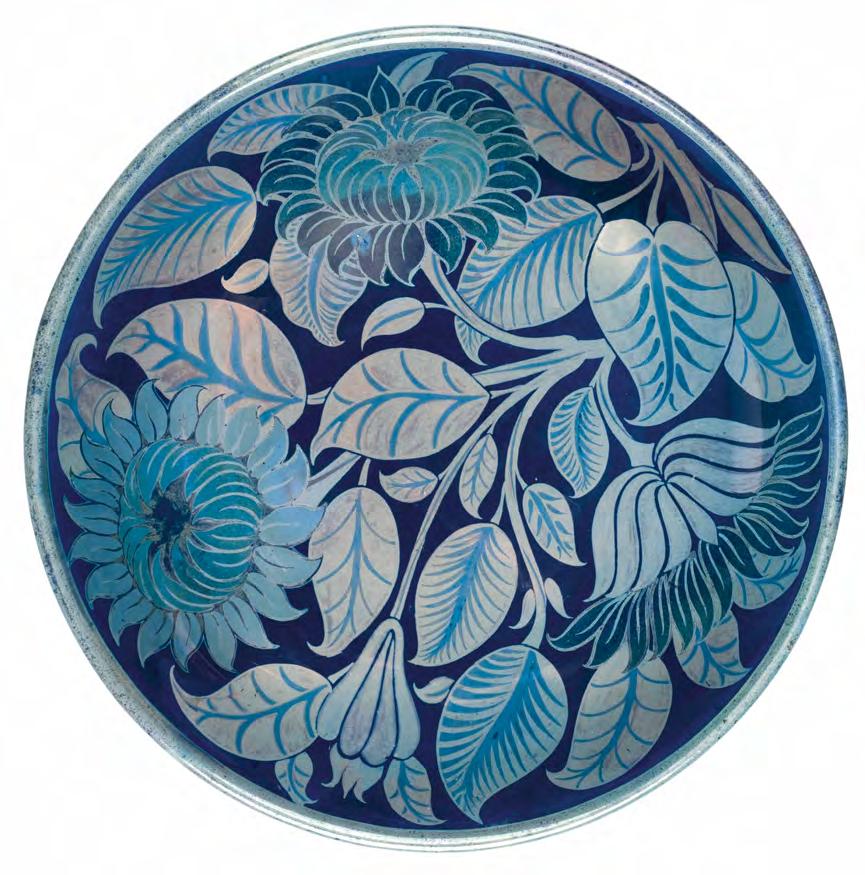
534* De Morgan (William, 1839-1917). A late Fulham period Sunset and Moonlight Suite triple-lustre dish decorated by Charles Passenger, sunflowers and foliage sprays in turquoise and deep lapislazuli, lustred in copper, silver and gold, on a mixed cobalt and manganese-purple ground, concentric circles and painted CP mark to base, in very fine condition, diameter 30 cm (11 3/4 ins)
Provenance: M. D. E. Clayton-Stamm, thence by family descent. This dish is illustrated in monochrome in William Gaunt and M. D. E. Stamm, William De Morgan, (London: Studio Vista, 1971), item 135, page 137. (1)
£3,000 - £5,000
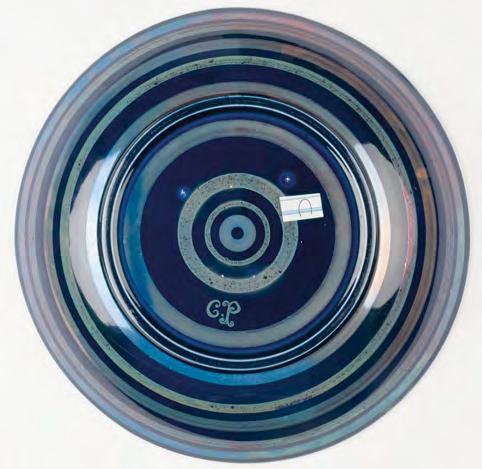

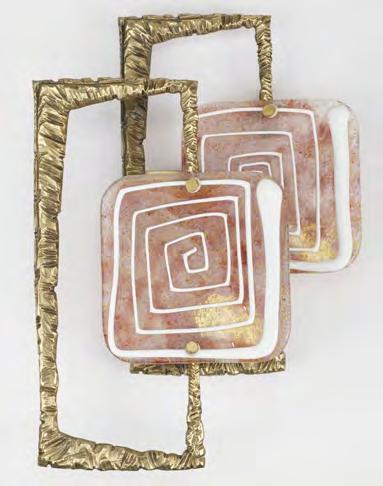
538* Brotto (Angelo, 1914-2002). An abstract wall light, circa 1960, bronze and Murano glass, designed for Esperia, produced by Vistosi, with original wall mount, 52.5 x 37 x 14 cm, requires rewiring
£200 - £300
535* Poole Pottery. A large Poole Pottery “Persian Deer” vase after Truda Adams, 20th century, decorated polychrome painted on a white ground, black printed mark to base and artists mark, 34 cm high (1)
536* Goldschneider. A 1920s art deco pottery figure, modelled as a flapper holding a blue dress, on an oval black base, the base with black Goldschneider Wien Made in Austria stamp, and impressed 5230 568 14, 49cm high (1)
£100 - £200
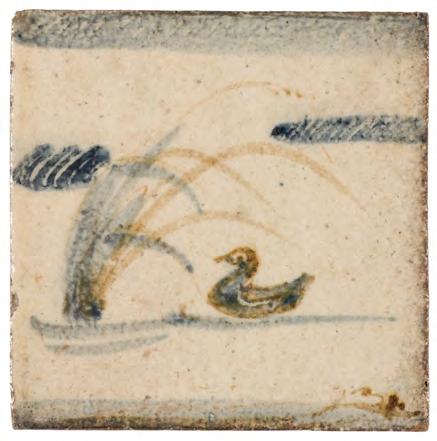
537* Leach (Bernard, 1887-1979). A stoneware tile for Leach Pottery, circa 1930, depicting a duck and reeds, painted BL to lower right, four impressed Leach Pottery marks to the reverse, 10 cm x 10 cm (4 x 4 ins)
A similar tile sold at Adam Partridge, Studio Ceramics from the Paul Rice Collection, 20 July 2021, lot 60. (1)
£600 - £800
A pair of similar wall lights sold recently at Artcurial’s Design Italien sale, Paris, 30 October 2023, lot 130 for €5,900. (1)
£200 - £300

539* Beswick. A collection of 28 Beatrix Potter figurines, and others, 1955-1993, comprising: Old Mr Brown, Flopsy, Mopsy and Cotton-Tail and Little Pig Robinson, all with BP-2 stamps to underside of base; thirteen others with BP-3 stamps to underside of base including:Benjamin Bunny, Squirrel Nutkin, Lady Mouse, Peter Rabbit, Little Pig Robinson spying, Mrs Tiggy-Winkle, Old Mr Brown, etc., and later figurines including 8 with BP-6a stamp to underside of base together with 4 with various later base stamps, tallest 17cm high, plus three Alice in Wonderland figurines, 19731983, comprising: Alice, White Rabbit, and Mad Hatter, tallest 12 cm high, and 7 other figurines by Coalport, Beswick, etc., and approximately 35 other mid to late 20th century child’s ceramics from Wedgewood, Royal Doulton, J & G Meakin, SylvaC Ware, etc., comprising: plates, money boxes, commemoration plates, clocks, figurines, etc., subjects including: Paddington Bear, Winnie the Pooh, The Hungry Caterpillar, Rupert the Bear, Animal Antics, etc., 11 in original boxes, largest diametre plate 26.7 cm (4 boxes)
£200 - £400
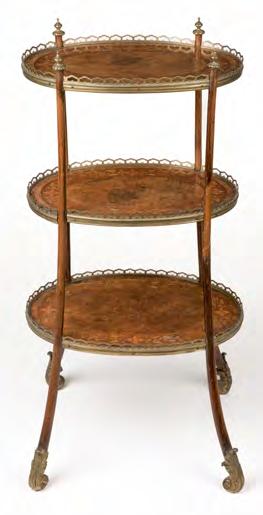

544* Chest of drawers. A Victorian inlaid mahogany straight front chest of drawers, the top inlaid with a floral roundel within a similar border, over three long drawers, each profusely inlaid, on tapered supports, 89.5 cm high x 127 cm wide x 56 cm deep (1)
£200 - £300
540* Étagère. A French walnut étagère circa 1900, with three tiers each with foliate inlay and brass mounts on four splayed supports, 84 cm high x 41.5 cm wide (1)
£100 - £150
541* Mirror. A French Napoleon III brass table mirror, circa 1900, the circular mirror supported in a brass frame suspended by a putto on a plinth on a black slate base, 43.5 cm high (1)
542 No Lot
£100 - £150
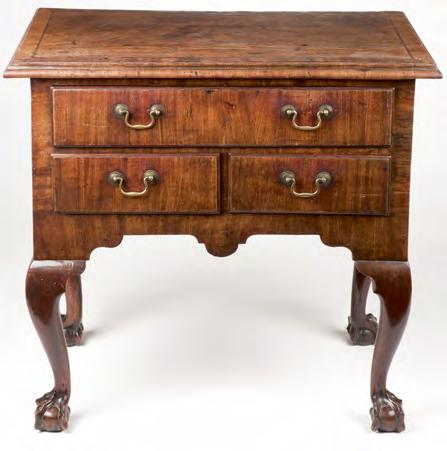
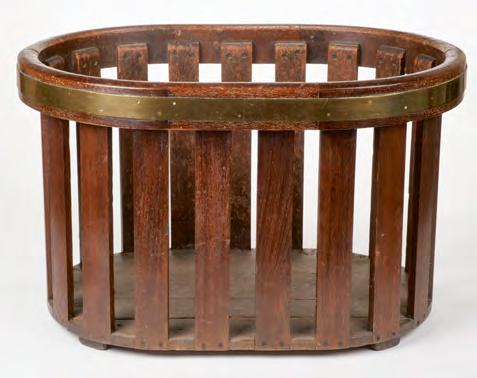
545* Log Basket. A Victorian Oak Log Basket, of oval form with vertical slats bound by brass, 53 cm high x 84 cm wide x 59 cm deep A piece of substantial portions and has great character (1)
£200 - £300
543* Lowboy. A walnut lowboy, 18th century, the rectangular top over one long and two drawers, on four cariole supports with claw and ball feet, 75 cm high x 78 cm wide x 47 cm deep (1)
£150 - £200
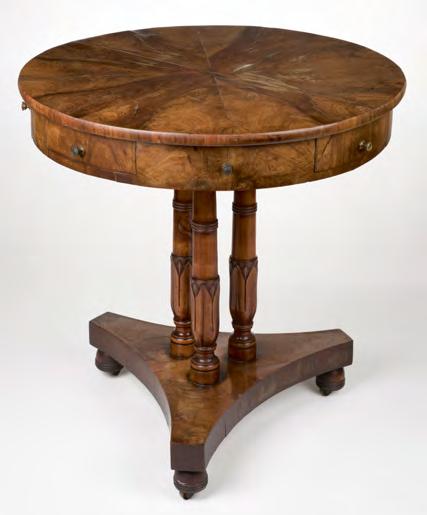
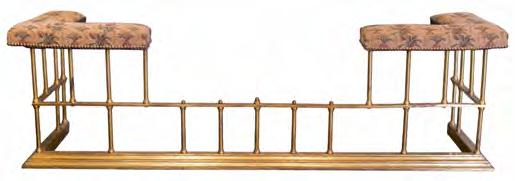
548 Club fender. A Victorian brass club fender, upholstered in pineapple cloth with brass beaded edge, 172 cm long (1)
£300 - £500
546* Occasional table. A William IV mahogany occasional table, the circular top veneered, over four drawers and dummy drawers, raised on three vertical lotus carved supports on a trefoil base with turned feet, 67 cm diameter x 70 cm high (1)
£200 - £300

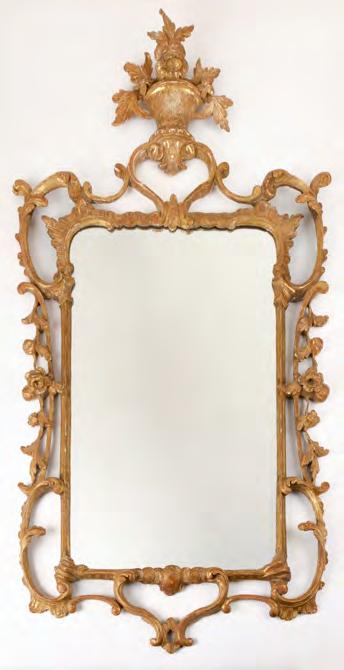
549* Mirror. A giltwood carved mirror, probably 18th century, the frame carved in the traditional Rococo style with c-scrolls and a basket of flowers, later bevel edge glass, general wear commensurate with age, 135 m high x 70 cm wide (1)
£300 - £500
550* Mirror. A giltwood carved mirror, probably 18th century, the oval frame carved in the traditional Rococo style with c-scrolls and branches, plate glass, general wear commensurate with age, 101 cm high x 62 cm wide (1)
£300 - £500
547* Bookcase. A George III satinwood waterfall bookcase, with pierced gallery top supporting a shelf over a single drawer and cabinet beneath with a door with an oval cloth covered panel on turned supports with brass casters, 121 cm high x 76 cm wide x 29 cm deep (1)
£300 - £500
551* Mirror. A giltwood carved mirror, probably 18th century, carved in the traditional Rococo style with c-scrolls, small plate glass, general wear commensurate with age, 101 cm high x 67 cm wide (1)
£300 - £500
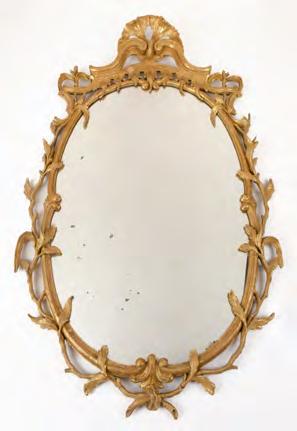

552* Mirror. A fine 18th century rococo giltwood girondale mirror, of oval form, moulded with grape and vines and scrolls and original plate glass with twin candle arms, some loss, 94 x 57 cm (1) £500 - £800
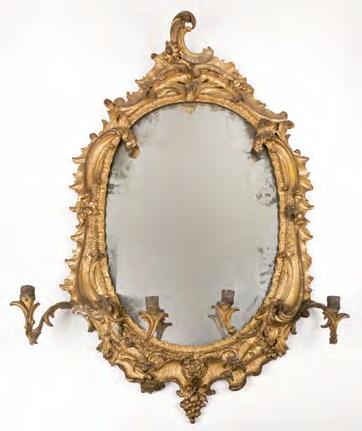
553* Bureau bookcase. A George III style walnut bureau bookcase, the upper section with a bevel edge mirrored door enclosing shelves, over a hinged fall enclosing divisional interior and four drawers on bracket supports, 194 cm high x 69 cm wide x 47 cm deep (1)
£600 - £800

554* Tables. A fine pair of George III satinwood demi-lune tables, one for cards, the other for tea, each with rosewood crossbanding, on tapered supports with brass casters, 73.5 cm high x 85 cm wide x 45.5 cm deep (2)
£700 - £1,000
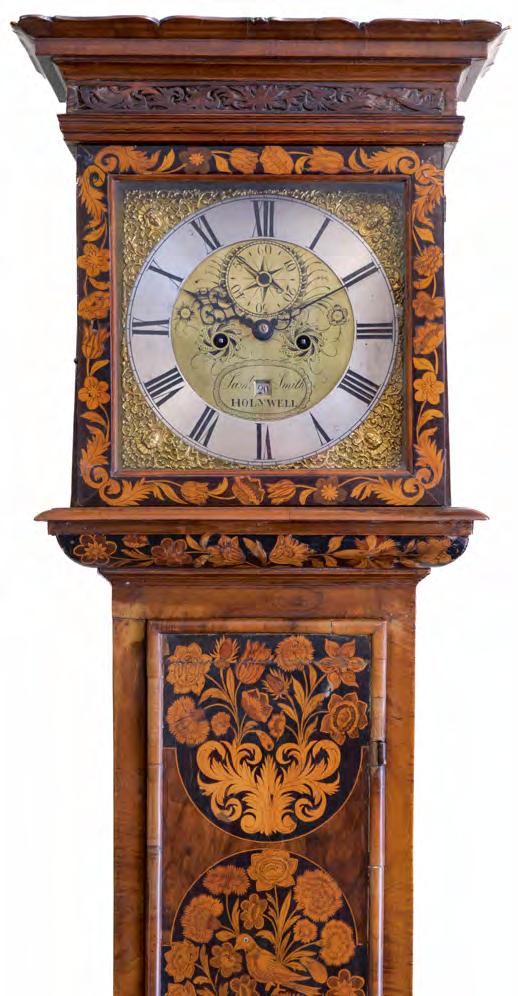
556* Desk stand. An Edwardian combination desk stand by Henry Matthews, Chester 1905, one side with a pocket barometer, with white enamel dial measuring 6 cm diameter and nickel case, the other side with a pocket watch, 8 day movement with white enamel dial, black roman numerals and subsidiary seconds dial, housed in a fitted case with silver cover incorporating a thermometer, some wear throughout, 21 cm long (1)
£70 - £100

557* Fountain Pens. A collection of 20th century fountain pens, various makers including Parker, Conway Stewart, Swan, Wyvern, Mabie Todd blackbird, 8 with 14ct gold nibs, mixed condition (14)
£80 - £120
555* Longcase clock. A George III floral marquetry longcase clock by Samuel Smith of Holywell, 18th century, the walnut case with fine floral marquetry depicting birds and flowers, the brass movement with 26 cm silver chapter dial engraved with black roman numerals, signed 'Sml Smith Holywell', the case 208 cm high (1)
£2,000 - £3,000
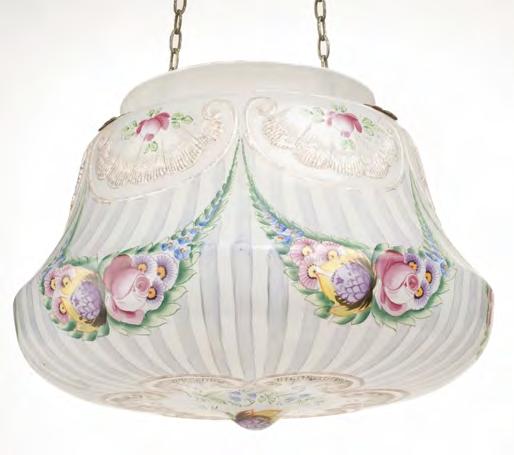
558* Lamp shade. An Edwardian milk glass hanging lamp shade, hand painted throughout with flower garlands and enamel decoration, applied with three pressed brass flower head bosses and hanging chain, 18.5 cm high (1)
£80 - £120
559* Coaching lamps. A pair of Victorian brass coaching lamps, each with circular bevel edge glass, 68 cm long (2)
£100 - £150
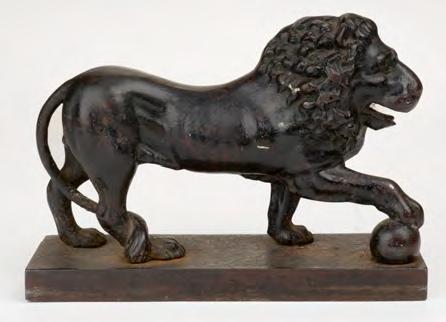
560* Door Porter. A Regency cast iron Medici Lion door porter, circa 1825, modelled standing on a rectangular base with one paw resting on a ball, 23.5 cm long
The Medici lions are a pair of marble sculptures of lions, one of which is of ancient origin, the other a 16th-century pendant; both were by 1598 placed at the Villa Medici, Rome, and since 1789 have been displayed at the Loggia dei Lanzi in Florence.
(1)
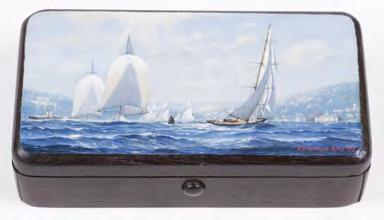
563* Hunt (Geoff, died 2008). The Big Class Race, Cowes 1934, an oil on hardwood box, the lid showing Britannia, Astra, Shamrock II, Velseda, Candida and Westwood, signed G.W.C. Hunt RMA (19)93 lower right, 3 cm high x 11 cm wide x 6 cm deep
Commander Geoff Hunt RMS, spent nearly forty years in the Royal Navy as both seaman and fighter pilot. He painted throughout this period, mainly marine and aeronautical subjects, and began painting in miniature shortly before leaving the navy in 1988. His work is sought after for its minute accuracy of detail as well as for the artist’s skill in portraying the subtle effects of light, wind and tide. Geoff Hunt was a President of the Hilliard Society, a member of the Royal Miniature Society and Miniature Art Society of Florida, and a Miniature Artist of America.
(1)
£100 - £150
£100 - £150
561* Enamel boxes. Various 18th century Bilston enamel boxes, including a small blue patch box, the lid with a vase of flowers and inscribed ‘A token of esteem’, the base turquoise ground, damaged, 4.5 cm long, another inscribed ‘Virtue is the greatest Ornament of the fair’, damaged, 4.5 cm long and other related items (13)
£100 - £200
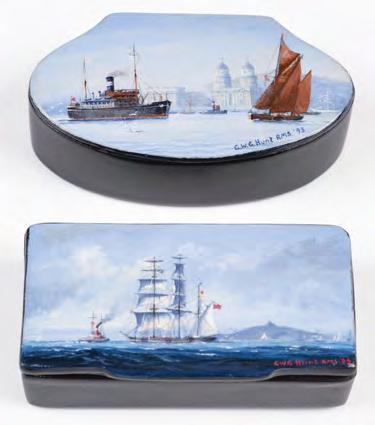
562* Hunt (Geoff, died 2008). “Shipping in Greenwich Reach”, oil on papier mache rounded snuff box, signed and dated (19)93 lower right, 2.5 cm high x 8 cm side x 4 cm deep, together with another snuff box by the same artist, “Barque in Carrick Roads, Falmouth”, signed and dated (19)92 lower right, 2.5 cm high x 7.5 cm wide x 4 cm deep

564* Russian box. The girl in blue, Russian lacquer box by Yemelanov, Fedoskino School, 2001, signed and dated lower right, handpainted on a black ground with gold painted foliate border, the hinged lid enclosing red lacquered interior, 4 cm high x 11.5 cm wide x 14.5 cm deep
(1)
£100 - £150
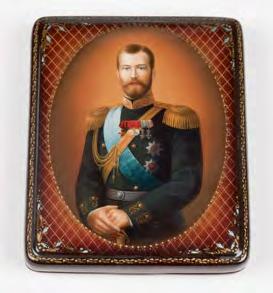
565* Russian box. Tsar Nicholas II, Russian lacquer box probably Fedoskino School, 1997, signed and dated lower right, handpainted portrait, on a lattice work ground, the opposite side with a royal coat of arms, the hinged lid enclosing red lacquered interior, 1.5 cm high x 8 cm wide x 10 cm deep
£100 - £150
Commander Geoff Hunt RMS, spent nearly forty years in the Royal Navy as both seaman and fighter pilot. He painted throughout this period, mainly marine and aeronautical subjects, and began painting in miniature shortly before leaving the navy in 1988. His work is sought after for its minute accuracy of detail as well as for the artist’s skill in portraying the subtle effects of light, wind and tide. Geoff Hunt was a President of the Hilliard Society, a member of the Royal Miniature Society and Miniature Art Society of Florida, and a Miniature Artist of America. (2)
(1)
£100 - £150
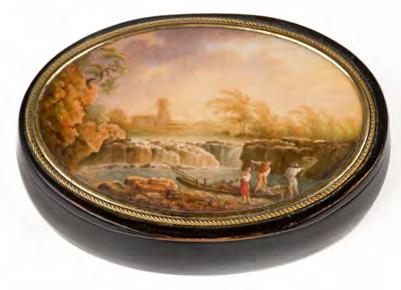
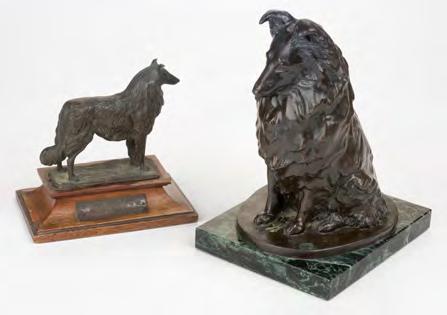
566* Snuff box. A continental papier mache snuff box, mid 19th century, of oval form, the hinged lid painted with an Italianate landscape within a brass rope-twist border, approximately 9.5 cm long (1)
£100 - £150
567* Wall clock. An early 20th century circular wall clock, the white dial signed Calvert, Southport, with black roman numerals, in a mahogany case with brass fusee movement, 61 cm diameter, together with a mantel clock with white enamel dial, black roman numerals and architectural mahogany case 39 cm high (2)
£100 - £200
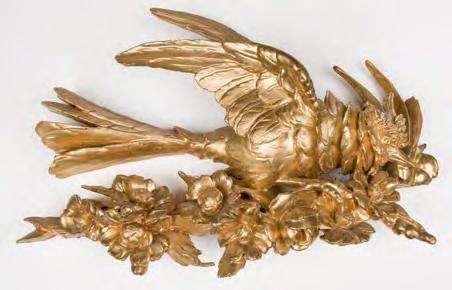
568* Carving. A giltwood carving, probably 18th century, carved as a game bird and floral garland, some loss, 48 cm long (1)
£150 - £200

569* Enamel sign. Cadbury’s Cocoa Essence enamel advertising sign by Falkirk Iron Co, red and black lettering on a yellow ground, 6 holes for suspension, some minor loss and wear commensurate with age, 25.5 x 46 cm (1)
£150 - £200
570* Jukes (B). Bronze dog sculpture, 20th century, modelled as a seated collie, signed, 19 cm high, mounted on green marble base, overall height 21 cm, together with a bronze collie trophy by Elkington, the bronze signed W.J. Brewer 1910, 10 cm high, mounted on a mahogany base with brass plaque engraved ‘The Mary Grey Memorial Trophy’, some loss to the wooden base, overall height 13 cm (2)
£150 - £200
571* Motorcycle Racing. A collection of enamel badges circa 1960s, including Isle of Mann T.T. 1960, 1964,1965, Dragon Rally 1965, 1966, 1967, Brands Hatch, International 1964-5 Cycle & Motor Cycle Show, Monza, Ariel, Ulster Grand Prix and other related badges plus 9 enamel hockey badges circa 1930s, including English & Continental Club Tournament Ramsgate 1937, together with Society Medal. Odd Fellows yellow metal medal, two-tone with a white metal dove laid on a five-point star, the reverse engraved ‘Sister Alice Mau Welsh P.N.G. by University Rebekah Lodge No 53 Dec 1928’, with three-link suspension brooch, 25 mm wide, contained in a leather case with gold embossed ‘The Lilley Co, Columbus, Ohio’, together with a WWII 10K gold Women’s Auxiliary brooch, reverse stamped ‘10K Birks’, 20 mm wide, 2.7g, plus WWII ARP badge, plus Tennis. A collection of tennis related items belonging to E.W. Eardley, comprising a Suffolk Lawn Tennis Association bronze prize medal, the reverse engraved ‘Men’s Doubles County Championship 1929, 45 mm diameter, in blue leather box, together with another similar, engraved ‘Men’s Doubles County Championship 1931, 45 mm diameter, no box, plus three black and white photographs for Worcester College Tennis Team for the years 1923, 24 and 1926 all featuring E.W. Eardley another photograph for the Suffolk InterClub Championship Won by Aldeburgh 1932 shows E.W. Eardley on the right, framed and glazed, frame size 38.5 x 33 cm (31)
£100 - £150

572* Seychelles. A fine example of this Coco de Mer (Lodoicea maldivica) seed, converted into a basket, highly polished finish, 27 cm long (1)
£150 - £200
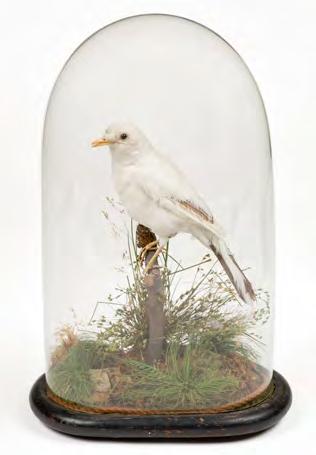
573* Taxidermy. A Leucistic Blackbird, Terdus merula, early 20thcentury, a cased leucistic blackbird displayed in a naturalistic setting on a wooden base with cork feet, the whole presented under a glass dome, overall height 42 cm (1)
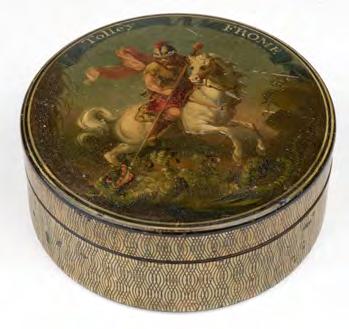
£150 - £200
575* Abstract carving. A green marble abstract sculpture, 20th century, carved a male leaning on a female nude, unsigned, 35 cm high x 36 cm long (1)
£200 - £300
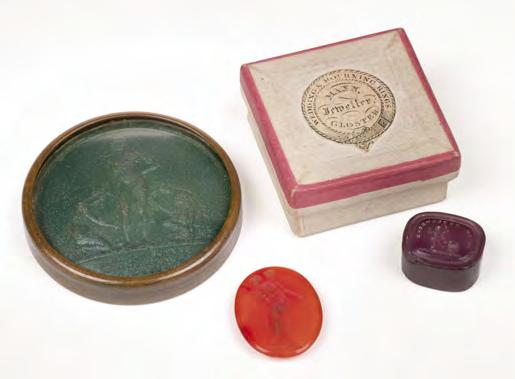
576* After Andrieu (Jean-Bernard, 1761-1822). Capture of Vienna and Pressburg, 1805, ceramic or metal medal, showing Napoleon standing as Hercules, at his feet two turreted women present him the keys to the Vienna and Pressburg, signed Denon D, Galle, 39 mm diameter, contained in a sealed brass case with convex glass, the opposite side stamped ‘11’, 40 mm diameter, together with a Grand Tour purple glass intaglio, showing Cupid dropping arrows with one foot kicking the world, with the motto ‘Je Le Bouleverse’ (I upset the world), 15 x 11 mm, contained in a small card box with original trade label for ‘Mann Jeweller Gloster’, plus a carnelian intaglio seal carved as a classical female wearing arrows with one hand holding a cornucopia and the other flowers, 20 x 15 mm (3)
£200 - £300
574* Tolley Frome. A papier mâché circular table box and cover, 19th century, the cover decorated with George and the Dragon and inscribed ‘Tolley Frome’, the sides with a printed geometric design, 8.5 cm diameter (1)
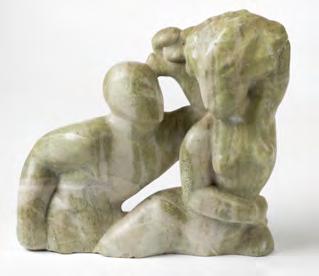
£150 - £200

577* Bronze Age. A Bronze Age flanged axe head circa 700 BC, hollow and flanged with flared head, 11 cm long Similar examples are on display at Devizes Museum, Wiltshire. It is very similar in size and form to those from the large Dorset hoard of bronze axe heads, which date from the same period. (1)
£200 - £300
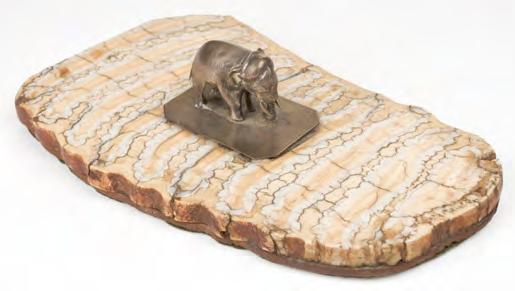
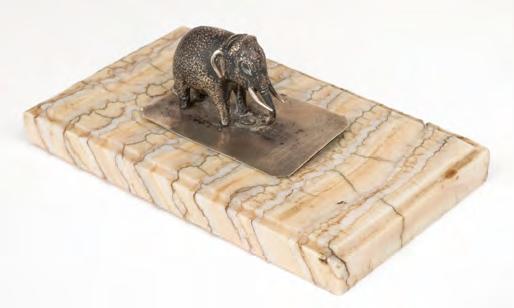
578* Desk weight. A white metal elephant, 19th century, mounted on a slice of fossilised mammoth tooth, 13 cm long, together with another similar, mounted on a rectangular slice of mammoth tooth, 9 cm long (2)
£200 - £300
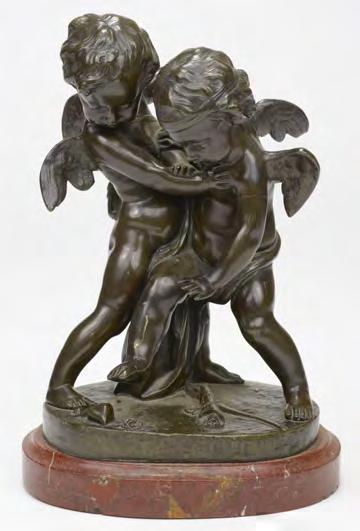
579* French School, circa 1870, a fine bronze sculpture modelled as fighting cherubs, unsigned, mounted on an oval red marble base, 30 cm high (1)
£200 - £300
580* Grand Tour. A continental bronze base, 19th century, modelled as three kneeling nymphs with their arms raised, mounted on a circular rouge marble base and black slate with bronze paw feet, 15 cm diameter (1)
£200 - £300

581* Meissen. A collection of Meissen porcelain pug dogs, late 19th century, including a confronting pair, modelled seated with blue and gold collars, one with blue crossed swords mark, 7 cm high, plus three smaller, 5 cm high (5)
£200 - £300
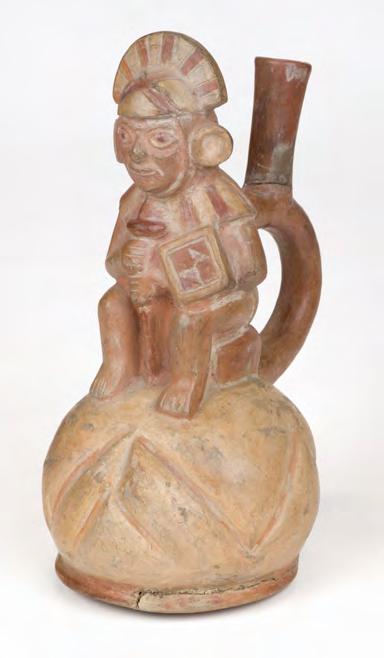
582* Mochre culture. An ancient Peruvian stirrup jug, modelled as a seated warrior holding shield and sword, restoration to the base and spout, 30 cm high
The Moche civilisation flourished in northern Peru from about 100 to 800 AD. (1)
£200 - £300
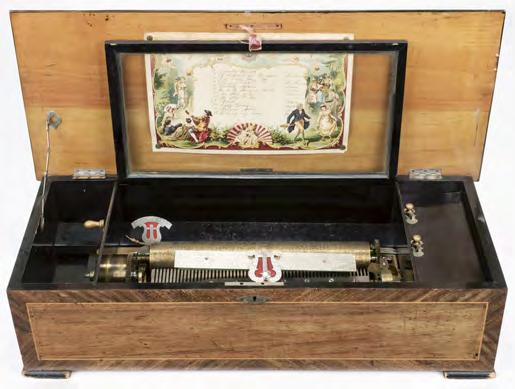
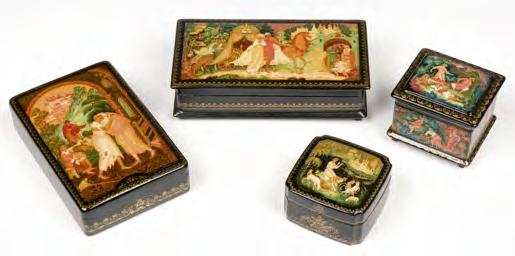
583* Music Box. A Victorian Swiss music box, circa 1880, the rectangular box veneered in rosewood with boxwood strung inlay, the lid featuring the remains of a transfer printed decoration, a pair of pierced metal side carrying handles, enclosing a brass movement with a steel cylinder under a glass cover, the inner lid with a printed and manuscript list of tunes including ‘the ship I love’ and ‘Oh honey my honey’, old worm holes and general wear commensurate with age, 19 cm high x 70 cm wide x 30 cm deep (1)
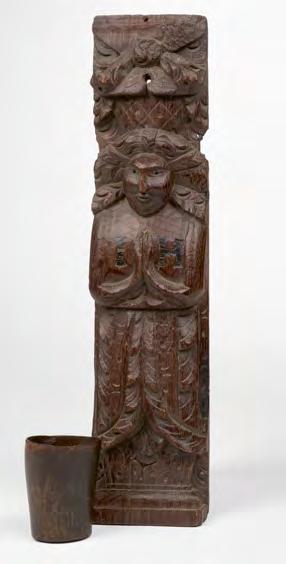
£200 - £300
585* Russian boxes. Return of the Prodigal Son, by Mityagshin, Kholui School 1997, Russian lacquer box, handpainted, signed and dated lower right, the detachable cover enclosing red lacquered interior and additionally inscribed and dated in gold, 4 cm high x 10 cm wide x 15 cm deep, together with three other Russian lacquer boxes including a rectangular box by Pyotr Mityashin, showing Peter and Fevronia of Murom, 5 cm high x 17.5 cm wide x 9 cm deep (4)
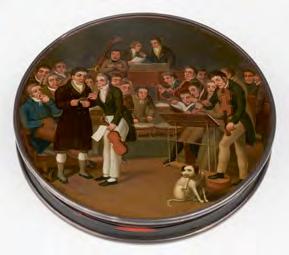
£200 - £300
584* Oak atlantid. A carved oak atlantid, 1st quarter 17th century, male caryatid figure, the robed man with splayed hair, his hands clasped in prayer, the initials ‘IH’ inlaid with ebonised wood on his chest, surmounted by a pineapple patterned device, height 48.5 cm (19 ins), width 11 cm (4.25 ins), depth 3.5 cm (1.5 ins), together with a horn beaker with the same initials carved into base, height 9 cm (3.5 ins), diameter of base 5 cm (2 ins), diameter of top 6.5 cm (2.5 ins) (2)
£200 - £300
586* Stobwasser. A German Stobwasser circular box circa 1810, the cover painted a concert scene, showing an orchestra with violinists and a man taking snuff in the foreground, with silver band to the cover and base, the inner lid inscribed ‘Der Concert ...’, the base inscribed ‘711 Stobwasser Fabrik’, 9.5 cm diameter (1)

£200 - £300
587* Stobwasser. A German Stobwasser circular box circa 1810, the cover painted a scene after the work 'The Judgement by Peter Paul Reubens' showing classical male and female nudes with a cherub and goddesses, the underside of the cover inscribed 'Des Urtheil des Paris nacht van der Werst', numbered 3905, the base with corresponding number and inscribed 'St', 9 cm diameter, with original tooled card box (1)
£200 - £300

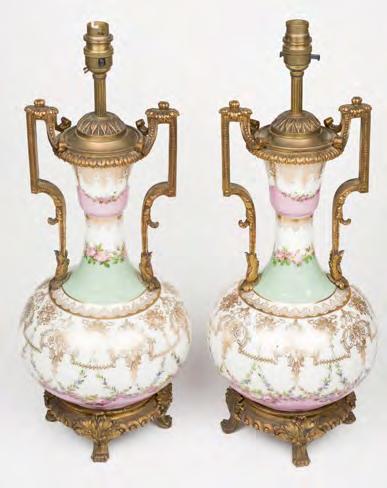
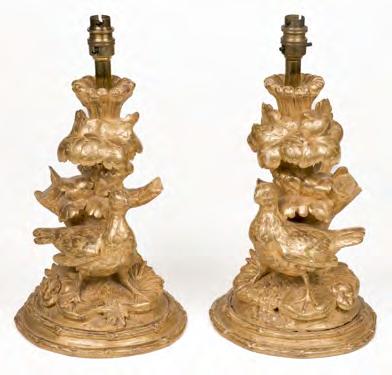
588* Stobwasser. A German Stobwasser circular box circa 1810, Mademoiselle Lunden (the intended wife of Peter Paul Rubens), the inner cover inscribed 'Mde Lunden ... Rubens', the base inscribed '906 Stobwasser Fabric', 9.5 cm diameter (1)
£200 - £300
589* Table lamps. A pair of continental porcelain and ormolu table lamps, late 19th century, of bottle form hand painted with floral swags and over painted in gold on a white, green and pink ground with neo classical ormolu handles and mounts, each mounted on circular base with guilloche and scroll feet, overall height 40 cm, modern wiring and mounts (2)
£200 - £300
590* Table lamps. A pair of giltwood carved table lamps, 19th century, each carved with game birds by a tree stump, 31 cm high, modern wiring and fittings (2)
£200 - £300
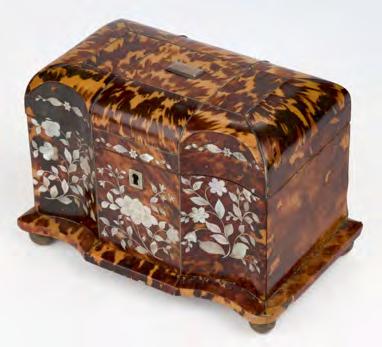
591* Tea caddy. A Victorian tortoiseshell and mother-of-pearl tea caddy, shaped form inlaid with mother-of-pearl foliate decoration, the hinged lid enclosing two compartments, each with a cover, on brass ball feet, minor age wear, 13 cm high x 18.5 cm wide x 12 cm deep (1)
£200 - £300

592* Bilston enamel. A collection of Bilston enamel trinket boxes, including a circular table box, 18th century, the cover decorated with a tavern scene showing figures dancing in a landsape, the sides with floral sprays and similarly decorated on the base, some stress cracks, 14 cm diameter, together with a rectangular box with canted corners, decorated with a hunting scene showing riders on horseback with hounds, floral sprays to the sides 14 cm long, plus six smaller enamel boxes, variable condition (8)
£300 - £500
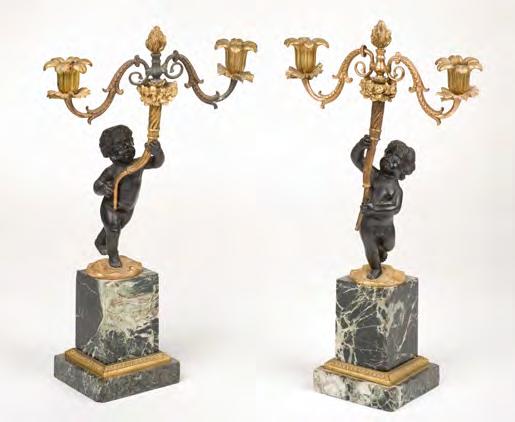
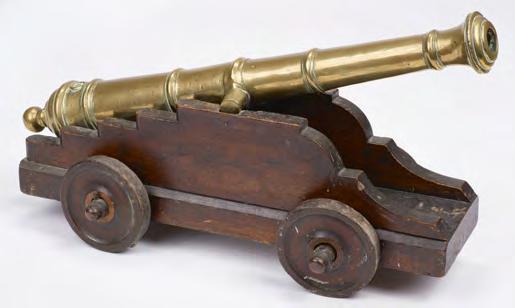
Cannon. A George III
593* Candleabra. A pair of French bronze and ormolu two-branch candleabra, 19th century, each modelled as a putto holding a conucopia with two candle sconces, on a substantial green veined marble base, some chips, 48 cm high (2)
£300 - £500
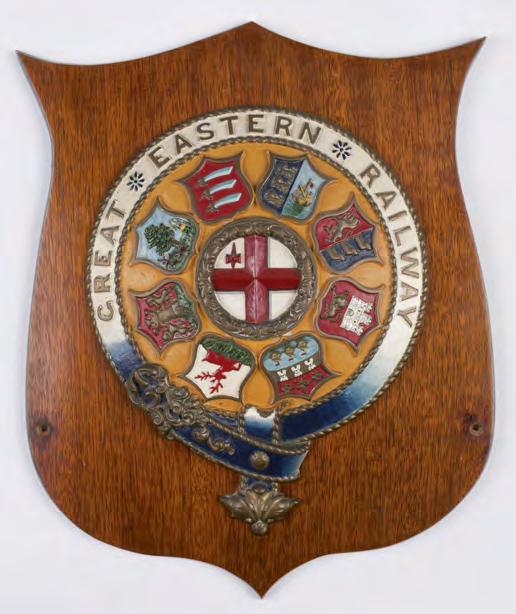

594* Locomotive Crest. An original Great Eastern Railway locomotive crest from a Claud Hamilton class S46 4-4-0, heavy brass and polychrome painted, with four fixing bolts, approximately 40 x 31 cm across, mounted on a wooden shield, 55 x 43cm (1)
£300 - £500
596* Fossil. A Keichosaurus fossil from Liaoxui, China, approximately 140 million years old, 6.5 x 12 cm, presented in a fitted cloth display box, lined with red velvet and information card, (1)
£400 - £600
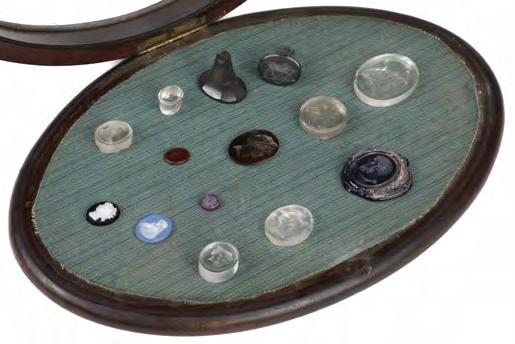
597* Grand Tour Intaglios. A group of fourteen late 18th/early 19th century intaglios, mixture of coloured glass and obsidian oval intaglios and cameo reliefs of classical and neo-classical subjects, male and female portraits, one signed with initials ‘’C. H. W’ (Charles Wyon), another ‘W WYON’ (William Wyon), 2 depicting Minerva, two 8 faceted polished desk seals, possibly obsidian, one depicting a bull, the other a Bacchanalian procession, various sizes, the largest 4.5 x 3.5 cm, a few with small chips, contained in a Regency period oval mahogany glazed display case, with hooked clasp, 22.5 x 21.5 cm (14)
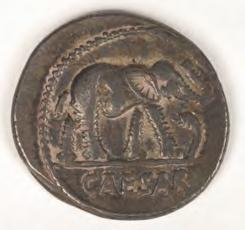
£500 - £800
598* Roman Empire. Julius Caesar, AR Denarius, circa 49-48 B.C. Military Mint Travelling With Caesar, the obverse showing an elephant trampling a serpent to right, CAESAR in exergue, the reverse with emblems of the pontificate, ladle, sprinkler, axe, priest’s hat, 19 mm, 4g, very fine
The depiction of an elephant trampling a serpent is thought to refer to Caesar’s victories in Gaul. (1)
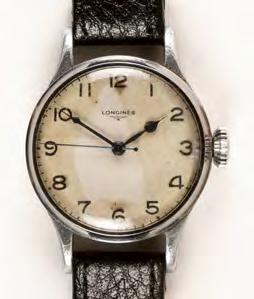
£600 - £800
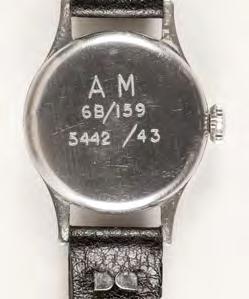
599* Pilot’s Wristwatch. WWII RAF Longines military wristwatch 1943, white circular dial (some staining) with Arabic numerals and blued steel hands, stainless steel case and winding crown, the backplate engraved ‘A.M. 6B/159 5442/43’, case size 32 mm diameter, on black leather strap, working (1)
£700 - £1,000
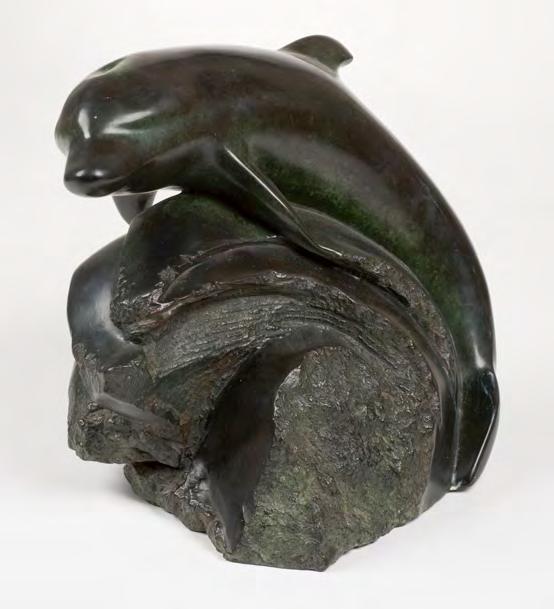

600*AR Broderick (Laurence, 1934-2024). Donald the Dolphin 1995, bronze sculpture, modelled as a dolphin over rocks, signed ‘Laurence Broderick Donald The Dolphin A/C 1995’ Laurence Broderick (1935-2024) was a British sculptor. His best-known work is ‘The Bull’, which was erected in 2003 at the Bull Ring, Birmingham. (1) £1,000 - £1,500
601* Vulliamy. A Regency mantel clock, the 14.5 cm circular silvered dial signed 'Vulliamy London' with black roman numerals and steel hands, the rosewood case on four brass ball feet with brass lining, pierced brass grilles to the sides and convex glass door to the front, the rear glass door enclosing brass movement engraved 'Vulliamy London' with steel bell and brass pendulum and keys, 33.5 cm high
(1)
£2,000 - £3,000

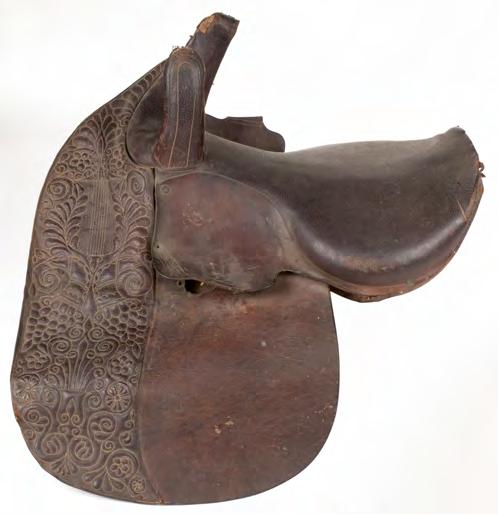
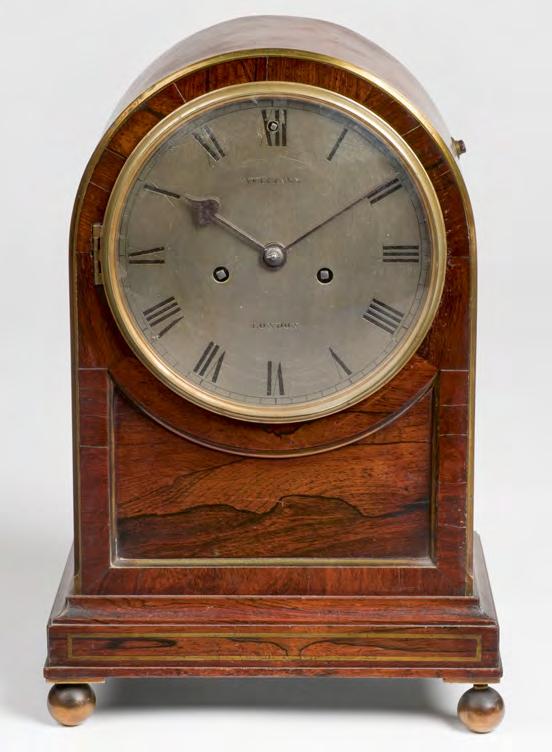
602* Saddle. A leather side-saddle, Paris: Brune, late 18th century, with two raised pommels (without a lower pommel), near side with elaborate hand-stitched scrollwork and floral pattern to knee roll, remains of maker's labels beneath skirt on each side: 'Brune Sellier et Harnacheur, Rue de la Paix No.21 au coin du Boulevard des Capucine, Quartier de la Place Vendôme Paris.', worn in places, 65 x 70 cm (25.5 x 27.5 ins), together with an earlier side-saddle, with decoratively stitched chair seat, worn
Provenance: Private Collection, Derbyshire.
Two rare early side-saddles, the first made by an upmarket Parisian saddler, before the invention of the lower pommel by Jules Pellier in 1830, the second with chair seat designed for a lady to sit in a decorous sideways position.
(2)
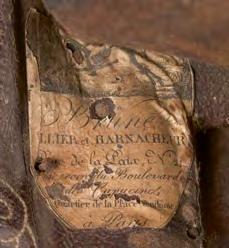
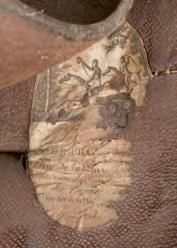
£200 - £300
603* Sugar bowl. George V silver sugar bowl by William Hutton & Sons, Sheffield, 1930, of oblong form with gadrooned rim and two handles on four ball feet, marks rubbed, 18 cm long, 260g (1)
£70 - £100
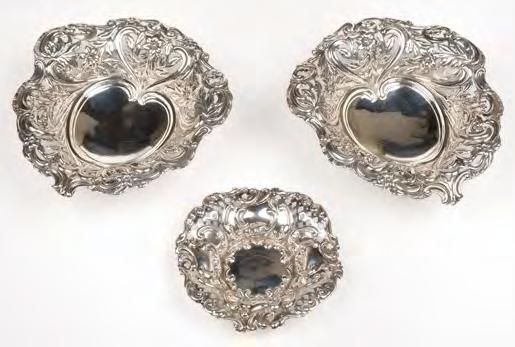
604* Bon Bon dishes. A pair of Victorian ornate bon bon dishes by W H [?], Birmingham, 1893, heart shaped bowl with intricate pierced foliate boarder, on footed rim, 163g, together with a pierced pin dish by William Hutton & Sons Ltd, Birmingham, 1905, 29g (3)
£100 - £150

605* Snuff box. A George III silver mounted Cowrie shell snuff box, by Nicholas Edwards, London, 1805, with reeded silver border, monogramed hinged lid and gilt interior, 6.6cm (1) £100 - £150
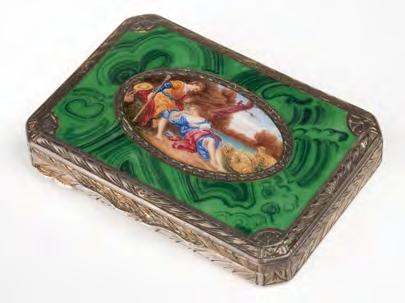
606* Snuff box. A German silver and enamel snuff box stamped 800, of rectangular form, the lid inset with an oval vignette painted with a shepherd and maiden with flock set into a faux malachite ground, the silver work finely engraved with scrolls and the interior gilded, general surface scratches, 7.5 cm long, gross weight 66.8g (1)
£100 - £150
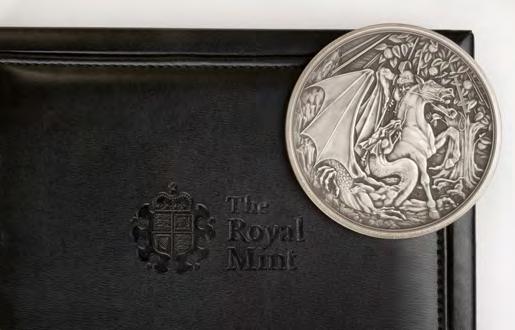
607* Historical Medal. St George and the Dragon, 2009, a silver medal by G. Summers for the Royal Mint, the obverse showing St George slaying the dragon with an orange tree in background, the reverse with a princess contemplating her fate while watching the contest, 80mm diameter, in case of issue, with certificate no 396/500 (1) £150 - £200

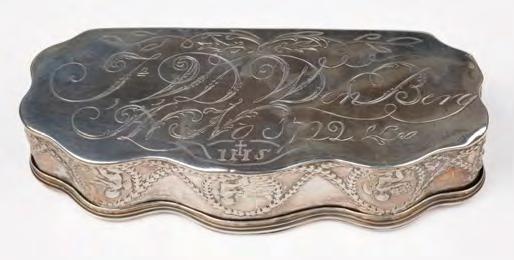
608* Silver box. A continental silver box with hinged cover, rococo serpentine shape and relief decorated with cherubs within foliate borders, the reeded hinge lid with scene of cherubs and chariots within rococo boarder, the base engraved ‘Jn VD WenBerg Anno 1722’ and religious symbol ‘IHS’ 16 cm long, 204 g (1)
£150 - £200
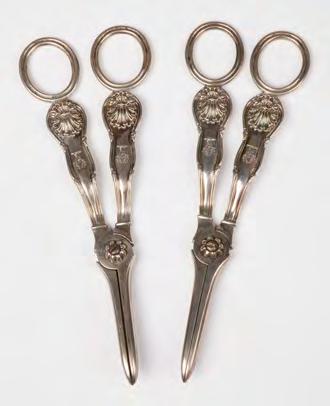
609* Silver grape scissors. Two pairs of George IV Silver grape scissors by William Eley II, London, 1826, modelled in the kings pattern with reeded oval finger rings, arms engraved with a family crest, 17.5cm, 224g
(2)
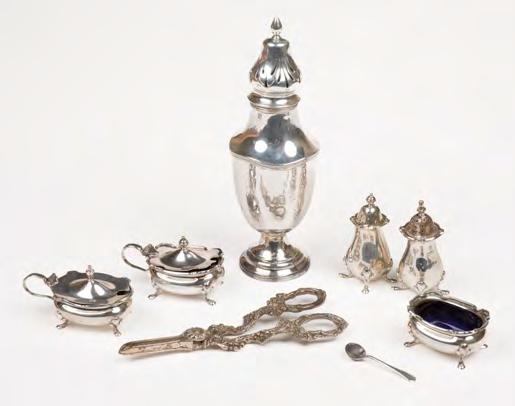
£150 - £200
610* Boxes. A George III silver vinaigrette by Matthew Linwood, Birmingham 1803, with prick-dot and wriggle-work decoration, cartouche engraved with initials, the hinged lid enclosing a gilt filigree type grille, 35 mm long, together with a Chinese white metal pill box, the cover engraved with foliate and geometric decoration, double mark to base, 8 cm long, Indian white metal pill box, a Victorian conch shell cameo, carved as a classical female with roses in her hair, contatined in a yellow metal double twist mount, some old stress cracks, 6 x 5 cm, and other items (8)
£200 - £300
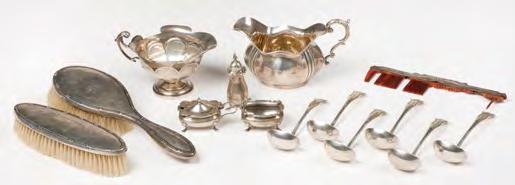
611* Mixed Silver. An Edwardian silver cream jug by Williams (Birmingham) Ltd, Birmingham, 1902, of shaped oval form and scroll handle, 9cm high, 164g, together with a silver cream jug by Walker & Hall, Sheffield, 1918, with fluted body and scroll handle on pedestal foot, 144g, two silver salt cellar by Walker & Hall, Sheffield, 1907, oval body with shaped edge on 4 feet, one with hinged lid and handle, 72g, a set of six silver ladles by Franklin & Sons, Edinburgh, 1828, kings pattern with monogrammed handle, 180g, plus other items (14)
£200 - £300
612* Mixed Silver. An Edwardian silver sugar caster by Walker and Hall, Sheffield 1908, of baluster form with pierced domed cover and finial, hallmarks rubbed, 20cm high, 144g, two silver salt cellar by Adie Brothers Ltd, Birmingham, 1962, oval body with shaped edge on 4 feet, one with hinged lid and handle each with blue glass liner, hall marks rubbed, 84g, a pair of silver grape scissors by Philip Kydd, London, 1987, 112g, plus other items, weighable silver approximately 450g (7)
£200 - £300
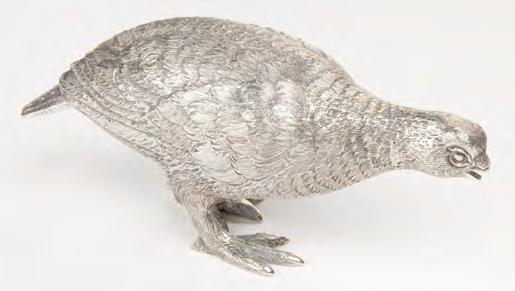
613* Grouse. A contemporary cast silver grouse table ornament, by William Comyns & Sons Ltd (Richard Comyns), London, 1972, realistically modelled as a red grouse, standing in a low position, head down, 204g (1)
£300 - £400
614* Mixed silver. An Edwardian silver helmet shape cream jug by Williams (Birmingham) Ltd, Birmingham 1903, plain form on square foot with reeded handle, 14 cm high, 112g, together with a George III silver sauceboat, makers mark worn, London 1814, 13.5 cm long, 117g, 3 cigarette cases, aid memoire, part condiments, dressing table bottles/jars and other items, weighable silver approximately 925g (a small box)
£300 - £500
615* Mixed silver. Irish silver sauce ladle by Michael Keeting, Dublin, 18th century, engraved with a family crest, a matched pair of Victorian silver sauce ladles, silver cream jug, silver top jars and other items, weighable silver approximately 755g (a box)
£300 - £500
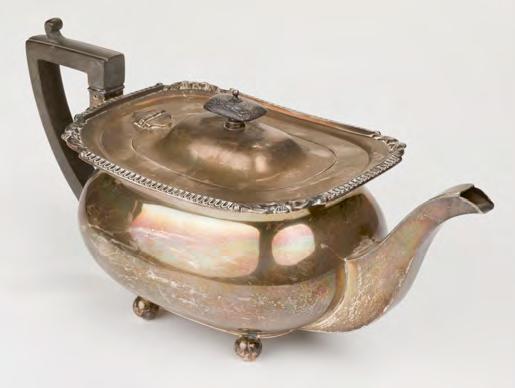
616* Teapot. A George V silver teapot by William Hutton & Sons, Sheffield 1919, of oblong form with ogee and shell rim, composite handle on four ball feet, gross weight 759.3g (1)
£300 - £500
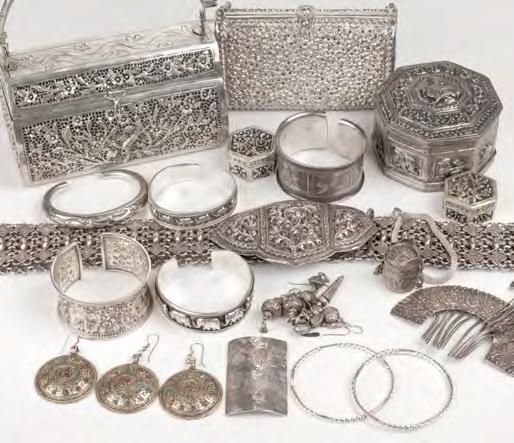
617* Thai silver. A collection of Thai white metal, including an evening bag, with pierced and foliate decoration, with a hollow swing handle, 15 cm long, 314g, together with another evening bag with pierced decoration and fine link carrying strap, 12.5 cm long, 225g, a ladies belt with pierced geometric links and a shaped foliate buckle, 96 cm long, 422g, plus various sundry items includiing napkin rings, lidded box and other items, approx 500g, gross weight approximately 1460g (a shoe box)
£300 - £500
618* Silver cutlery. Various silver cutlery by Garrard & Co, Sheffield, 1954, comprising 15 rat-tail serving spoon, 9 table forks,9 dessert spoons, 10 dessert forks and 12 associated silver gripped dinner knives plus 10 silver gripped tea knives, weighable silver approximately 2444.5g (a box)
£800 - £1,200
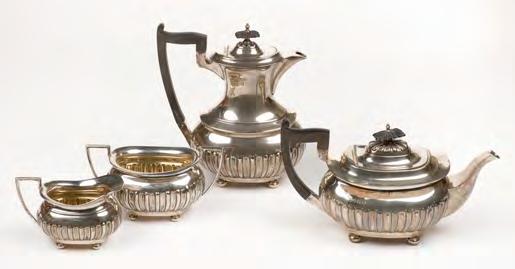
619* Tea Service. A George V period four-piece silver tea service by Walker and Hall, Sheffield 1916, comprising of coffee and tea pots, sugar bowl and milk jug, all the neo-classical half gadrooned style, the tea and coffee pot with ebonised handle and finial, the coffee pot 22cm high, total gross weight approximately 1964g (4)
£800 - £1,200

620* Chester silver. An Edwardian silver jewellery box by George Nathan and Ridley Hayes, Chester 1908, of shaped form embossed with figures amongst a landscape with churches and houses, the hinged lid enclosing a fitted velvet interior, on four lion's paw feet, 6.5 cm high x 12 cm wide x 9.5 cm deep, the silver weighing 170g (1)
£100 - £150
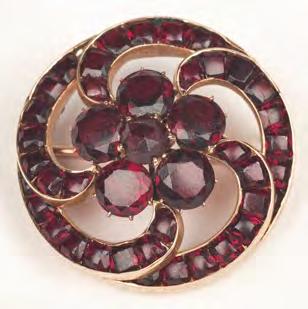
621* Garnet brooch. An Edwardian yellow metal brooch, set with a cluster of 5 garnets surrounded by 25 smaller garnets fashioned in 5 swirls, the yellow metal with open back and pierced rim, 25 mm diameter (1)
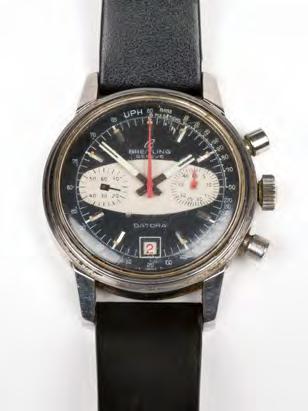
£150 - £200
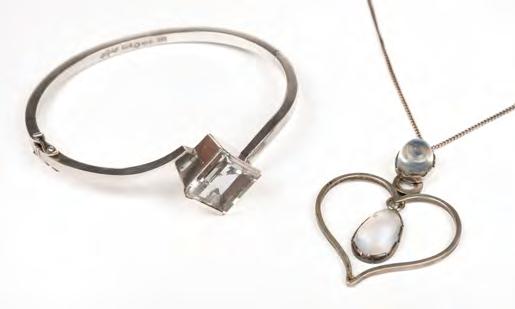
622* Scandinavian jewellery. A Swedish silver bangle by Stigbert, hallmarks for 1988, set with a square cut quartz stone 11 x 14 mm, the bangle measuring 60 mm across, together with a silver heart shape pendant by Kurt Jobst, set with two moonstones [?], 45 mm long, hanging on a fine silver chain (2)
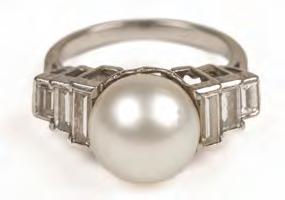
£150 - £200
624* Breitling Datora. A Breitling Datora 2031 stainless steel chronograph wristwatch circa 1969, serial number 1264152, black dial with white “surfboard”, calendar aperture, in good working order but glass scratched, 45 mm including winding crown, on a later black leather strap (1)
£700 - £1,000
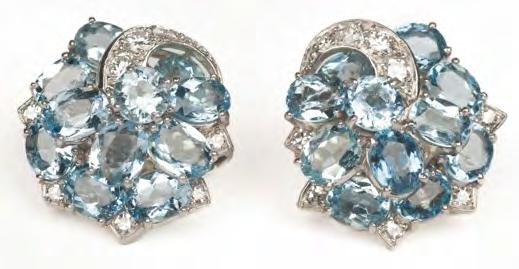
625* Earrings. A pair of platinum clip earrings, set with facet-cut aquamarine and diamond stones, set in an open back mount, 25 mm across, gross weight, 18.5g (1)
£700 - £1,000
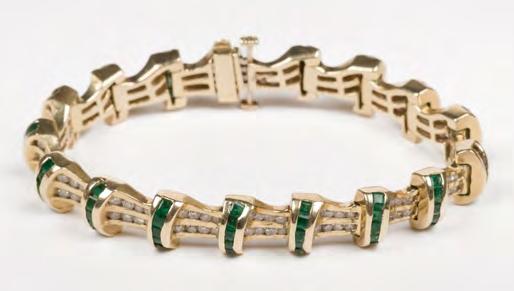
£600 - £800
623* Pearl ring. A platinum ring, set with a large pearl flanked by 3 graduated baguette cut diamonds, stamped ‘Plat’, size N, gross weight 8.8g (1)
626* Bracelet. A late 20th century yellow metal diamond and emerald link bracelet, box clasp with safety latch, with 2 emeralds missing, 18.5 cm, gross weight 33g (1)
£1,000 - £1,500
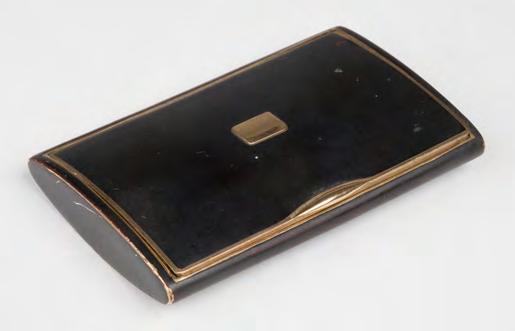
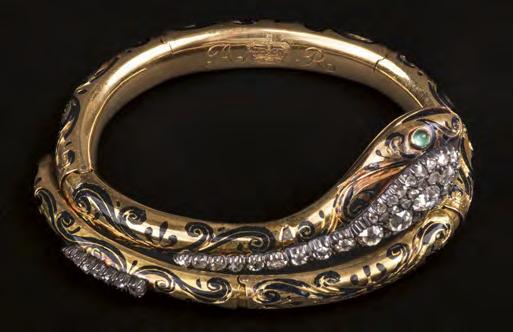
627* Gold snuff box. A continental 9ct gold snuff box, early 20th century, curved rectangular form with a burnished / applied finish throughout, the hinged lid with a vacant cartouche, enclosing gold interior, stamped 9 375 and with import stamps, small dents and wear, 8.5 x 5 cm, approximately 73g (1)
£1,500 - £2,000
628* Snake bracelet. An Edwardian articulated yellow metal bracelet formed as a snake, reputedly belonging to Queen Alexandra, its back inset with graduated old cut diamonds and emerald eyes, the hollow bracelet engraved with scrolls and infilled in black enamel, the inner band engraved with royal cypher, the initials ‘A’ and ‘R’ either side of a crown, 6 cm across (naturally furled), 37 grams
Provenance: By family repute, the property of Queen Alexandra (18441925), the wife of King Edward VII. The bracelet is believed to have been a gift from Queen Alexandra to her lady-in-waiting and subsequently gambled away by the lady’s husband during a game of cards. The bracelet has remained in the same family, being passed down from generation to generation. (1)
£3,000 - £5,000

629* Boucheron. A fine suite of enamel and diamond flower jewellery circa 1950, comprising, a pair of yellow and white metal clip on earrings, with red/pink guilloché enamel petals and brilliant cut diamond stamen, the hinged clip engraved ‘Boucheron’, no other markings, 25 mm diameter, with a similar brooch, this with an articulated revolving flower head and set with brilliant and baguette cut diamonds, some disclouration to the enamel, this piece is not engraved Boucheron and has no markings, 45 mm long, gross weight approximately 45.5g (3)
£5,000 - £7,000

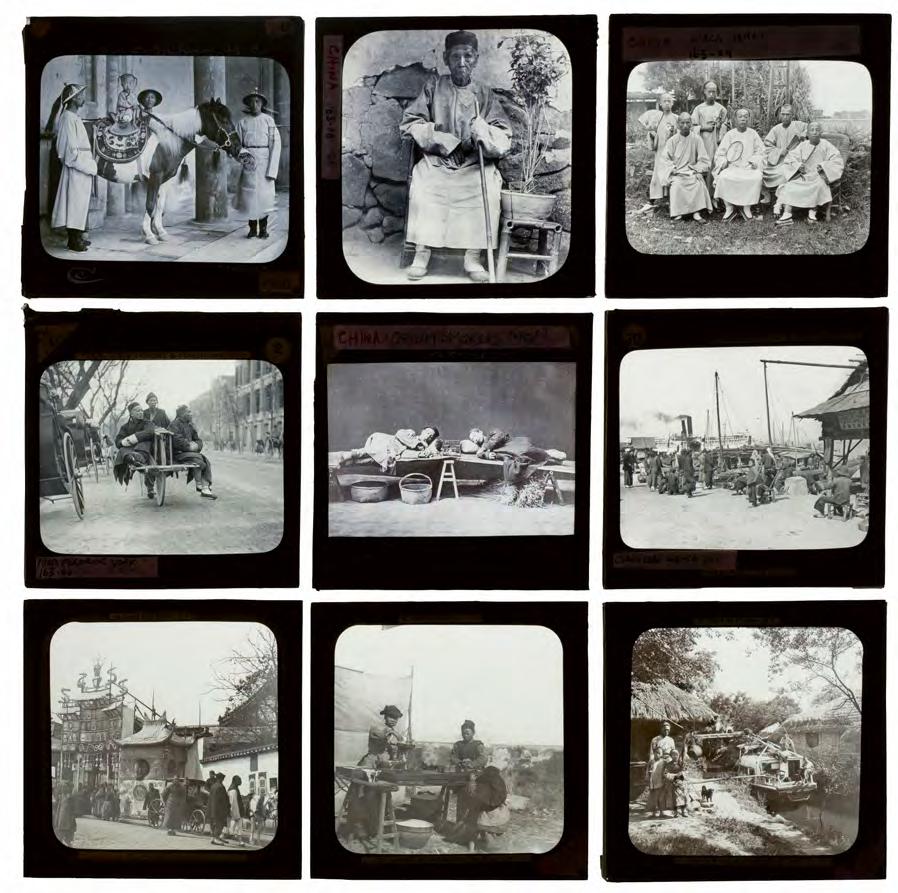
China. A group of 12 photographic lantern slides, c. 1890s/1900s, depicting people and scenes in China, many taken from lecture sets produced by James Valentine, York & Son, etc., printed labels and handwritten inscriptions, one featuring Emperor Puyi, aged 3, on a horse with attendants, (c. 1909), 85 x 85 mm
Estimate: £500-800*
For further information and to consign, please contact: Chris Albury | chris@dominicwinter.co.uk
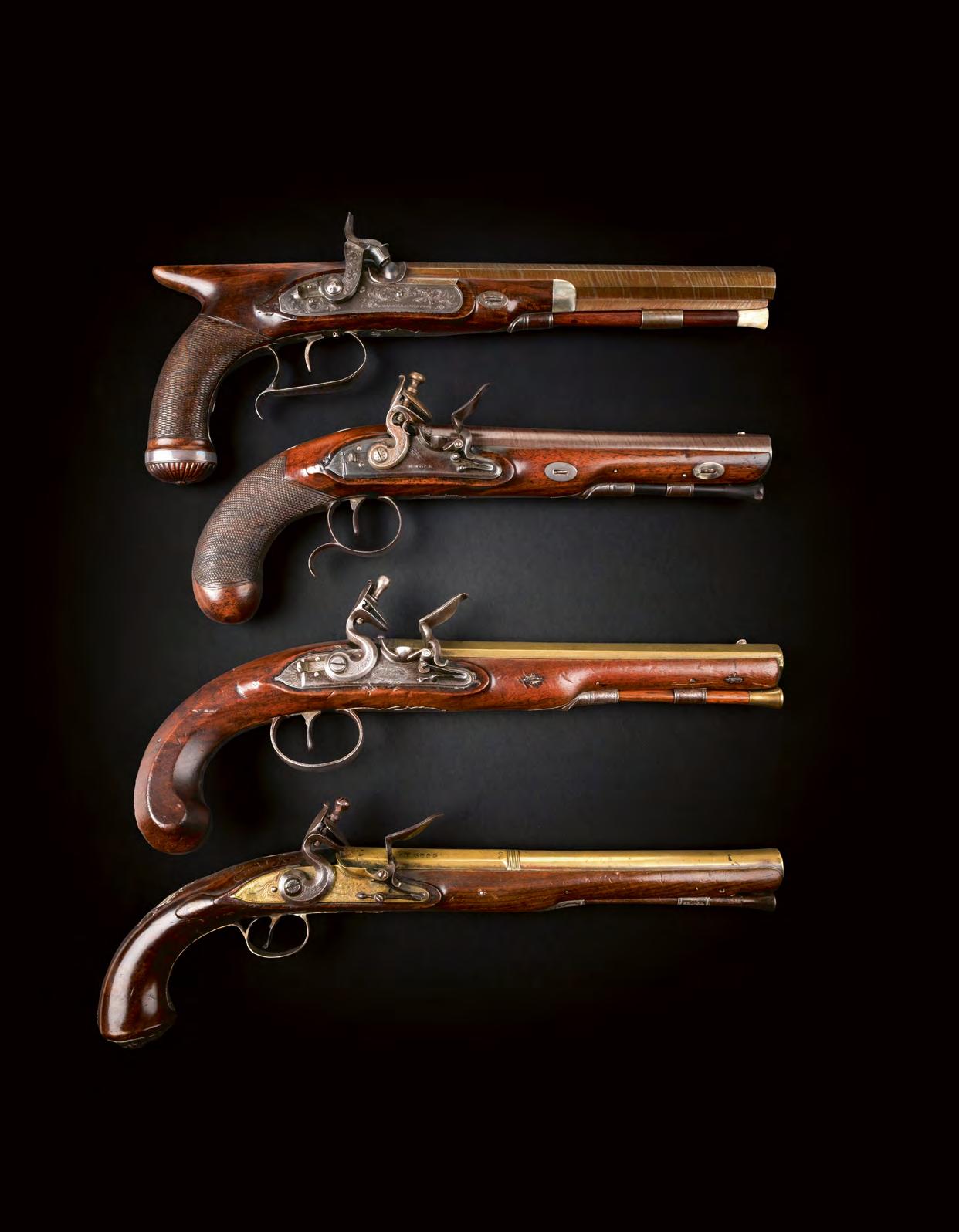
Online Results: If you weren’t present or able to follow the auction live, you can find results for the sale on our website shortly after the sale has ended.
Payment: The price you pay is the amount at which the auctioneer’s hammer falls (the hammer price), plus a buyer’s premium (a percentage of the final hammer price) and vat where applicable. You will be issued with an invoice made out to the name and address provided on your registration form.
Please note successful bids made via live bidding cannot be invoiced or paid for until the day after an auction. A live bidding fee of 3% + VAT (Dominic Winter / Invaluable) or 4.95% + VAT (the-saleroom) will be added to your invoice. Please note that as from January 2025 all successful Invaluable bids are now subject to a minimum charge of the UK equivalent of $10 per lot.
Cheque: Cheques will only be accepted on the day of the sale by prior arrangement (please contact our office for further information). Cheques by post will be accepted but a period of 5 working days will be required for the cheque to clear before purchases can be collected or posted.
Cash: Payments can be made at the Cashier’s Office, either during or after the sale.
Debit Card: There is no additional charge for purchases made with debit cards in the UK.
Credit Cards: We accept Visa and Mastercard. It is advisable to let your card provider know in advance if you are intending to purchase. This reduces the time needed to obtain authorisation when the payment is made.
Bank Transfer: All transfers must state the relevant invoice number. If transferring from a foreign currency, the amount we receive must be the total due after the currency conversion and the deduction of any bank charges.
Note to Overseas Clients: All payments must be made by bank transfer only. No card payments will be accepted unless by special prior arrangements with the auctioneers.
Collection/Postage/Delivery: If you attend the auction in person and are successful in your bid, you are free to collect your item once payment has been made.
Shipping: Successful commission or live bids will be invoiced to you the day after the sale. When it is possible for our in-house packing department to send your purchase(s), a charge for postage/packing/insurance will be included in your invoice. Where it is not possible for our in-house packing department to send we will recommend other shipping specialists.
London Deliveries: We provide a monthly delivery service to Central London only, usually on Wednesday of the week following an auction. Payment must be received before this option can be requested. A charge will be added to your invoice for this service.
Lots marked with AR next to the lot number may be subject to Droit de Suite.
Droit de Suite is payable on the hammer price of any artwork sold in the lifetime of the artist, or within 70 years of the artist's death. The buyer agrees to pay Dominic Winter Auctioneers Ltd an amount equal to the resale royalty and we will pay such amount to the artist's collecting agent. Resale royalty applies where the Hammer price is £1,000 or more.
The amount is calculated as follows:
Royalty For the Portion of the Hammer Price
4.00% up to £50,000
3.00% between £50,000.01 and £200,000
1.00% between £200,000.01 and £350,000
0.50% between £350,000.01 and £500,000
Please refer to the DACS website www.dacs.org.uk and the Artists’ Collecting Society website www.artistscollectingsociety.org for further details.
1. The Seller warrants to the Auctioneer and the buyer that he is the true owner or is properly authorised to sell the property by the true owner and is able to transfer good and marketable title to the property free from any third party claims.
2. (a) The highest bidder to be the buyer. If during the auction the Auctioneer considers that a dispute has arisen he has absolute authority to settle it or re-offer the lot. The Auctioneer may at his sole discretion determine the advance of bidding or refuse a bid, divide any lot, combine any two or more lots or withdraw any lot without prior notice.
(b) Where goods are bought at auction by a buyer who has entered into an agreement with another or others that the other or others (or some of them) shall abstain from bidding for the goods and the buyer or other party or one of the other parties is a dealer (as defined in the Auction Biddings Agreement Act 1927) the buyer warrants that the goods are bought bona fide on joint account.
3. The buyer shall pay the price at which a lot is knocked down by the Auctioneer to the buyer (“the hammer price”) together with a premium of 22% of the hammer price. Where the lot is marked by an asterisk the premium will be subject to VAT at 20% which under the Auctioneer’s Margin Scheme will form part of the buyer’s premium on our invoice and will not be separately identified (the premium added to the hammer price will hereafter collectively be referred to as “the total sum due”). By making any bid the buyer acknowledges that his attention has been drawn to the fact that on the sale of any lot the Auctioneer will receive from the seller commission at its usual rates in addition to the said premium of 22% and assents to the Auctioneer receiving the said commission.
4. (a) The buyer shall forthwith upon the purchase give in his name and permanent address and pay to the Auctioneer immediately after the conclusion of the auction the total sum due.
(b) The buyer may be required to pay down during the course of the sale the whole or any part of the total sum due, and if he fails to do so after such request the lot or lots may at the Auctioneer's absolute discretion be put up again and resold immediately.
(c) The buyer shall at his own expense take away any lot or lots purchased no later than five working days after the auction day.
(d) The Auctioneer may at his own discretion agree credit terms with a buyer and extend the time limits for collection in special cases but otherwise payment shall be deemed to have been made only after the Auctioneer has received cash or a sterling banker’s draft or the buyer's cheque has been cleared.
5. (a) If the buyer fails to pay for or take away any lot or lots pursuant to clause 4 or breaches any other condition of that clause the Auctioneer as agent for the seller shall be entitled after consultation with the seller to exercise one or other of the following rights:
(i) Rescind the sale of that or any other lots sold to the buyer who defaults and re-sell the lot or lots whereupon the defaulting buyer shall pay to the Auctioneer any shortfall between the proceeds of that sale after deduction of costs of re-sale and the total sum due. Any surplus shall belong to the seller.
(ii) Proceed for damages for breach of contract.
(b) Without prejudice to the Auctioneer's rights hereunder if any lots or lots are not collected within five days or such longer period as the Auctioneer may have agreed otherwise, the Auctioneer may charge the buyer a storage charge of £1.00 + VAT at the current rate per lot per day.
(c) Ownership of the lot purchased shall not pass to the buyer until he has paid to the Auctioneer the total sum due.
6. (a) The seller shall be entitled to place a reserve on any lot and the Auctioneer shall have the right to bid on behalf of the seller for any lot on which a reserve has been placed. A seller may not bid on any lot on which a reserve has been placed.
(b) Where any lot fails to sell, the Auctioneer shall notify the seller accordingly. The seller shall make arrangements either to re-offer the lot for sale or to collect the lot and may be asked to pay a commission not exceeding 50% of the selling commission and any special expenses incurred in cataloguing the lot.
(c) If such arrangements are not made within seven days of the notification the Auctioneer is empowered to sell the lot by auction or by private treaty at not less than the reserve price and to receive from the seller the normal selling commission and special expenses.
7. Any representation or statement by the Auctioneer in any catalogue, brochure or advertisement of forthcoming sales as to authorship, attribution, genuineness, origin, date, age, provenance, condition or estimated selling price is a statement of opinion only. Every person interested should exercise and rely on his own judgement as to such matters and neither the Auctioneer nor his servants or agents are responsible for the correctness of such opinions. No warranty whatsoever is given by the Auctioneer or the seller in respect of any lot and any express or implied warranties are hereby excluded.
8. (a) Notwithstanding any other terms of these conditions, if within fourteen days of the sale the Auctioneer has received from the buyer of any lot notice in writing that in his view the lot is a deliberate forgery and within fourteen days after such notification the buyer returns the same to the Auctioneer in the same condition as at the time of the sale and satisfies the Auctioneer that considered in the light of the entry in the catalogue the lot is a deliberate forgery then the sale of the lot will be rescinded and the purchase price of the same refunded. "A deliberate forgery" means a lot made with intention to deceive. (b) A buyer's claim under this condition shall be limited to any amount paid to the Auctioneer for the lot and for the purpose of this condition the buyer shall be the person to whom the original invoice was made out by the Auctioneer.
9. Lots may be removed during the sale after full settlement in accordance with 4(d) hereof.
10. All goods delivered to the Auctioneer's premises will be deemed to be delivered for sale by auction unless otherwise stated in writing and will be catalogued and sold at the Auctioneer's discretion and accepted by the Auctioneer subject to all these conditions. In the case of miscellaneous books, the Auctioneer reserves the right to extract and dispose of books that, in the opinion of the Auctioneer at his absolute discretion, have no saleable value and, therefore, might detract from the saleability of the rest of the lot and the Auctioneer shall incur no liability to the seller, in respect of the books disposed of. By delivering the goods to theAuctioneer for inclusion in his auction sales each seller acknowledges that he/she accepts and agrees to all the conditions.
11. (a) Unless otherwise instructed in writing all goods on the Auctioneer's premises and in their custody will be held insured against the risks of fire, burglary, water damage and accidental breakage or damage. The value of the goods so covered will be the hammer price, or in the case of unsold lots the lower estimate, or in the case of loss or damage prior to the sale that which the specialised staff of the Auctioneer shall in their absolute discretion estimate to be the auction value of such goods.
(b) The Auctioneer shall not be responsible for damage to or the loss, theft, or destruction of any goods not so insured because of the owner’s written instructions.
12. The Auctioneer shall remit the proceeds of the sale to the seller thirty days after the day of the auction provided that the Auctioneer has received the total sum due from the buyer. In all other cases the Auctioneer will remit the proceeds of the sale to the seller within seven days of the receipt by the Auctioneer of the total sum due. The Auctioneer will not be deemed to have received the total sum due until after any cheque delivered by the buyer has been cleared. In the event of the Auctioneer exercising his right to rescind the sale his obligation to the seller hereunder lapses.
13. In the case of the seller withdrawing instructions to the Auctioneer to sell any lot or lots, the Auctioneer may charge a fee of 12.5% of the Auctioneer's middle estimate of the auction price of the lot withdrawn together with Value Added Tax thereon and any expenses incurred in respect of the lot or lots.
14. The Auctioneer’s current standard notices and information (i.e. Collation and Amendments) will apply to any contract with the Auctioneer as if incorporated herein.
15. These conditions shall be governed by and construed in accordance with English Law.

An exceptional copy of the rare 1st privately printed edition of The Tale of Peter Rabbit, by Beatrix Potter, [London: Strangeways, December 1901], One of 250 copies of the first issue.
Estimate £40,000-£60,000
For further information please contact Susanna Winters and Helen Pedder susanna@dominicwinter.co.uk helen@dominicwinter.co.uk
